Impact of Hofstede Cultural Dimensions on Profitability of Hilton Hotel
VerifiedAdded on 2023/04/21
|46
|11796
|161
AI Summary
This research aims to investigate the impact of Hofstede's cultural dimensions on the profitability of Hilton Hotel. It will analyze how cultural dimensions of employee behavior, such as power distance, individualism, masculinity, uncertainty avoidance, and long-term orientation, affect the profitability of the hotel. The study will provide recommendations for improving employee behavior to ensure profitability.
Contribute Materials
Your contribution can guide someone’s learning journey. Share your
documents today.
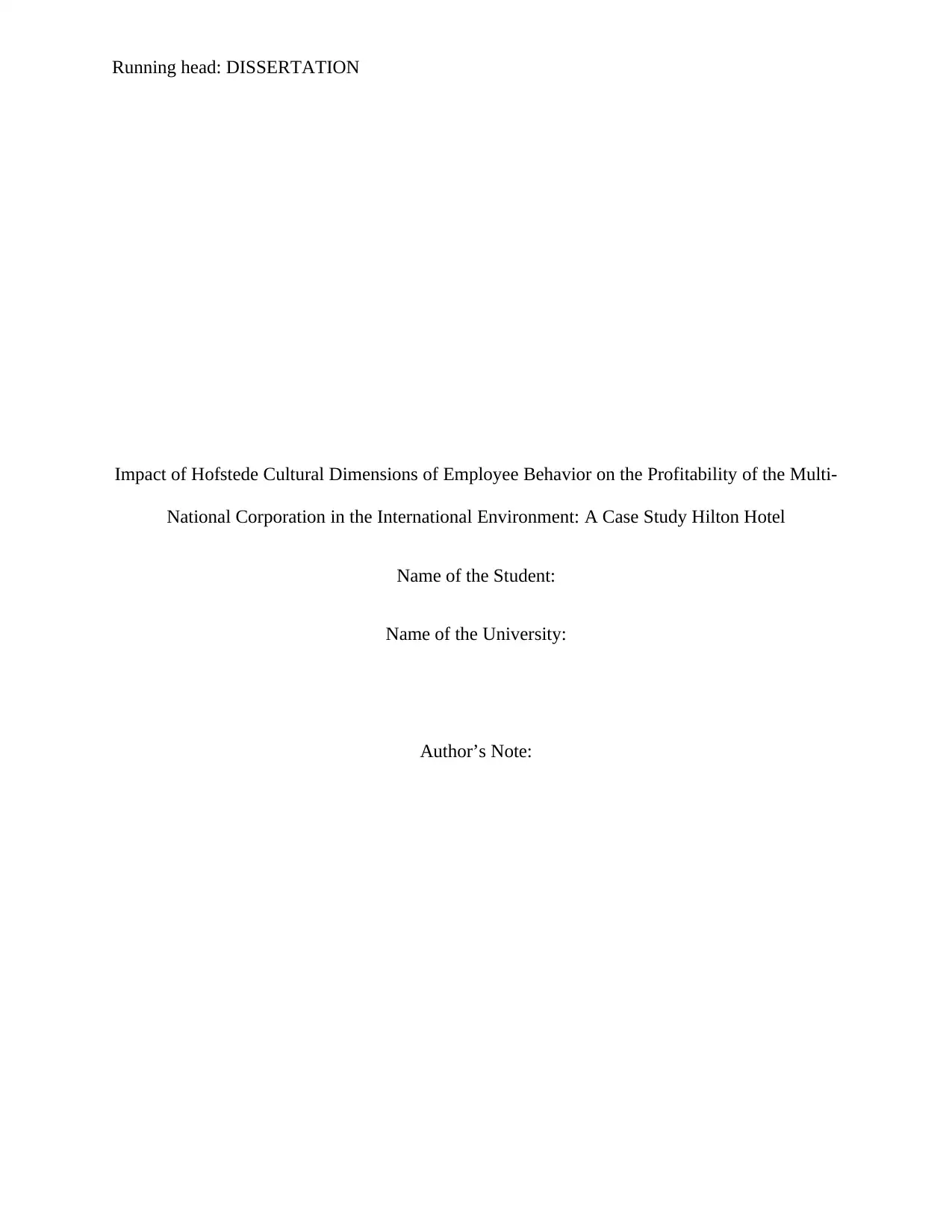
Running head: DISSERTATION
Impact of Hofstede Cultural Dimensions of Employee Behavior on the Profitability of the Multi-
National Corporation in the International Environment: A Case Study Hilton Hotel
Name of the Student:
Name of the University:
Author’s Note:
Impact of Hofstede Cultural Dimensions of Employee Behavior on the Profitability of the Multi-
National Corporation in the International Environment: A Case Study Hilton Hotel
Name of the Student:
Name of the University:
Author’s Note:
Secure Best Marks with AI Grader
Need help grading? Try our AI Grader for instant feedback on your assignments.

1DISSERTATION
Acknowledgement
Thank you to all of those who have helped listened and encouraged me throughout this study. I
am indebted to my supervisor ……………………. whose guidance, advice and patience have
been immeasurable. My sincere thanks to all members of the…………… [Mention your
university/college name], both staff and students, whose continuous support have made this
thesis possible.
I would like to thank all of the participants in the study: students, teachers and Local Education
Authorities, for the time and help given throughout. Without their participation, this research
would not have been possible. In this context, I am also thankful to them, whose research work
helped me to execute this paper well.
Finally, I thank my family, without whom this thesis would not have been started or completed!
Your encouragement and support have never faltered; thank you.
Acknowledgement
Thank you to all of those who have helped listened and encouraged me throughout this study. I
am indebted to my supervisor ……………………. whose guidance, advice and patience have
been immeasurable. My sincere thanks to all members of the…………… [Mention your
university/college name], both staff and students, whose continuous support have made this
thesis possible.
I would like to thank all of the participants in the study: students, teachers and Local Education
Authorities, for the time and help given throughout. Without their participation, this research
would not have been possible. In this context, I am also thankful to them, whose research work
helped me to execute this paper well.
Finally, I thank my family, without whom this thesis would not have been started or completed!
Your encouragement and support have never faltered; thank you.

2DISSERTATION
Abstract
The workplace is the most diversified place that comprises of employees from different religious
and cultural background. In addition to, hospitality industry has employees from different
cultures that highly influences the way each employee communicates with the fellow employees
and provide service to the customers visiting their hotel. The aim of the research is to investigate
how cultural dimensions of the employee behavior impact on the profitability of the multi-
national corporation such as Hilton Hotel in the international environment. The cultural
dimensions of employee behavior include power distance, individualism versus collectivism, and
masculinity versus femininity, uncertainty avoidance index and long-term orientation versus
short-term orientation. As business is becoming highly global, cultures around the world are
getting more and more interconnected. In the case of Hotel Hilton, this suggests that the
managers will have to work with employees having different cultural background. Such strong
connection with their respective cultures, they often fail to see how culture affects their behavior
and thinking pattern. In order to understand and study the difference in thinking and behavior
pattern, Hofstede’s cultural dimension is considered as a significant tool and mechanism that
helps in comparing and contrasting the cultural differences and similarities in respect to the
employees. Hofstede’s cultural dimension is said to have an impact on the belief of power
inequality among the existing employees, individual image of the employees and gender
discrimination among the employees due to which the behavior of the employees take a troll and
the organizational profitability is questioned. For the gathering of data, secondary data collection
process will be used, and the themes will be analyzed by considering information of different
secondary resources such as journals, articles and internet facilities. This research will also help
in shedding light on the potential issues the employees face due to cultural dimension at
Abstract
The workplace is the most diversified place that comprises of employees from different religious
and cultural background. In addition to, hospitality industry has employees from different
cultures that highly influences the way each employee communicates with the fellow employees
and provide service to the customers visiting their hotel. The aim of the research is to investigate
how cultural dimensions of the employee behavior impact on the profitability of the multi-
national corporation such as Hilton Hotel in the international environment. The cultural
dimensions of employee behavior include power distance, individualism versus collectivism, and
masculinity versus femininity, uncertainty avoidance index and long-term orientation versus
short-term orientation. As business is becoming highly global, cultures around the world are
getting more and more interconnected. In the case of Hotel Hilton, this suggests that the
managers will have to work with employees having different cultural background. Such strong
connection with their respective cultures, they often fail to see how culture affects their behavior
and thinking pattern. In order to understand and study the difference in thinking and behavior
pattern, Hofstede’s cultural dimension is considered as a significant tool and mechanism that
helps in comparing and contrasting the cultural differences and similarities in respect to the
employees. Hofstede’s cultural dimension is said to have an impact on the belief of power
inequality among the existing employees, individual image of the employees and gender
discrimination among the employees due to which the behavior of the employees take a troll and
the organizational profitability is questioned. For the gathering of data, secondary data collection
process will be used, and the themes will be analyzed by considering information of different
secondary resources such as journals, articles and internet facilities. This research will also help
in shedding light on the potential issues the employees face due to cultural dimension at
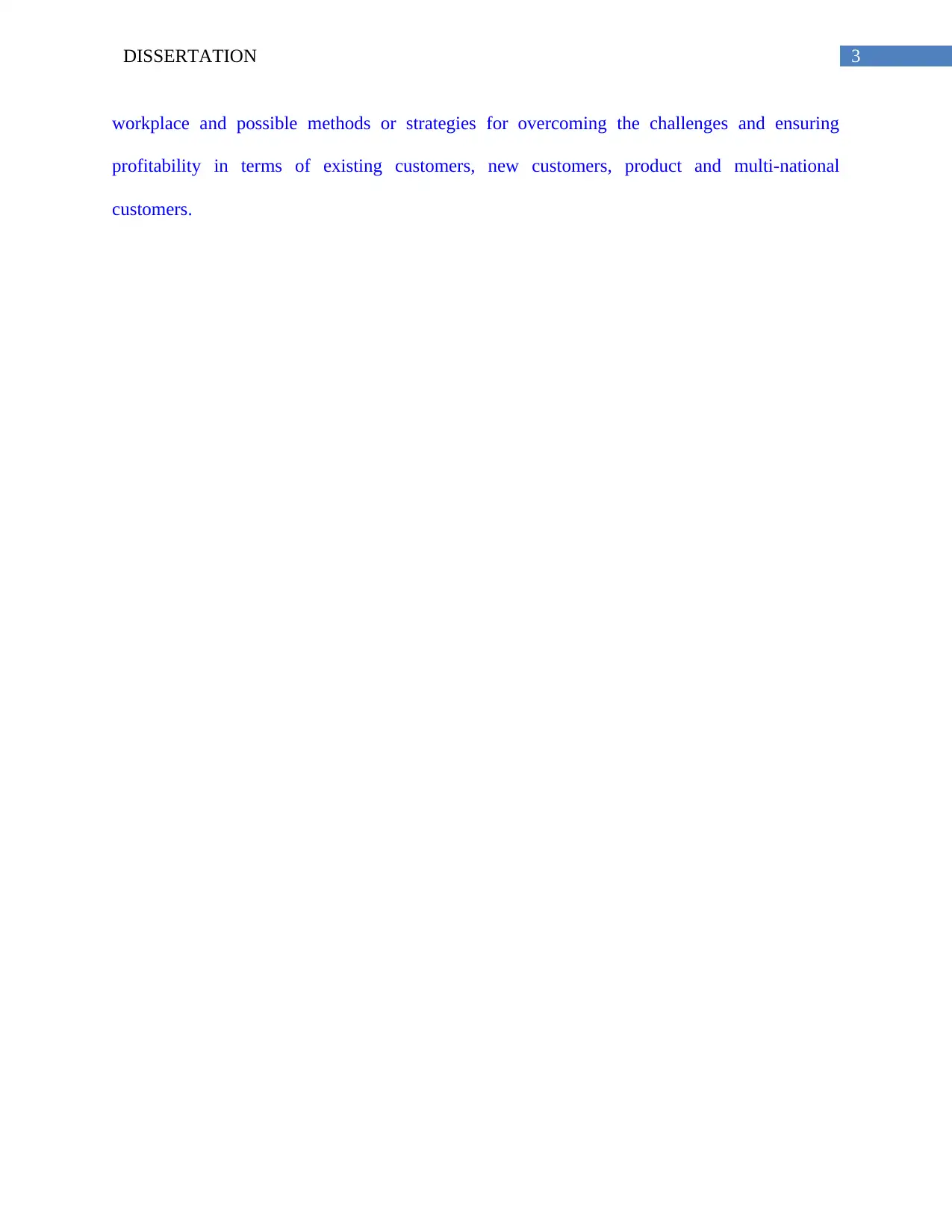
3DISSERTATION
workplace and possible methods or strategies for overcoming the challenges and ensuring
profitability in terms of existing customers, new customers, product and multi-national
customers.
workplace and possible methods or strategies for overcoming the challenges and ensuring
profitability in terms of existing customers, new customers, product and multi-national
customers.
Secure Best Marks with AI Grader
Need help grading? Try our AI Grader for instant feedback on your assignments.
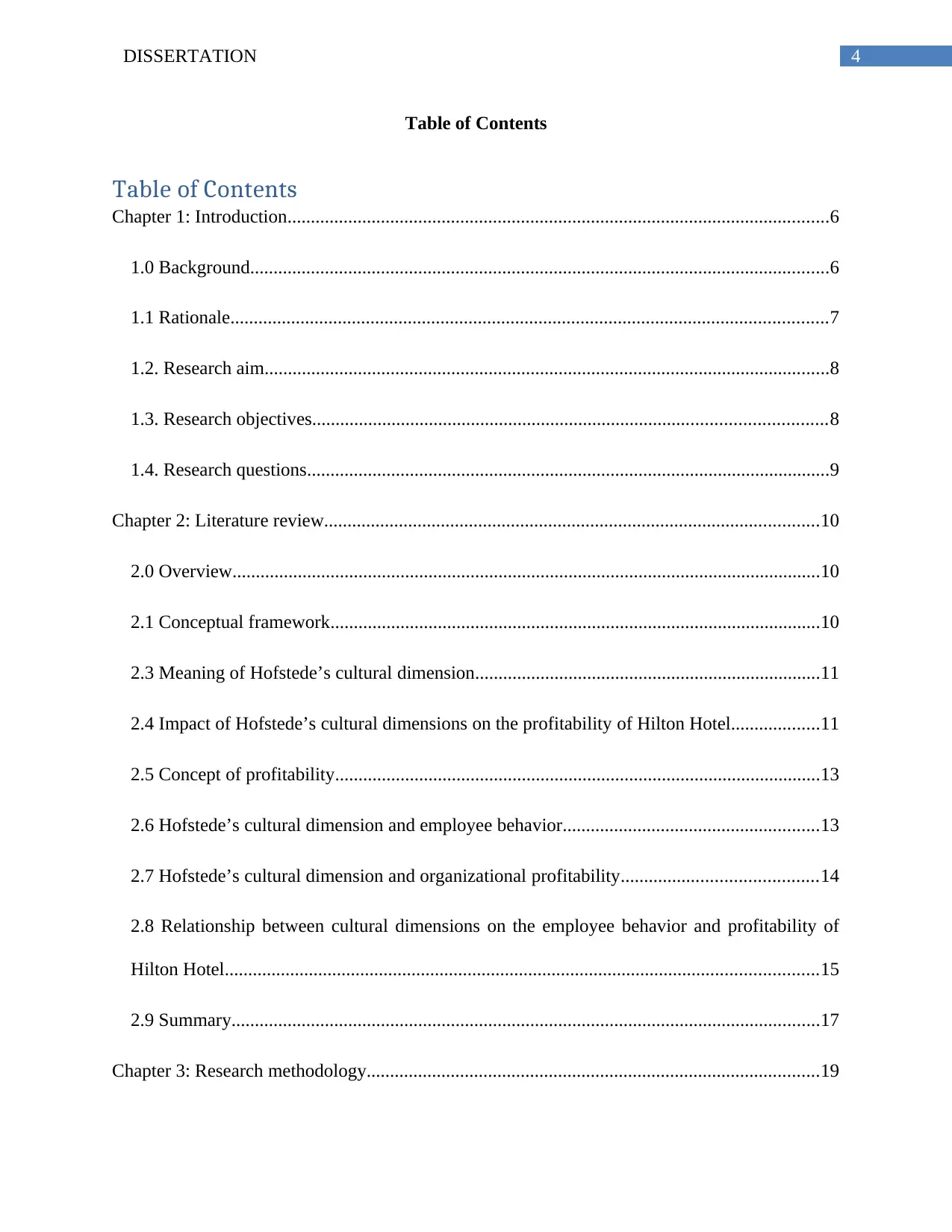
4DISSERTATION
Table of Contents
Table of Contents
Chapter 1: Introduction....................................................................................................................6
1.0 Background............................................................................................................................6
1.1 Rationale................................................................................................................................7
1.2. Research aim.........................................................................................................................8
1.3. Research objectives..............................................................................................................8
1.4. Research questions................................................................................................................9
Chapter 2: Literature review..........................................................................................................10
2.0 Overview..............................................................................................................................10
2.1 Conceptual framework.........................................................................................................10
2.3 Meaning of Hofstede’s cultural dimension..........................................................................11
2.4 Impact of Hofstede’s cultural dimensions on the profitability of Hilton Hotel...................11
2.5 Concept of profitability........................................................................................................13
2.6 Hofstede’s cultural dimension and employee behavior.......................................................13
2.7 Hofstede’s cultural dimension and organizational profitability..........................................14
2.8 Relationship between cultural dimensions on the employee behavior and profitability of
Hilton Hotel...............................................................................................................................15
2.9 Summary..............................................................................................................................17
Chapter 3: Research methodology.................................................................................................19
Table of Contents
Table of Contents
Chapter 1: Introduction....................................................................................................................6
1.0 Background............................................................................................................................6
1.1 Rationale................................................................................................................................7
1.2. Research aim.........................................................................................................................8
1.3. Research objectives..............................................................................................................8
1.4. Research questions................................................................................................................9
Chapter 2: Literature review..........................................................................................................10
2.0 Overview..............................................................................................................................10
2.1 Conceptual framework.........................................................................................................10
2.3 Meaning of Hofstede’s cultural dimension..........................................................................11
2.4 Impact of Hofstede’s cultural dimensions on the profitability of Hilton Hotel...................11
2.5 Concept of profitability........................................................................................................13
2.6 Hofstede’s cultural dimension and employee behavior.......................................................13
2.7 Hofstede’s cultural dimension and organizational profitability..........................................14
2.8 Relationship between cultural dimensions on the employee behavior and profitability of
Hilton Hotel...............................................................................................................................15
2.9 Summary..............................................................................................................................17
Chapter 3: Research methodology.................................................................................................19
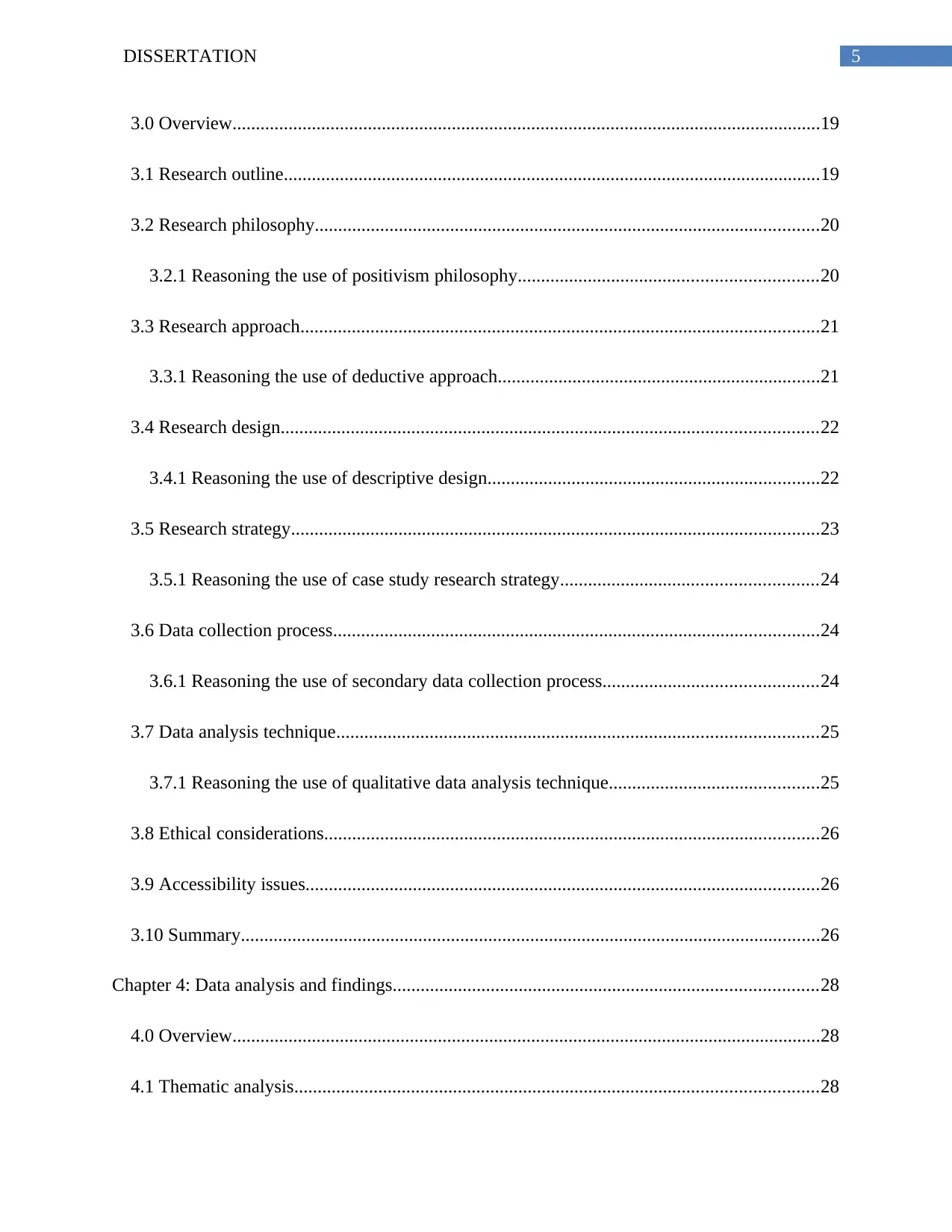
5DISSERTATION
3.0 Overview..............................................................................................................................19
3.1 Research outline...................................................................................................................19
3.2 Research philosophy............................................................................................................20
3.2.1 Reasoning the use of positivism philosophy................................................................20
3.3 Research approach...............................................................................................................21
3.3.1 Reasoning the use of deductive approach.....................................................................21
3.4 Research design...................................................................................................................22
3.4.1 Reasoning the use of descriptive design.......................................................................22
3.5 Research strategy.................................................................................................................23
3.5.1 Reasoning the use of case study research strategy.......................................................24
3.6 Data collection process........................................................................................................24
3.6.1 Reasoning the use of secondary data collection process..............................................24
3.7 Data analysis technique.......................................................................................................25
3.7.1 Reasoning the use of qualitative data analysis technique.............................................25
3.8 Ethical considerations..........................................................................................................26
3.9 Accessibility issues..............................................................................................................26
3.10 Summary............................................................................................................................26
Chapter 4: Data analysis and findings...........................................................................................28
4.0 Overview..............................................................................................................................28
4.1 Thematic analysis................................................................................................................28
3.0 Overview..............................................................................................................................19
3.1 Research outline...................................................................................................................19
3.2 Research philosophy............................................................................................................20
3.2.1 Reasoning the use of positivism philosophy................................................................20
3.3 Research approach...............................................................................................................21
3.3.1 Reasoning the use of deductive approach.....................................................................21
3.4 Research design...................................................................................................................22
3.4.1 Reasoning the use of descriptive design.......................................................................22
3.5 Research strategy.................................................................................................................23
3.5.1 Reasoning the use of case study research strategy.......................................................24
3.6 Data collection process........................................................................................................24
3.6.1 Reasoning the use of secondary data collection process..............................................24
3.7 Data analysis technique.......................................................................................................25
3.7.1 Reasoning the use of qualitative data analysis technique.............................................25
3.8 Ethical considerations..........................................................................................................26
3.9 Accessibility issues..............................................................................................................26
3.10 Summary............................................................................................................................26
Chapter 4: Data analysis and findings...........................................................................................28
4.0 Overview..............................................................................................................................28
4.1 Thematic analysis................................................................................................................28
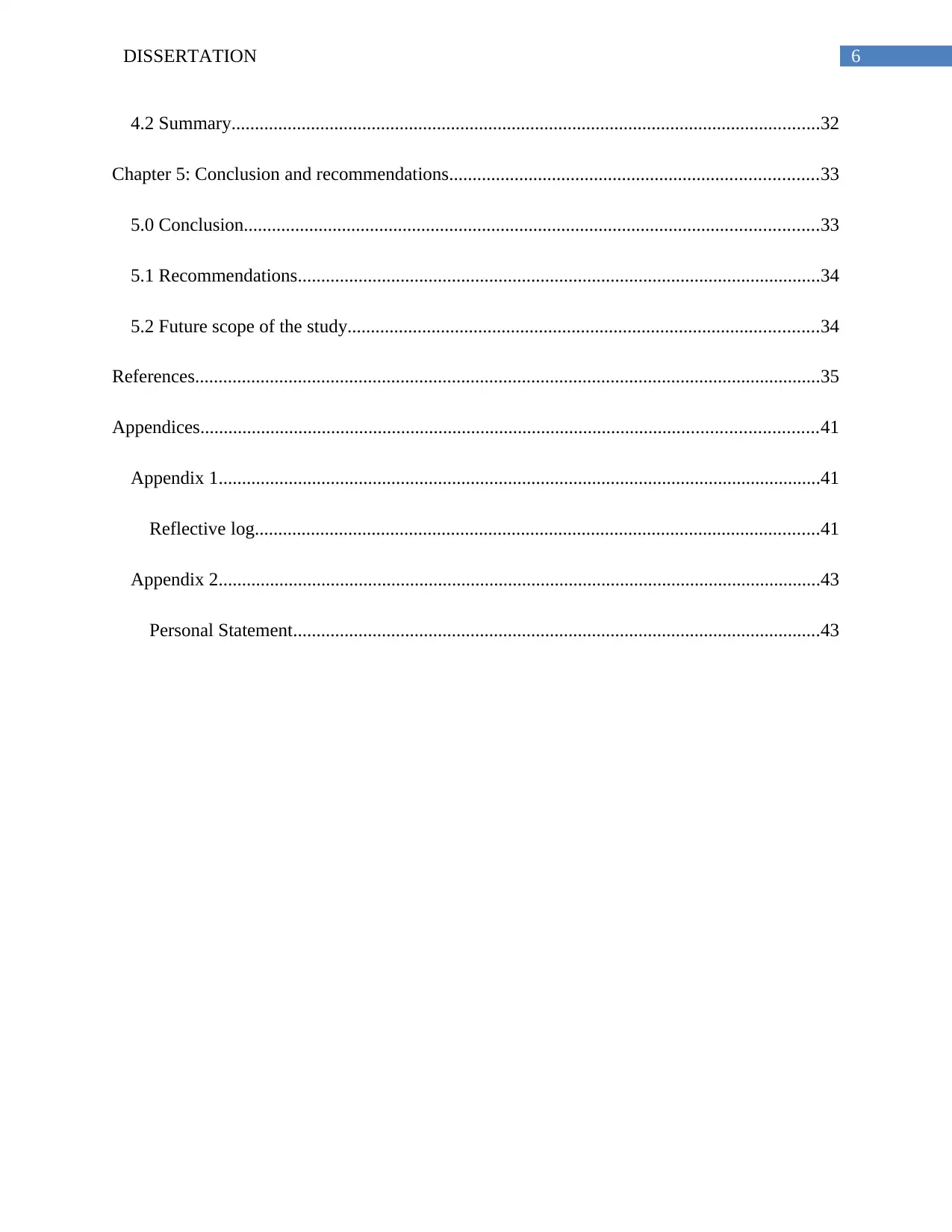
6DISSERTATION
4.2 Summary..............................................................................................................................32
Chapter 5: Conclusion and recommendations...............................................................................33
5.0 Conclusion...........................................................................................................................33
5.1 Recommendations................................................................................................................34
5.2 Future scope of the study.....................................................................................................34
References......................................................................................................................................35
Appendices....................................................................................................................................41
Appendix 1.................................................................................................................................41
Reflective log.........................................................................................................................41
Appendix 2.................................................................................................................................43
Personal Statement.................................................................................................................43
4.2 Summary..............................................................................................................................32
Chapter 5: Conclusion and recommendations...............................................................................33
5.0 Conclusion...........................................................................................................................33
5.1 Recommendations................................................................................................................34
5.2 Future scope of the study.....................................................................................................34
References......................................................................................................................................35
Appendices....................................................................................................................................41
Appendix 1.................................................................................................................................41
Reflective log.........................................................................................................................41
Appendix 2.................................................................................................................................43
Personal Statement.................................................................................................................43
Paraphrase This Document
Need a fresh take? Get an instant paraphrase of this document with our AI Paraphraser
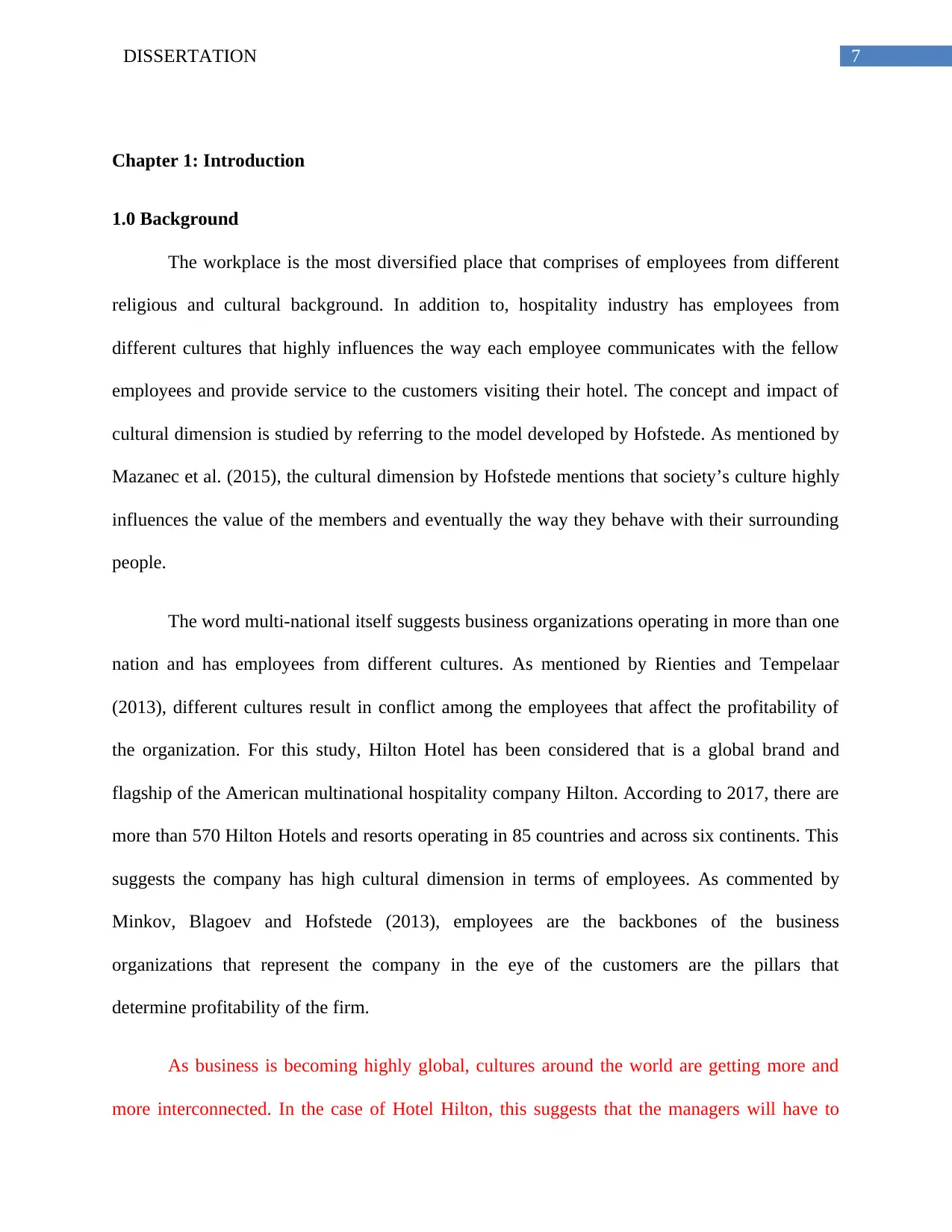
7DISSERTATION
Chapter 1: Introduction
1.0 Background
The workplace is the most diversified place that comprises of employees from different
religious and cultural background. In addition to, hospitality industry has employees from
different cultures that highly influences the way each employee communicates with the fellow
employees and provide service to the customers visiting their hotel. The concept and impact of
cultural dimension is studied by referring to the model developed by Hofstede. As mentioned by
Mazanec et al. (2015), the cultural dimension by Hofstede mentions that society’s culture highly
influences the value of the members and eventually the way they behave with their surrounding
people.
The word multi-national itself suggests business organizations operating in more than one
nation and has employees from different cultures. As mentioned by Rienties and Tempelaar
(2013), different cultures result in conflict among the employees that affect the profitability of
the organization. For this study, Hilton Hotel has been considered that is a global brand and
flagship of the American multinational hospitality company Hilton. According to 2017, there are
more than 570 Hilton Hotels and resorts operating in 85 countries and across six continents. This
suggests the company has high cultural dimension in terms of employees. As commented by
Minkov, Blagoev and Hofstede (2013), employees are the backbones of the business
organizations that represent the company in the eye of the customers are the pillars that
determine profitability of the firm.
As business is becoming highly global, cultures around the world are getting more and
more interconnected. In the case of Hotel Hilton, this suggests that the managers will have to
Chapter 1: Introduction
1.0 Background
The workplace is the most diversified place that comprises of employees from different
religious and cultural background. In addition to, hospitality industry has employees from
different cultures that highly influences the way each employee communicates with the fellow
employees and provide service to the customers visiting their hotel. The concept and impact of
cultural dimension is studied by referring to the model developed by Hofstede. As mentioned by
Mazanec et al. (2015), the cultural dimension by Hofstede mentions that society’s culture highly
influences the value of the members and eventually the way they behave with their surrounding
people.
The word multi-national itself suggests business organizations operating in more than one
nation and has employees from different cultures. As mentioned by Rienties and Tempelaar
(2013), different cultures result in conflict among the employees that affect the profitability of
the organization. For this study, Hilton Hotel has been considered that is a global brand and
flagship of the American multinational hospitality company Hilton. According to 2017, there are
more than 570 Hilton Hotels and resorts operating in 85 countries and across six continents. This
suggests the company has high cultural dimension in terms of employees. As commented by
Minkov, Blagoev and Hofstede (2013), employees are the backbones of the business
organizations that represent the company in the eye of the customers are the pillars that
determine profitability of the firm.
As business is becoming highly global, cultures around the world are getting more and
more interconnected. In the case of Hotel Hilton, this suggests that the managers will have to

8DISSERTATION
work with employees having different cultural background. Such strong connection with their
respective cultures, they often fail to see how culture affects their behavior and thinking pattern.
In order to understand and study the difference in thinking and behavior pattern, Hofstede’s
cultural dimension is considered as a significant tool and mechanism that helps in comparing and
contrasting the cultural differences and similarities in respect to the employees. Hofstede’s
cultural dimension is said to have an impact on the belief of power inequality among the existing
employees, individual image of the employees and gender discrimination among the employees
due to which the behavior of the employees take a troll and the organizational profitability is
questioned.
1.1 Rationale
Cultural dimension is a large concept that is widely studied by various researchers by the
impact of cultural dimension on profitability of a multi-national company is not widely studied.
This study will help in understanding the wide concept of cultural dimension by referring to
Hofstede’s cultural dimension. In addition, to this research will also help in understanding how
cultural dimension, have an impact on the behavior of the employees while working as a team or
independently. Moreover, this research will also help in shedding light on the potential issues the
employees face due to cultural dimension at workplace and possible methods or strategies for
overcoming the challenges and ensuring profitability in terms of existing customers, new
customers, product and multi-national customers (Venaik and Brewer 2013).
As known, Hotel Hilton is a multinational corporation that operates in different countries.
Analyzing the impact of Hofstede’s cultural dimension will help in understanding the impact of
different cultures on the behavior of the employees working in the hotel. Undertaking the
research is justified because this will help in assessing the relationship between cultural
work with employees having different cultural background. Such strong connection with their
respective cultures, they often fail to see how culture affects their behavior and thinking pattern.
In order to understand and study the difference in thinking and behavior pattern, Hofstede’s
cultural dimension is considered as a significant tool and mechanism that helps in comparing and
contrasting the cultural differences and similarities in respect to the employees. Hofstede’s
cultural dimension is said to have an impact on the belief of power inequality among the existing
employees, individual image of the employees and gender discrimination among the employees
due to which the behavior of the employees take a troll and the organizational profitability is
questioned.
1.1 Rationale
Cultural dimension is a large concept that is widely studied by various researchers by the
impact of cultural dimension on profitability of a multi-national company is not widely studied.
This study will help in understanding the wide concept of cultural dimension by referring to
Hofstede’s cultural dimension. In addition, to this research will also help in understanding how
cultural dimension, have an impact on the behavior of the employees while working as a team or
independently. Moreover, this research will also help in shedding light on the potential issues the
employees face due to cultural dimension at workplace and possible methods or strategies for
overcoming the challenges and ensuring profitability in terms of existing customers, new
customers, product and multi-national customers (Venaik and Brewer 2013).
As known, Hotel Hilton is a multinational corporation that operates in different countries.
Analyzing the impact of Hofstede’s cultural dimension will help in understanding the impact of
different cultures on the behavior of the employees working in the hotel. Undertaking the
research is justified because this will help in assessing the relationship between cultural
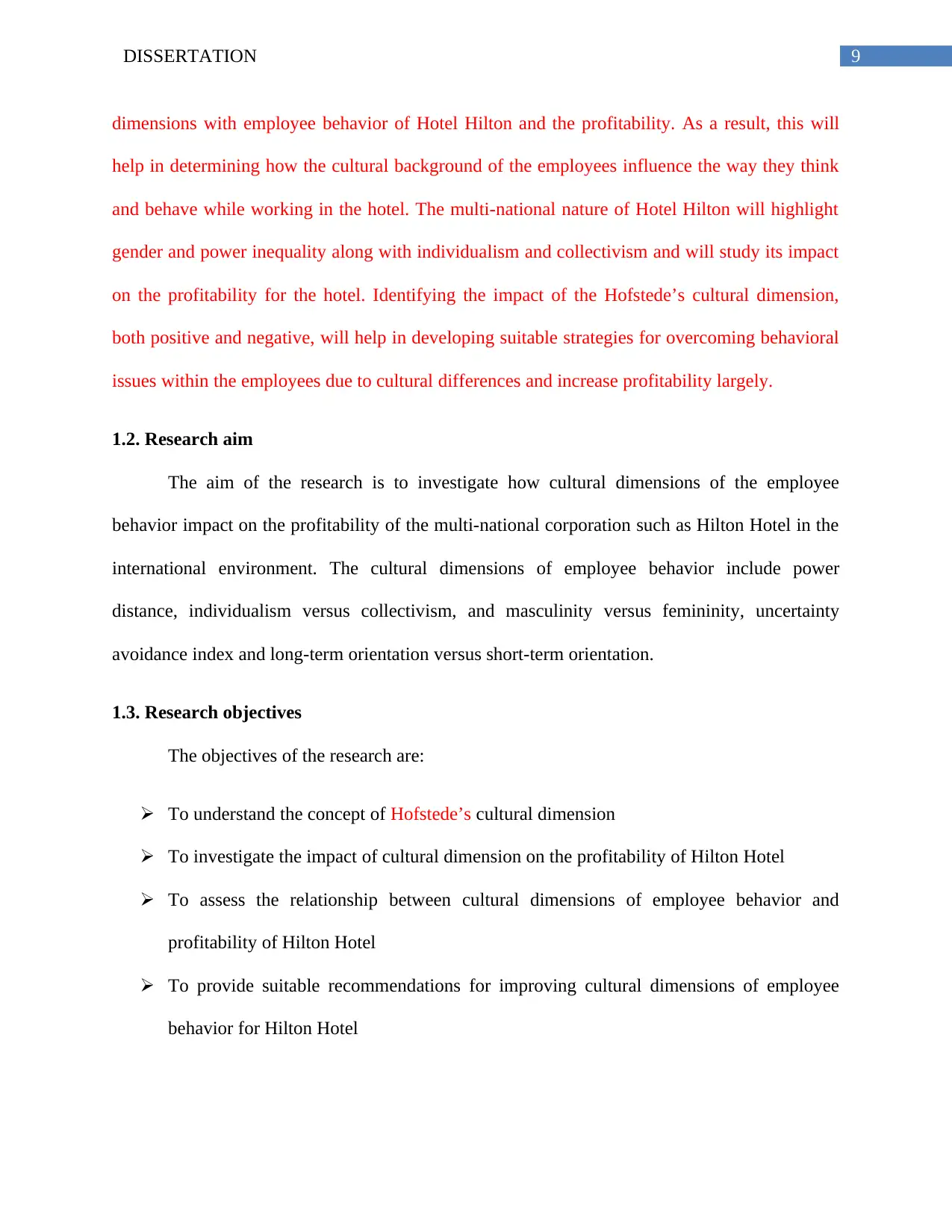
9DISSERTATION
dimensions with employee behavior of Hotel Hilton and the profitability. As a result, this will
help in determining how the cultural background of the employees influence the way they think
and behave while working in the hotel. The multi-national nature of Hotel Hilton will highlight
gender and power inequality along with individualism and collectivism and will study its impact
on the profitability for the hotel. Identifying the impact of the Hofstede’s cultural dimension,
both positive and negative, will help in developing suitable strategies for overcoming behavioral
issues within the employees due to cultural differences and increase profitability largely.
1.2. Research aim
The aim of the research is to investigate how cultural dimensions of the employee
behavior impact on the profitability of the multi-national corporation such as Hilton Hotel in the
international environment. The cultural dimensions of employee behavior include power
distance, individualism versus collectivism, and masculinity versus femininity, uncertainty
avoidance index and long-term orientation versus short-term orientation.
1.3. Research objectives
The objectives of the research are:
To understand the concept of Hofstede’s cultural dimension
To investigate the impact of cultural dimension on the profitability of Hilton Hotel
To assess the relationship between cultural dimensions of employee behavior and
profitability of Hilton Hotel
To provide suitable recommendations for improving cultural dimensions of employee
behavior for Hilton Hotel
dimensions with employee behavior of Hotel Hilton and the profitability. As a result, this will
help in determining how the cultural background of the employees influence the way they think
and behave while working in the hotel. The multi-national nature of Hotel Hilton will highlight
gender and power inequality along with individualism and collectivism and will study its impact
on the profitability for the hotel. Identifying the impact of the Hofstede’s cultural dimension,
both positive and negative, will help in developing suitable strategies for overcoming behavioral
issues within the employees due to cultural differences and increase profitability largely.
1.2. Research aim
The aim of the research is to investigate how cultural dimensions of the employee
behavior impact on the profitability of the multi-national corporation such as Hilton Hotel in the
international environment. The cultural dimensions of employee behavior include power
distance, individualism versus collectivism, and masculinity versus femininity, uncertainty
avoidance index and long-term orientation versus short-term orientation.
1.3. Research objectives
The objectives of the research are:
To understand the concept of Hofstede’s cultural dimension
To investigate the impact of cultural dimension on the profitability of Hilton Hotel
To assess the relationship between cultural dimensions of employee behavior and
profitability of Hilton Hotel
To provide suitable recommendations for improving cultural dimensions of employee
behavior for Hilton Hotel
Secure Best Marks with AI Grader
Need help grading? Try our AI Grader for instant feedback on your assignments.
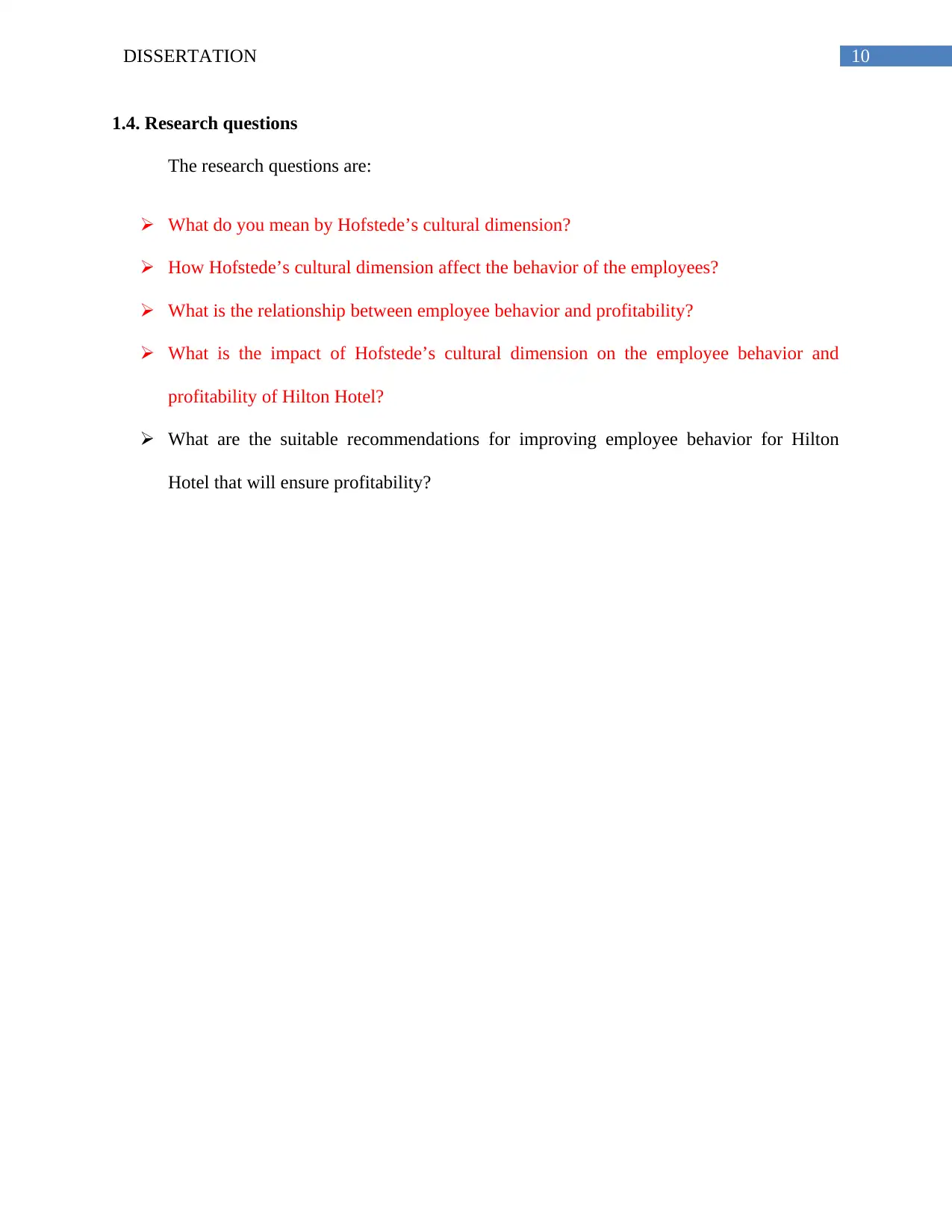
10DISSERTATION
1.4. Research questions
The research questions are:
What do you mean by Hofstede’s cultural dimension?
How Hofstede’s cultural dimension affect the behavior of the employees?
What is the relationship between employee behavior and profitability?
What is the impact of Hofstede’s cultural dimension on the employee behavior and
profitability of Hilton Hotel?
What are the suitable recommendations for improving employee behavior for Hilton
Hotel that will ensure profitability?
1.4. Research questions
The research questions are:
What do you mean by Hofstede’s cultural dimension?
How Hofstede’s cultural dimension affect the behavior of the employees?
What is the relationship between employee behavior and profitability?
What is the impact of Hofstede’s cultural dimension on the employee behavior and
profitability of Hilton Hotel?
What are the suitable recommendations for improving employee behavior for Hilton
Hotel that will ensure profitability?
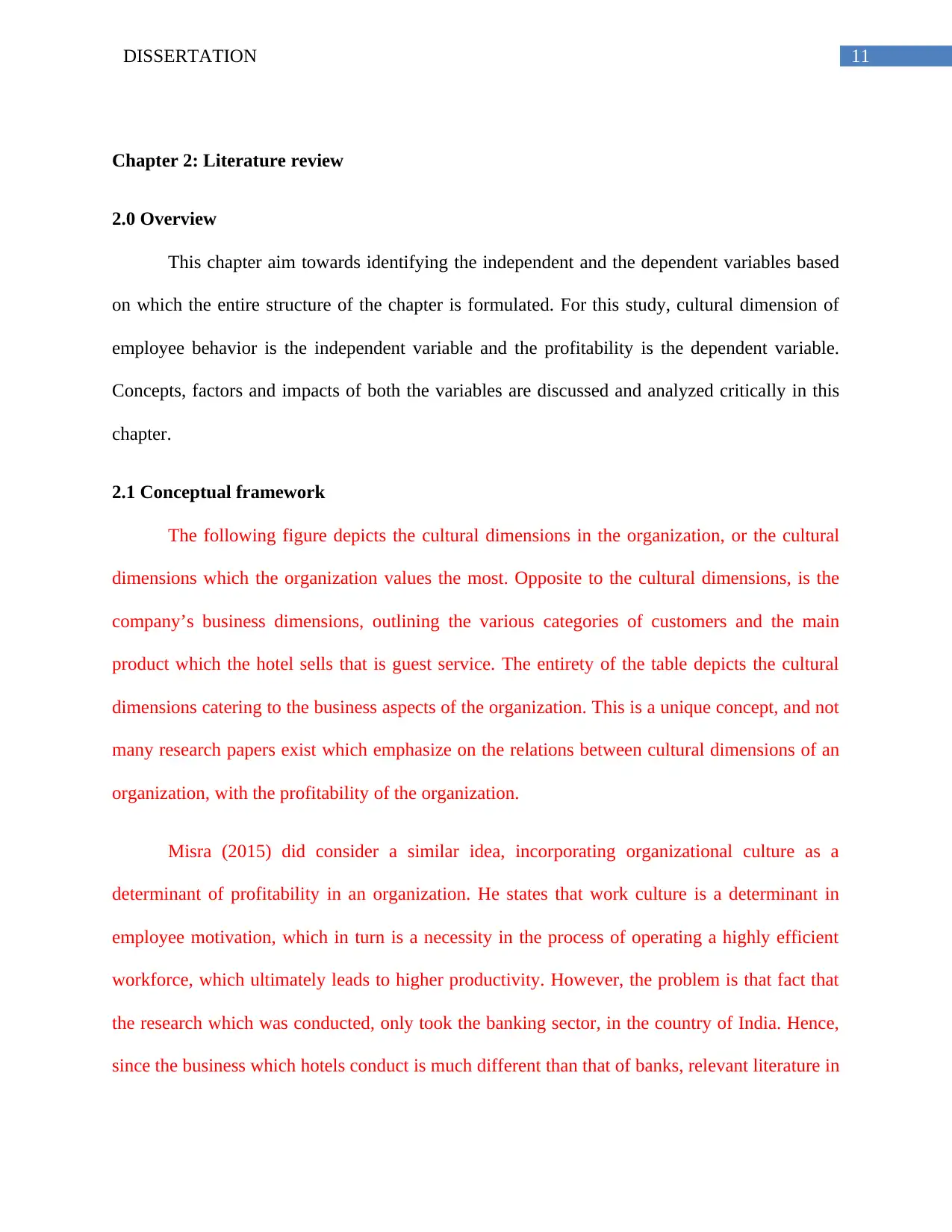
11DISSERTATION
Chapter 2: Literature review
2.0 Overview
This chapter aim towards identifying the independent and the dependent variables based
on which the entire structure of the chapter is formulated. For this study, cultural dimension of
employee behavior is the independent variable and the profitability is the dependent variable.
Concepts, factors and impacts of both the variables are discussed and analyzed critically in this
chapter.
2.1 Conceptual framework
The following figure depicts the cultural dimensions in the organization, or the cultural
dimensions which the organization values the most. Opposite to the cultural dimensions, is the
company’s business dimensions, outlining the various categories of customers and the main
product which the hotel sells that is guest service. The entirety of the table depicts the cultural
dimensions catering to the business aspects of the organization. This is a unique concept, and not
many research papers exist which emphasize on the relations between cultural dimensions of an
organization, with the profitability of the organization.
Misra (2015) did consider a similar idea, incorporating organizational culture as a
determinant of profitability in an organization. He states that work culture is a determinant in
employee motivation, which in turn is a necessity in the process of operating a highly efficient
workforce, which ultimately leads to higher productivity. However, the problem is that fact that
the research which was conducted, only took the banking sector, in the country of India. Hence,
since the business which hotels conduct is much different than that of banks, relevant literature in
Chapter 2: Literature review
2.0 Overview
This chapter aim towards identifying the independent and the dependent variables based
on which the entire structure of the chapter is formulated. For this study, cultural dimension of
employee behavior is the independent variable and the profitability is the dependent variable.
Concepts, factors and impacts of both the variables are discussed and analyzed critically in this
chapter.
2.1 Conceptual framework
The following figure depicts the cultural dimensions in the organization, or the cultural
dimensions which the organization values the most. Opposite to the cultural dimensions, is the
company’s business dimensions, outlining the various categories of customers and the main
product which the hotel sells that is guest service. The entirety of the table depicts the cultural
dimensions catering to the business aspects of the organization. This is a unique concept, and not
many research papers exist which emphasize on the relations between cultural dimensions of an
organization, with the profitability of the organization.
Misra (2015) did consider a similar idea, incorporating organizational culture as a
determinant of profitability in an organization. He states that work culture is a determinant in
employee motivation, which in turn is a necessity in the process of operating a highly efficient
workforce, which ultimately leads to higher productivity. However, the problem is that fact that
the research which was conducted, only took the banking sector, in the country of India. Hence,
since the business which hotels conduct is much different than that of banks, relevant literature in
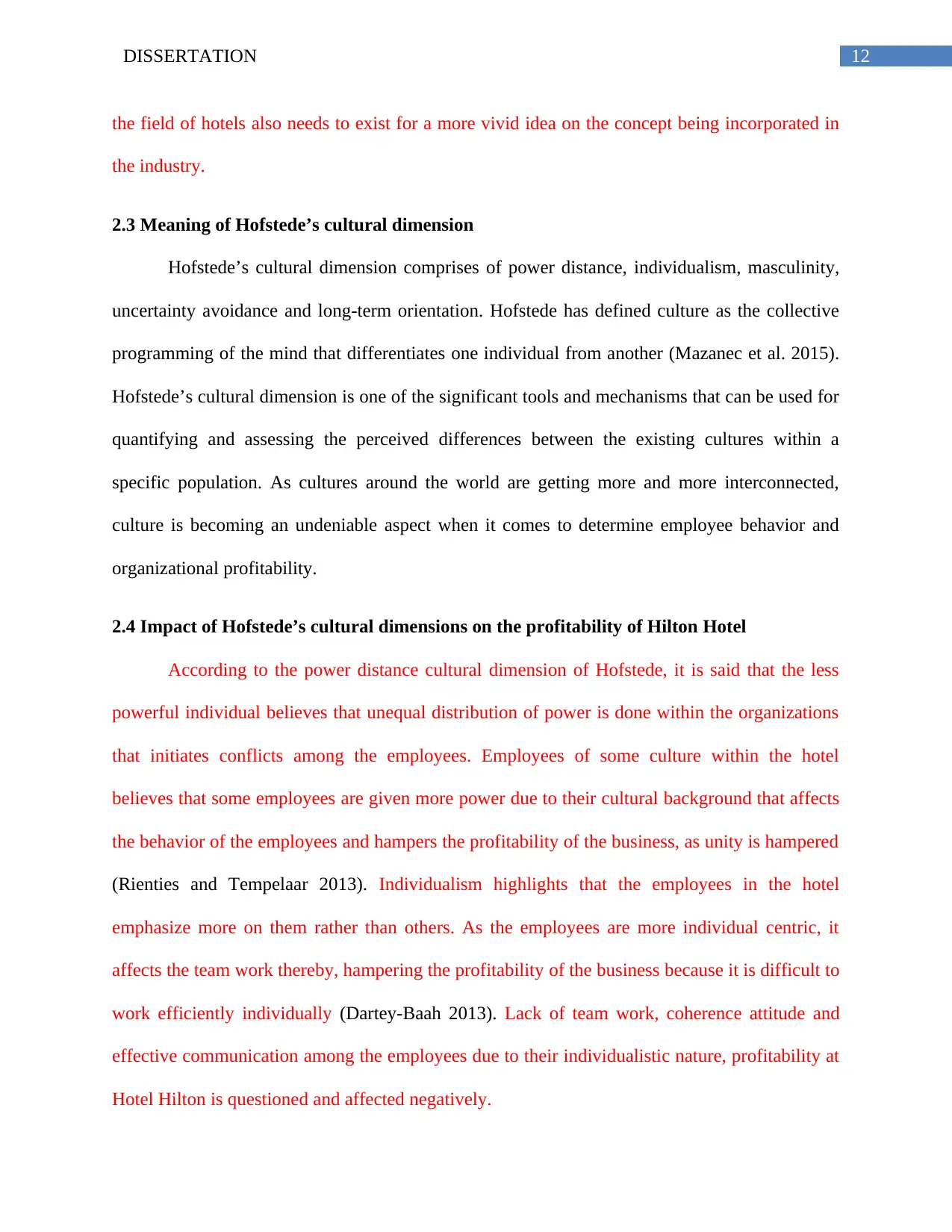
12DISSERTATION
the field of hotels also needs to exist for a more vivid idea on the concept being incorporated in
the industry.
2.3 Meaning of Hofstede’s cultural dimension
Hofstede’s cultural dimension comprises of power distance, individualism, masculinity,
uncertainty avoidance and long-term orientation. Hofstede has defined culture as the collective
programming of the mind that differentiates one individual from another (Mazanec et al. 2015).
Hofstede’s cultural dimension is one of the significant tools and mechanisms that can be used for
quantifying and assessing the perceived differences between the existing cultures within a
specific population. As cultures around the world are getting more and more interconnected,
culture is becoming an undeniable aspect when it comes to determine employee behavior and
organizational profitability.
2.4 Impact of Hofstede’s cultural dimensions on the profitability of Hilton Hotel
According to the power distance cultural dimension of Hofstede, it is said that the less
powerful individual believes that unequal distribution of power is done within the organizations
that initiates conflicts among the employees. Employees of some culture within the hotel
believes that some employees are given more power due to their cultural background that affects
the behavior of the employees and hampers the profitability of the business, as unity is hampered
(Rienties and Tempelaar 2013). Individualism highlights that the employees in the hotel
emphasize more on them rather than others. As the employees are more individual centric, it
affects the team work thereby, hampering the profitability of the business because it is difficult to
work efficiently individually (Dartey-Baah 2013). Lack of team work, coherence attitude and
effective communication among the employees due to their individualistic nature, profitability at
Hotel Hilton is questioned and affected negatively.
the field of hotels also needs to exist for a more vivid idea on the concept being incorporated in
the industry.
2.3 Meaning of Hofstede’s cultural dimension
Hofstede’s cultural dimension comprises of power distance, individualism, masculinity,
uncertainty avoidance and long-term orientation. Hofstede has defined culture as the collective
programming of the mind that differentiates one individual from another (Mazanec et al. 2015).
Hofstede’s cultural dimension is one of the significant tools and mechanisms that can be used for
quantifying and assessing the perceived differences between the existing cultures within a
specific population. As cultures around the world are getting more and more interconnected,
culture is becoming an undeniable aspect when it comes to determine employee behavior and
organizational profitability.
2.4 Impact of Hofstede’s cultural dimensions on the profitability of Hilton Hotel
According to the power distance cultural dimension of Hofstede, it is said that the less
powerful individual believes that unequal distribution of power is done within the organizations
that initiates conflicts among the employees. Employees of some culture within the hotel
believes that some employees are given more power due to their cultural background that affects
the behavior of the employees and hampers the profitability of the business, as unity is hampered
(Rienties and Tempelaar 2013). Individualism highlights that the employees in the hotel
emphasize more on them rather than others. As the employees are more individual centric, it
affects the team work thereby, hampering the profitability of the business because it is difficult to
work efficiently individually (Dartey-Baah 2013). Lack of team work, coherence attitude and
effective communication among the employees due to their individualistic nature, profitability at
Hotel Hilton is questioned and affected negatively.
Paraphrase This Document
Need a fresh take? Get an instant paraphrase of this document with our AI Paraphraser
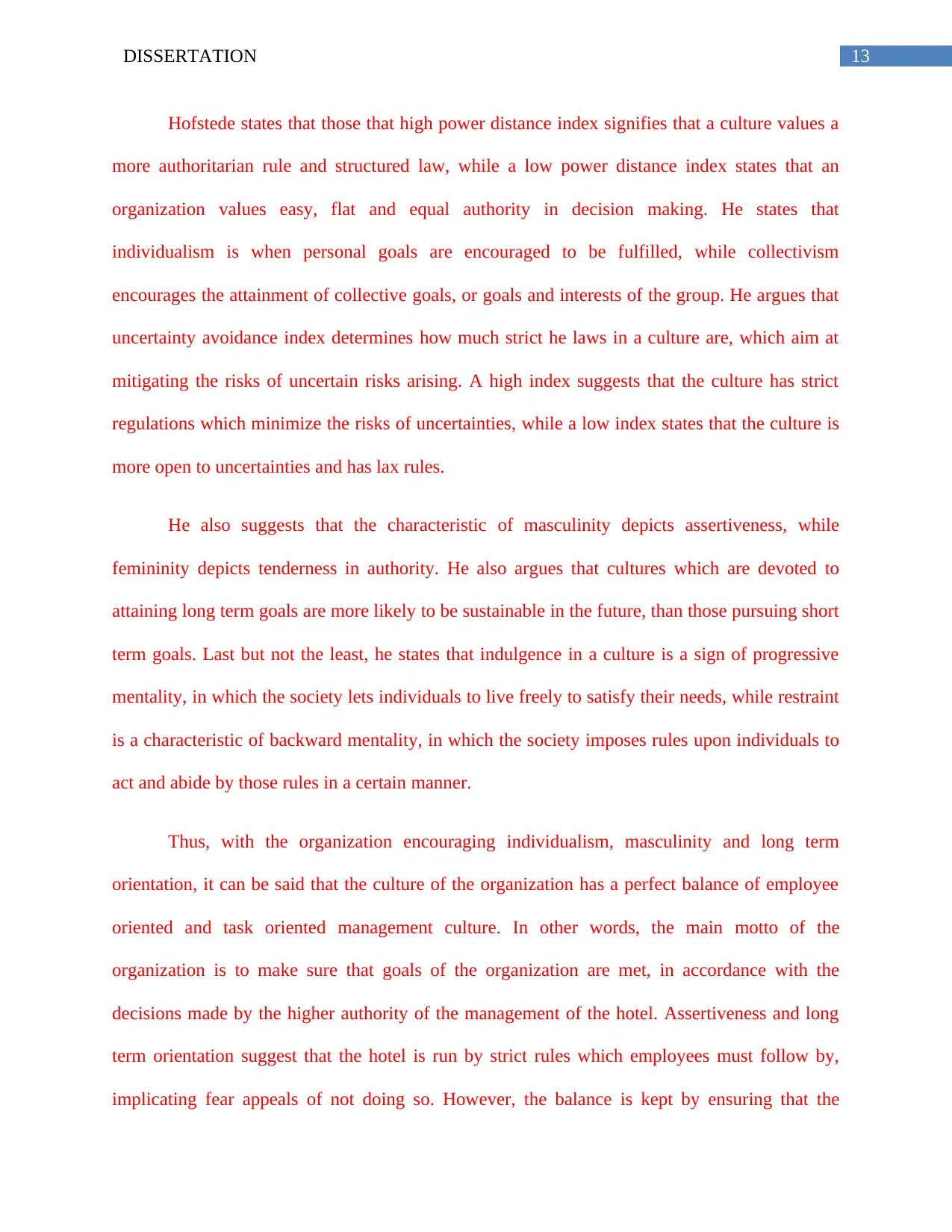
13DISSERTATION
Hofstede states that those that high power distance index signifies that a culture values a
more authoritarian rule and structured law, while a low power distance index states that an
organization values easy, flat and equal authority in decision making. He states that
individualism is when personal goals are encouraged to be fulfilled, while collectivism
encourages the attainment of collective goals, or goals and interests of the group. He argues that
uncertainty avoidance index determines how much strict he laws in a culture are, which aim at
mitigating the risks of uncertain risks arising. A high index suggests that the culture has strict
regulations which minimize the risks of uncertainties, while a low index states that the culture is
more open to uncertainties and has lax rules.
He also suggests that the characteristic of masculinity depicts assertiveness, while
femininity depicts tenderness in authority. He also argues that cultures which are devoted to
attaining long term goals are more likely to be sustainable in the future, than those pursuing short
term goals. Last but not the least, he states that indulgence in a culture is a sign of progressive
mentality, in which the society lets individuals to live freely to satisfy their needs, while restraint
is a characteristic of backward mentality, in which the society imposes rules upon individuals to
act and abide by those rules in a certain manner.
Thus, with the organization encouraging individualism, masculinity and long term
orientation, it can be said that the culture of the organization has a perfect balance of employee
oriented and task oriented management culture. In other words, the main motto of the
organization is to make sure that goals of the organization are met, in accordance with the
decisions made by the higher authority of the management of the hotel. Assertiveness and long
term orientation suggest that the hotel is run by strict rules which employees must follow by,
implicating fear appeals of not doing so. However, the balance is kept by ensuring that the
Hofstede states that those that high power distance index signifies that a culture values a
more authoritarian rule and structured law, while a low power distance index states that an
organization values easy, flat and equal authority in decision making. He states that
individualism is when personal goals are encouraged to be fulfilled, while collectivism
encourages the attainment of collective goals, or goals and interests of the group. He argues that
uncertainty avoidance index determines how much strict he laws in a culture are, which aim at
mitigating the risks of uncertain risks arising. A high index suggests that the culture has strict
regulations which minimize the risks of uncertainties, while a low index states that the culture is
more open to uncertainties and has lax rules.
He also suggests that the characteristic of masculinity depicts assertiveness, while
femininity depicts tenderness in authority. He also argues that cultures which are devoted to
attaining long term goals are more likely to be sustainable in the future, than those pursuing short
term goals. Last but not the least, he states that indulgence in a culture is a sign of progressive
mentality, in which the society lets individuals to live freely to satisfy their needs, while restraint
is a characteristic of backward mentality, in which the society imposes rules upon individuals to
act and abide by those rules in a certain manner.
Thus, with the organization encouraging individualism, masculinity and long term
orientation, it can be said that the culture of the organization has a perfect balance of employee
oriented and task oriented management culture. In other words, the main motto of the
organization is to make sure that goals of the organization are met, in accordance with the
decisions made by the higher authority of the management of the hotel. Assertiveness and long
term orientation suggest that the hotel is run by strict rules which employees must follow by,
implicating fear appeals of not doing so. However, the balance is kept by ensuring that the
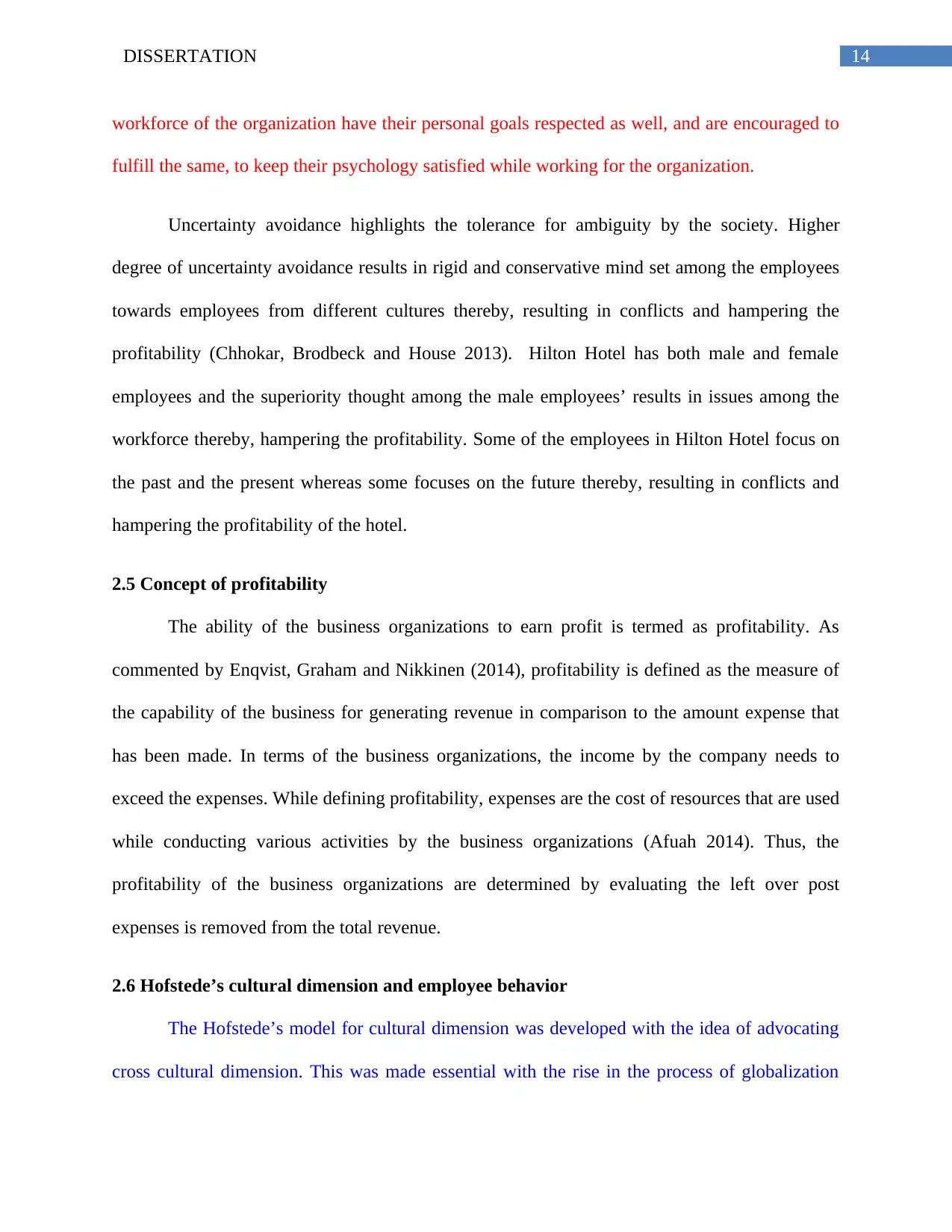
14DISSERTATION
workforce of the organization have their personal goals respected as well, and are encouraged to
fulfill the same, to keep their psychology satisfied while working for the organization.
Uncertainty avoidance highlights the tolerance for ambiguity by the society. Higher
degree of uncertainty avoidance results in rigid and conservative mind set among the employees
towards employees from different cultures thereby, resulting in conflicts and hampering the
profitability (Chhokar, Brodbeck and House 2013). Hilton Hotel has both male and female
employees and the superiority thought among the male employees’ results in issues among the
workforce thereby, hampering the profitability. Some of the employees in Hilton Hotel focus on
the past and the present whereas some focuses on the future thereby, resulting in conflicts and
hampering the profitability of the hotel.
2.5 Concept of profitability
The ability of the business organizations to earn profit is termed as profitability. As
commented by Enqvist, Graham and Nikkinen (2014), profitability is defined as the measure of
the capability of the business for generating revenue in comparison to the amount expense that
has been made. In terms of the business organizations, the income by the company needs to
exceed the expenses. While defining profitability, expenses are the cost of resources that are used
while conducting various activities by the business organizations (Afuah 2014). Thus, the
profitability of the business organizations are determined by evaluating the left over post
expenses is removed from the total revenue.
2.6 Hofstede’s cultural dimension and employee behavior
The Hofstede’s model for cultural dimension was developed with the idea of advocating
cross cultural dimension. This was made essential with the rise in the process of globalization
workforce of the organization have their personal goals respected as well, and are encouraged to
fulfill the same, to keep their psychology satisfied while working for the organization.
Uncertainty avoidance highlights the tolerance for ambiguity by the society. Higher
degree of uncertainty avoidance results in rigid and conservative mind set among the employees
towards employees from different cultures thereby, resulting in conflicts and hampering the
profitability (Chhokar, Brodbeck and House 2013). Hilton Hotel has both male and female
employees and the superiority thought among the male employees’ results in issues among the
workforce thereby, hampering the profitability. Some of the employees in Hilton Hotel focus on
the past and the present whereas some focuses on the future thereby, resulting in conflicts and
hampering the profitability of the hotel.
2.5 Concept of profitability
The ability of the business organizations to earn profit is termed as profitability. As
commented by Enqvist, Graham and Nikkinen (2014), profitability is defined as the measure of
the capability of the business for generating revenue in comparison to the amount expense that
has been made. In terms of the business organizations, the income by the company needs to
exceed the expenses. While defining profitability, expenses are the cost of resources that are used
while conducting various activities by the business organizations (Afuah 2014). Thus, the
profitability of the business organizations are determined by evaluating the left over post
expenses is removed from the total revenue.
2.6 Hofstede’s cultural dimension and employee behavior
The Hofstede’s model for cultural dimension was developed with the idea of advocating
cross cultural dimension. This was made essential with the rise in the process of globalization
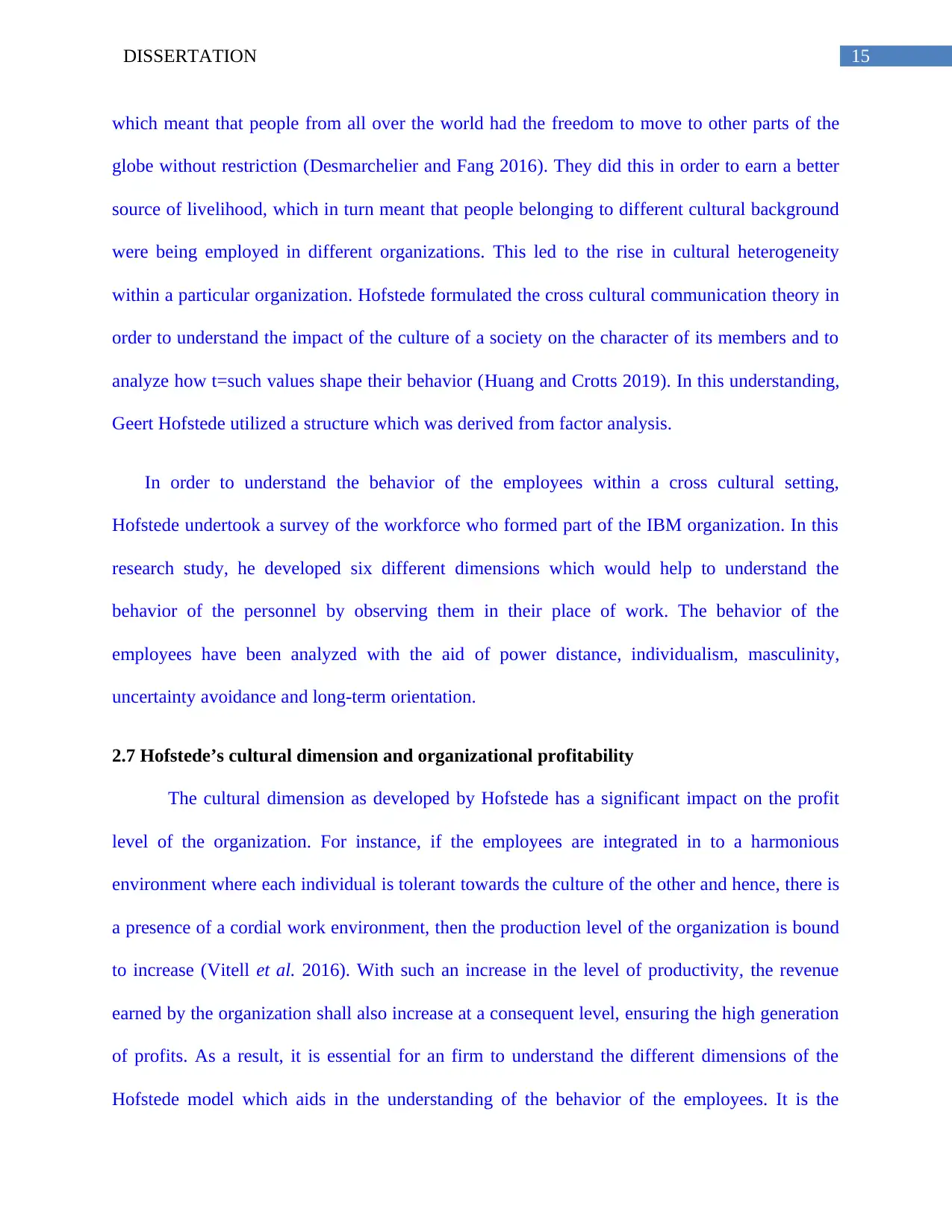
15DISSERTATION
which meant that people from all over the world had the freedom to move to other parts of the
globe without restriction (Desmarchelier and Fang 2016). They did this in order to earn a better
source of livelihood, which in turn meant that people belonging to different cultural background
were being employed in different organizations. This led to the rise in cultural heterogeneity
within a particular organization. Hofstede formulated the cross cultural communication theory in
order to understand the impact of the culture of a society on the character of its members and to
analyze how t=such values shape their behavior (Huang and Crotts 2019). In this understanding,
Geert Hofstede utilized a structure which was derived from factor analysis.
In order to understand the behavior of the employees within a cross cultural setting,
Hofstede undertook a survey of the workforce who formed part of the IBM organization. In this
research study, he developed six different dimensions which would help to understand the
behavior of the personnel by observing them in their place of work. The behavior of the
employees have been analyzed with the aid of power distance, individualism, masculinity,
uncertainty avoidance and long-term orientation.
2.7 Hofstede’s cultural dimension and organizational profitability
The cultural dimension as developed by Hofstede has a significant impact on the profit
level of the organization. For instance, if the employees are integrated in to a harmonious
environment where each individual is tolerant towards the culture of the other and hence, there is
a presence of a cordial work environment, then the production level of the organization is bound
to increase (Vitell et al. 2016). With such an increase in the level of productivity, the revenue
earned by the organization shall also increase at a consequent level, ensuring the high generation
of profits. As a result, it is essential for an firm to understand the different dimensions of the
Hofstede model which aids in the understanding of the behavior of the employees. It is the
which meant that people from all over the world had the freedom to move to other parts of the
globe without restriction (Desmarchelier and Fang 2016). They did this in order to earn a better
source of livelihood, which in turn meant that people belonging to different cultural background
were being employed in different organizations. This led to the rise in cultural heterogeneity
within a particular organization. Hofstede formulated the cross cultural communication theory in
order to understand the impact of the culture of a society on the character of its members and to
analyze how t=such values shape their behavior (Huang and Crotts 2019). In this understanding,
Geert Hofstede utilized a structure which was derived from factor analysis.
In order to understand the behavior of the employees within a cross cultural setting,
Hofstede undertook a survey of the workforce who formed part of the IBM organization. In this
research study, he developed six different dimensions which would help to understand the
behavior of the personnel by observing them in their place of work. The behavior of the
employees have been analyzed with the aid of power distance, individualism, masculinity,
uncertainty avoidance and long-term orientation.
2.7 Hofstede’s cultural dimension and organizational profitability
The cultural dimension as developed by Hofstede has a significant impact on the profit
level of the organization. For instance, if the employees are integrated in to a harmonious
environment where each individual is tolerant towards the culture of the other and hence, there is
a presence of a cordial work environment, then the production level of the organization is bound
to increase (Vitell et al. 2016). With such an increase in the level of productivity, the revenue
earned by the organization shall also increase at a consequent level, ensuring the high generation
of profits. As a result, it is essential for an firm to understand the different dimensions of the
Hofstede model which aids in the understanding of the behavior of the employees. It is the
Secure Best Marks with AI Grader
Need help grading? Try our AI Grader for instant feedback on your assignments.
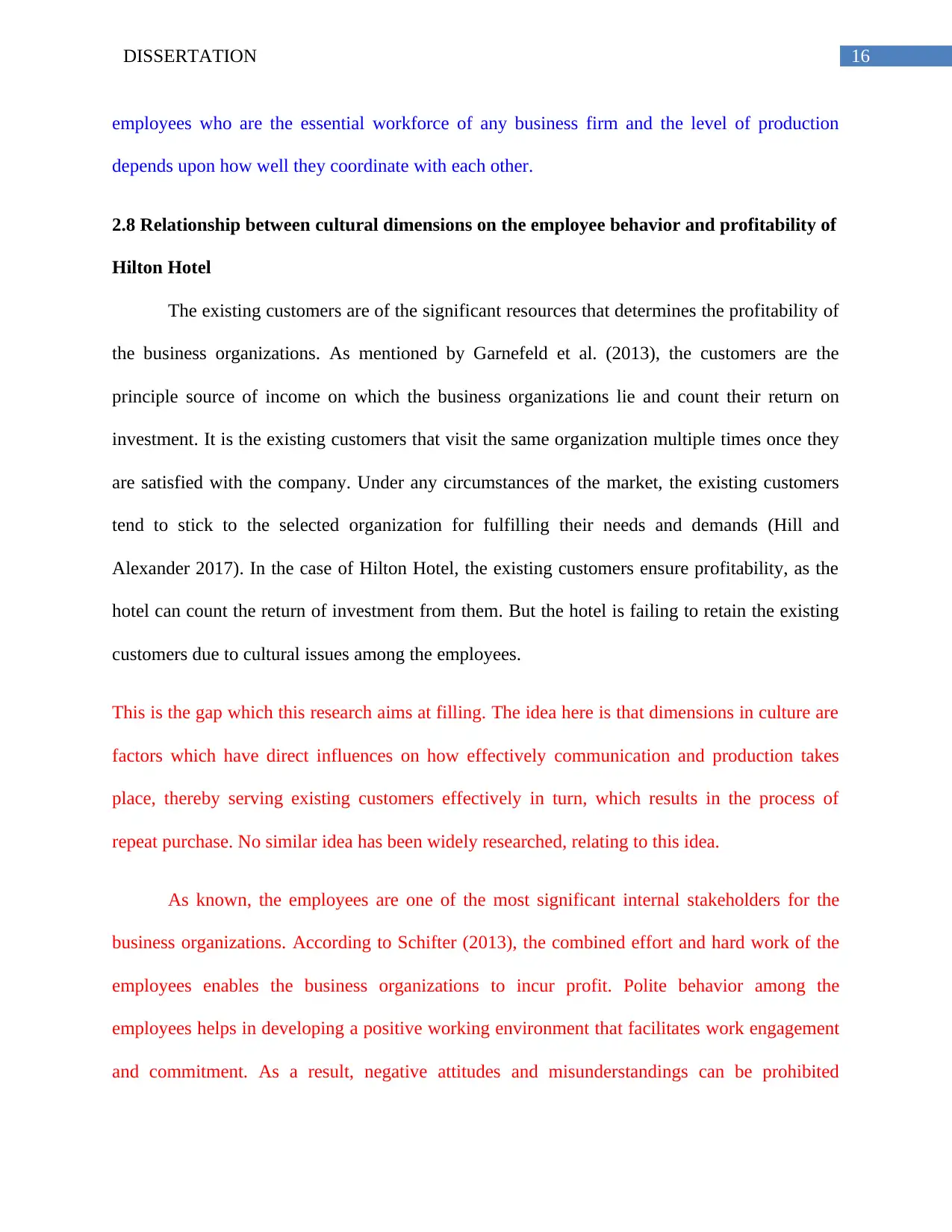
16DISSERTATION
employees who are the essential workforce of any business firm and the level of production
depends upon how well they coordinate with each other.
2.8 Relationship between cultural dimensions on the employee behavior and profitability of
Hilton Hotel
The existing customers are of the significant resources that determines the profitability of
the business organizations. As mentioned by Garnefeld et al. (2013), the customers are the
principle source of income on which the business organizations lie and count their return on
investment. It is the existing customers that visit the same organization multiple times once they
are satisfied with the company. Under any circumstances of the market, the existing customers
tend to stick to the selected organization for fulfilling their needs and demands (Hill and
Alexander 2017). In the case of Hilton Hotel, the existing customers ensure profitability, as the
hotel can count the return of investment from them. But the hotel is failing to retain the existing
customers due to cultural issues among the employees.
This is the gap which this research aims at filling. The idea here is that dimensions in culture are
factors which have direct influences on how effectively communication and production takes
place, thereby serving existing customers effectively in turn, which results in the process of
repeat purchase. No similar idea has been widely researched, relating to this idea.
As known, the employees are one of the most significant internal stakeholders for the
business organizations. According to Schifter (2013), the combined effort and hard work of the
employees enables the business organizations to incur profit. Polite behavior among the
employees helps in developing a positive working environment that facilitates work engagement
and commitment. As a result, negative attitudes and misunderstandings can be prohibited
employees who are the essential workforce of any business firm and the level of production
depends upon how well they coordinate with each other.
2.8 Relationship between cultural dimensions on the employee behavior and profitability of
Hilton Hotel
The existing customers are of the significant resources that determines the profitability of
the business organizations. As mentioned by Garnefeld et al. (2013), the customers are the
principle source of income on which the business organizations lie and count their return on
investment. It is the existing customers that visit the same organization multiple times once they
are satisfied with the company. Under any circumstances of the market, the existing customers
tend to stick to the selected organization for fulfilling their needs and demands (Hill and
Alexander 2017). In the case of Hilton Hotel, the existing customers ensure profitability, as the
hotel can count the return of investment from them. But the hotel is failing to retain the existing
customers due to cultural issues among the employees.
This is the gap which this research aims at filling. The idea here is that dimensions in culture are
factors which have direct influences on how effectively communication and production takes
place, thereby serving existing customers effectively in turn, which results in the process of
repeat purchase. No similar idea has been widely researched, relating to this idea.
As known, the employees are one of the most significant internal stakeholders for the
business organizations. According to Schifter (2013), the combined effort and hard work of the
employees enables the business organizations to incur profit. Polite behavior among the
employees helps in developing a positive working environment that facilitates work engagement
and commitment. As a result, negative attitudes and misunderstandings can be prohibited

17DISSERTATION
thereby, giving rise to a hostile workplace that influences support, co-ordination and co-
operation. Therefore, the employees are able to ensure quality and delver work on time that
provides an opportunity for the business organizations to incur profit. However, as argued by
Farzipoor Saen (2013), the behavior of the employees at workplace helps in ensuring
organizational profitability by facilitating effective communication. As a result, clear flow of
information is established that prevents repetitive actions and saves time. Similar is the case of
Hotel Hilton, where the behavior of the existing employees highlights the ability of the
organization to incur profit or not.
It is necessary for the business organizations to ensure equality for the existing
employees irrespective of their cultural background. The employees at workplace should be
given adequate and suitable opportunities strictly based on their abilities and capabilities. As
mentioned by Kowalkowski, Witell and Gustafsson (2013), discrimination in respect to roles and
responsibilities is noticed in business organizations due to the cultural background of the
employees. Under such circumstances, the employees with cultural minority is not provided
adequate opportunities due to which their strengths are not used appropriately that affects the
organizational profitability.
However, as criticized by Urquhart and Weir (2014), workplace inequality results in
higher rate of employee turnover that affects the organizational profitability negatively. The
skilled and highly qualified employees leave the organizations because of the existing inequality
due to which the growth and competitive advantage of the organizations are compromised
largely. In the case of Hotel Hilton, it has been seen that employees are discriminated due to their
cultural background and deserving employees are not given equal and desired chances that is
thereby, giving rise to a hostile workplace that influences support, co-ordination and co-
operation. Therefore, the employees are able to ensure quality and delver work on time that
provides an opportunity for the business organizations to incur profit. However, as argued by
Farzipoor Saen (2013), the behavior of the employees at workplace helps in ensuring
organizational profitability by facilitating effective communication. As a result, clear flow of
information is established that prevents repetitive actions and saves time. Similar is the case of
Hotel Hilton, where the behavior of the existing employees highlights the ability of the
organization to incur profit or not.
It is necessary for the business organizations to ensure equality for the existing
employees irrespective of their cultural background. The employees at workplace should be
given adequate and suitable opportunities strictly based on their abilities and capabilities. As
mentioned by Kowalkowski, Witell and Gustafsson (2013), discrimination in respect to roles and
responsibilities is noticed in business organizations due to the cultural background of the
employees. Under such circumstances, the employees with cultural minority is not provided
adequate opportunities due to which their strengths are not used appropriately that affects the
organizational profitability.
However, as criticized by Urquhart and Weir (2014), workplace inequality results in
higher rate of employee turnover that affects the organizational profitability negatively. The
skilled and highly qualified employees leave the organizations because of the existing inequality
due to which the growth and competitive advantage of the organizations are compromised
largely. In the case of Hotel Hilton, it has been seen that employees are discriminated due to their
cultural background and deserving employees are not given equal and desired chances that is
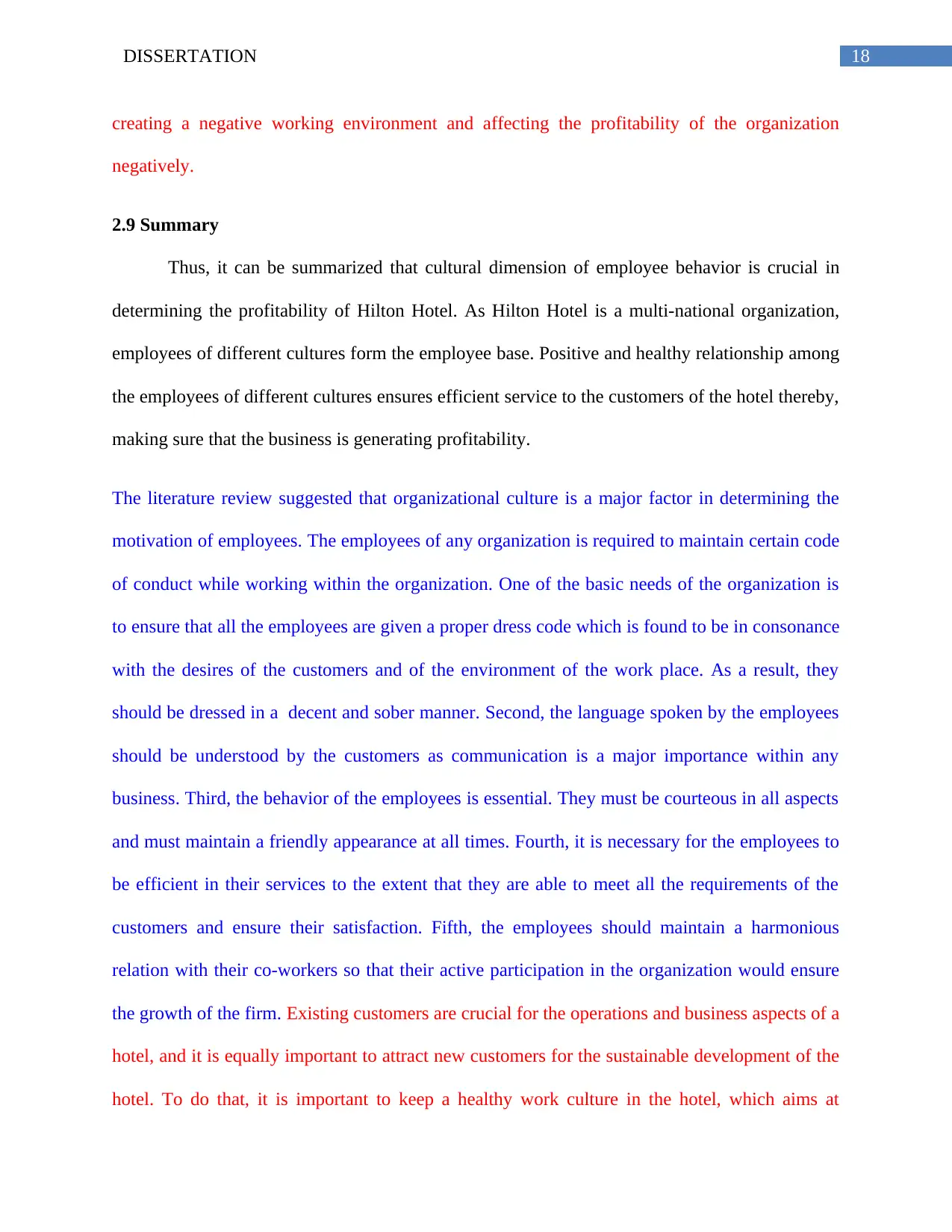
18DISSERTATION
creating a negative working environment and affecting the profitability of the organization
negatively.
2.9 Summary
Thus, it can be summarized that cultural dimension of employee behavior is crucial in
determining the profitability of Hilton Hotel. As Hilton Hotel is a multi-national organization,
employees of different cultures form the employee base. Positive and healthy relationship among
the employees of different cultures ensures efficient service to the customers of the hotel thereby,
making sure that the business is generating profitability.
The literature review suggested that organizational culture is a major factor in determining the
motivation of employees. The employees of any organization is required to maintain certain code
of conduct while working within the organization. One of the basic needs of the organization is
to ensure that all the employees are given a proper dress code which is found to be in consonance
with the desires of the customers and of the environment of the work place. As a result, they
should be dressed in a decent and sober manner. Second, the language spoken by the employees
should be understood by the customers as communication is a major importance within any
business. Third, the behavior of the employees is essential. They must be courteous in all aspects
and must maintain a friendly appearance at all times. Fourth, it is necessary for the employees to
be efficient in their services to the extent that they are able to meet all the requirements of the
customers and ensure their satisfaction. Fifth, the employees should maintain a harmonious
relation with their co-workers so that their active participation in the organization would ensure
the growth of the firm. Existing customers are crucial for the operations and business aspects of a
hotel, and it is equally important to attract new customers for the sustainable development of the
hotel. To do that, it is important to keep a healthy work culture in the hotel, which aims at
creating a negative working environment and affecting the profitability of the organization
negatively.
2.9 Summary
Thus, it can be summarized that cultural dimension of employee behavior is crucial in
determining the profitability of Hilton Hotel. As Hilton Hotel is a multi-national organization,
employees of different cultures form the employee base. Positive and healthy relationship among
the employees of different cultures ensures efficient service to the customers of the hotel thereby,
making sure that the business is generating profitability.
The literature review suggested that organizational culture is a major factor in determining the
motivation of employees. The employees of any organization is required to maintain certain code
of conduct while working within the organization. One of the basic needs of the organization is
to ensure that all the employees are given a proper dress code which is found to be in consonance
with the desires of the customers and of the environment of the work place. As a result, they
should be dressed in a decent and sober manner. Second, the language spoken by the employees
should be understood by the customers as communication is a major importance within any
business. Third, the behavior of the employees is essential. They must be courteous in all aspects
and must maintain a friendly appearance at all times. Fourth, it is necessary for the employees to
be efficient in their services to the extent that they are able to meet all the requirements of the
customers and ensure their satisfaction. Fifth, the employees should maintain a harmonious
relation with their co-workers so that their active participation in the organization would ensure
the growth of the firm. Existing customers are crucial for the operations and business aspects of a
hotel, and it is equally important to attract new customers for the sustainable development of the
hotel. To do that, it is important to keep a healthy work culture in the hotel, which aims at
Paraphrase This Document
Need a fresh take? Get an instant paraphrase of this document with our AI Paraphraser

19DISSERTATION
maintaining the motivation and satisfaction of the employees. As learnt from the review, balance
in an authoritarian and lenient culture is important for maintaining a healthy culture amongst the
workforce, while at the same time, being able to move forward with the organization’s objectives
for the long run. The research question was to find out why it is important to figure and how
much does an organizational culture play a part in employee motivation at the workplace. Hence,
the literature review exceeds its scope by not only demonstrating from the various academic
papers that cultural factors at the workplace is directly related to employee motivation and
performance, but also goes on to demonstrate how this motivation in turn results in the
profitability of the organization.
maintaining the motivation and satisfaction of the employees. As learnt from the review, balance
in an authoritarian and lenient culture is important for maintaining a healthy culture amongst the
workforce, while at the same time, being able to move forward with the organization’s objectives
for the long run. The research question was to find out why it is important to figure and how
much does an organizational culture play a part in employee motivation at the workplace. Hence,
the literature review exceeds its scope by not only demonstrating from the various academic
papers that cultural factors at the workplace is directly related to employee motivation and
performance, but also goes on to demonstrate how this motivation in turn results in the
profitability of the organization.
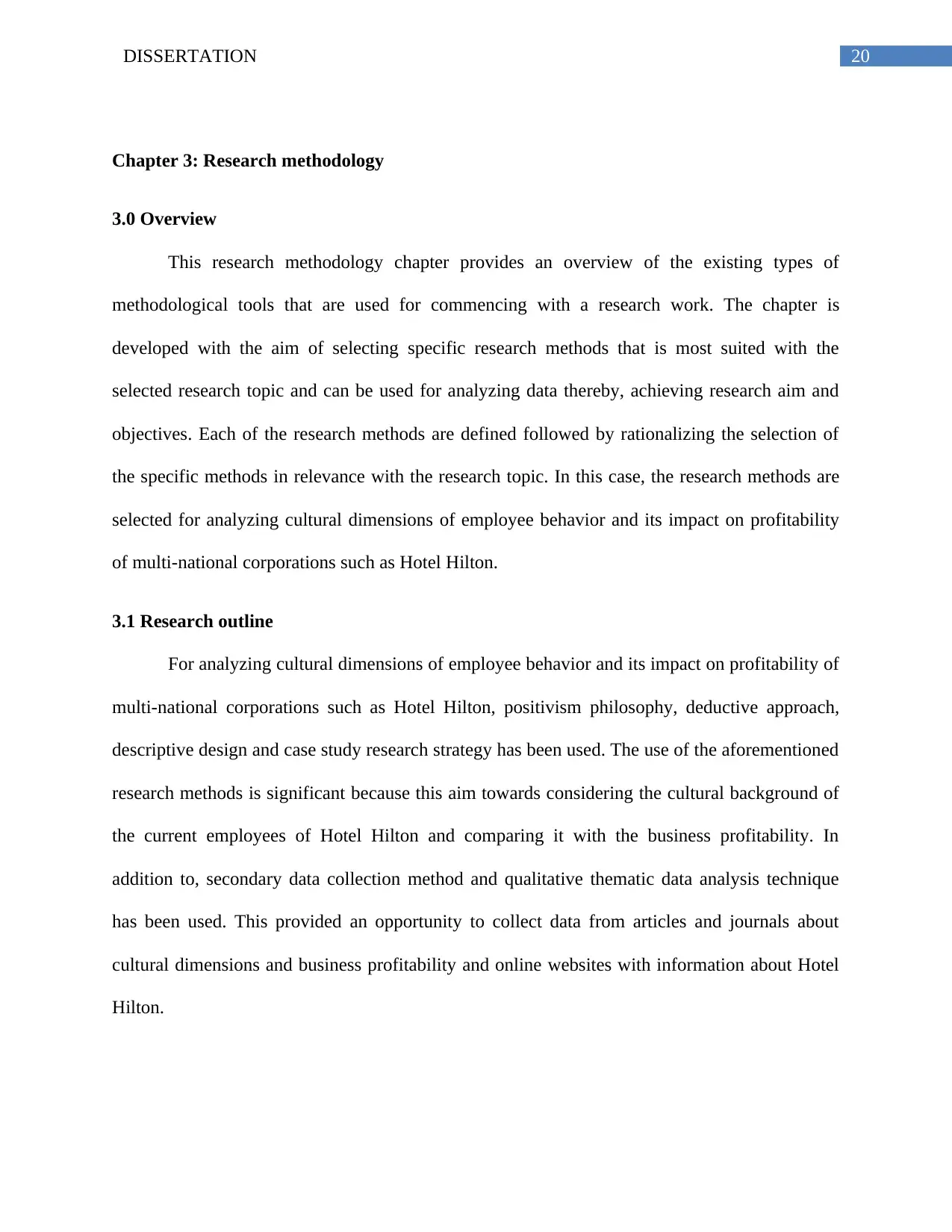
20DISSERTATION
Chapter 3: Research methodology
3.0 Overview
This research methodology chapter provides an overview of the existing types of
methodological tools that are used for commencing with a research work. The chapter is
developed with the aim of selecting specific research methods that is most suited with the
selected research topic and can be used for analyzing data thereby, achieving research aim and
objectives. Each of the research methods are defined followed by rationalizing the selection of
the specific methods in relevance with the research topic. In this case, the research methods are
selected for analyzing cultural dimensions of employee behavior and its impact on profitability
of multi-national corporations such as Hotel Hilton.
3.1 Research outline
For analyzing cultural dimensions of employee behavior and its impact on profitability of
multi-national corporations such as Hotel Hilton, positivism philosophy, deductive approach,
descriptive design and case study research strategy has been used. The use of the aforementioned
research methods is significant because this aim towards considering the cultural background of
the current employees of Hotel Hilton and comparing it with the business profitability. In
addition to, secondary data collection method and qualitative thematic data analysis technique
has been used. This provided an opportunity to collect data from articles and journals about
cultural dimensions and business profitability and online websites with information about Hotel
Hilton.
Chapter 3: Research methodology
3.0 Overview
This research methodology chapter provides an overview of the existing types of
methodological tools that are used for commencing with a research work. The chapter is
developed with the aim of selecting specific research methods that is most suited with the
selected research topic and can be used for analyzing data thereby, achieving research aim and
objectives. Each of the research methods are defined followed by rationalizing the selection of
the specific methods in relevance with the research topic. In this case, the research methods are
selected for analyzing cultural dimensions of employee behavior and its impact on profitability
of multi-national corporations such as Hotel Hilton.
3.1 Research outline
For analyzing cultural dimensions of employee behavior and its impact on profitability of
multi-national corporations such as Hotel Hilton, positivism philosophy, deductive approach,
descriptive design and case study research strategy has been used. The use of the aforementioned
research methods is significant because this aim towards considering the cultural background of
the current employees of Hotel Hilton and comparing it with the business profitability. In
addition to, secondary data collection method and qualitative thematic data analysis technique
has been used. This provided an opportunity to collect data from articles and journals about
cultural dimensions and business profitability and online websites with information about Hotel
Hilton.
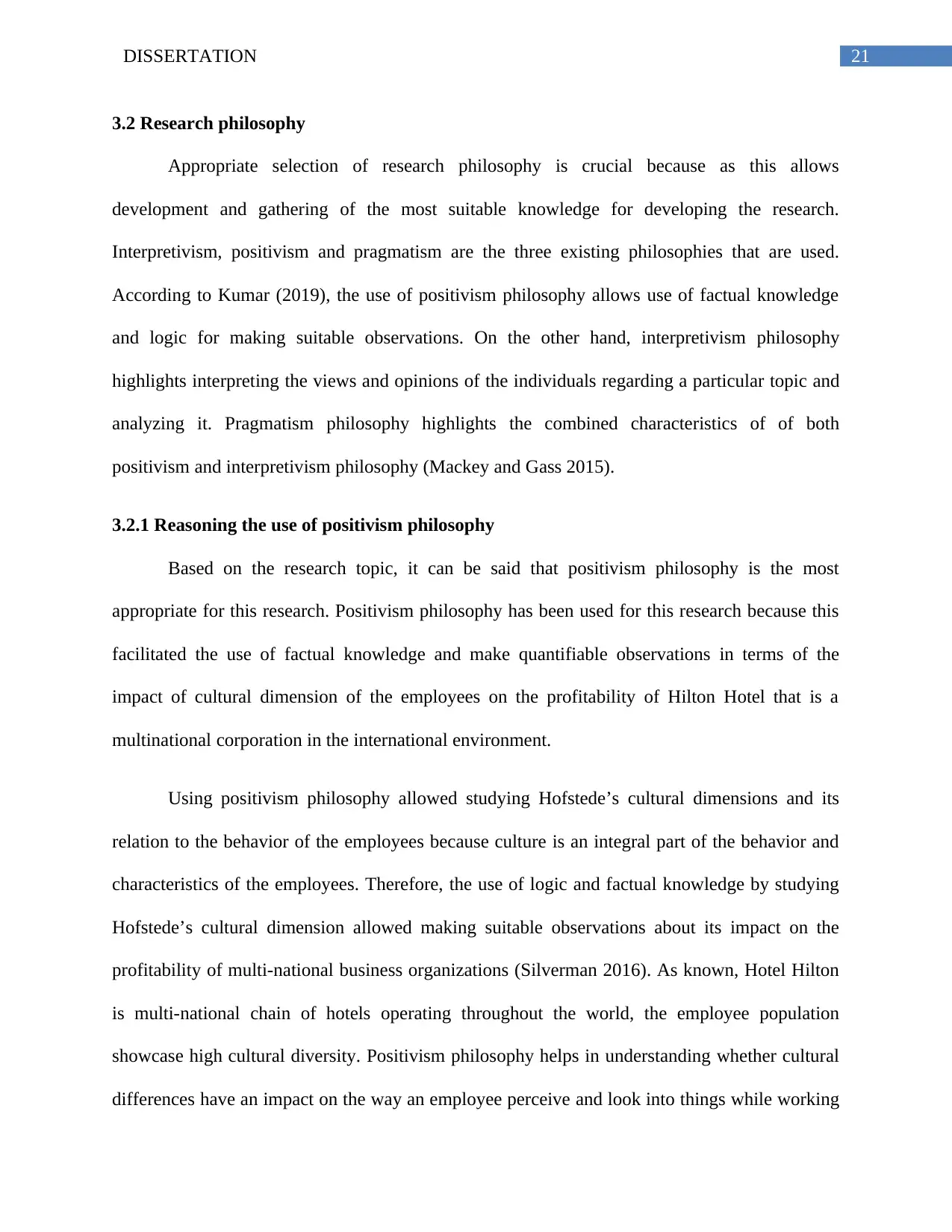
21DISSERTATION
3.2 Research philosophy
Appropriate selection of research philosophy is crucial because as this allows
development and gathering of the most suitable knowledge for developing the research.
Interpretivism, positivism and pragmatism are the three existing philosophies that are used.
According to Kumar (2019), the use of positivism philosophy allows use of factual knowledge
and logic for making suitable observations. On the other hand, interpretivism philosophy
highlights interpreting the views and opinions of the individuals regarding a particular topic and
analyzing it. Pragmatism philosophy highlights the combined characteristics of of both
positivism and interpretivism philosophy (Mackey and Gass 2015).
3.2.1 Reasoning the use of positivism philosophy
Based on the research topic, it can be said that positivism philosophy is the most
appropriate for this research. Positivism philosophy has been used for this research because this
facilitated the use of factual knowledge and make quantifiable observations in terms of the
impact of cultural dimension of the employees on the profitability of Hilton Hotel that is a
multinational corporation in the international environment.
Using positivism philosophy allowed studying Hofstede’s cultural dimensions and its
relation to the behavior of the employees because culture is an integral part of the behavior and
characteristics of the employees. Therefore, the use of logic and factual knowledge by studying
Hofstede’s cultural dimension allowed making suitable observations about its impact on the
profitability of multi-national business organizations (Silverman 2016). As known, Hotel Hilton
is multi-national chain of hotels operating throughout the world, the employee population
showcase high cultural diversity. Positivism philosophy helps in understanding whether cultural
differences have an impact on the way an employee perceive and look into things while working
3.2 Research philosophy
Appropriate selection of research philosophy is crucial because as this allows
development and gathering of the most suitable knowledge for developing the research.
Interpretivism, positivism and pragmatism are the three existing philosophies that are used.
According to Kumar (2019), the use of positivism philosophy allows use of factual knowledge
and logic for making suitable observations. On the other hand, interpretivism philosophy
highlights interpreting the views and opinions of the individuals regarding a particular topic and
analyzing it. Pragmatism philosophy highlights the combined characteristics of of both
positivism and interpretivism philosophy (Mackey and Gass 2015).
3.2.1 Reasoning the use of positivism philosophy
Based on the research topic, it can be said that positivism philosophy is the most
appropriate for this research. Positivism philosophy has been used for this research because this
facilitated the use of factual knowledge and make quantifiable observations in terms of the
impact of cultural dimension of the employees on the profitability of Hilton Hotel that is a
multinational corporation in the international environment.
Using positivism philosophy allowed studying Hofstede’s cultural dimensions and its
relation to the behavior of the employees because culture is an integral part of the behavior and
characteristics of the employees. Therefore, the use of logic and factual knowledge by studying
Hofstede’s cultural dimension allowed making suitable observations about its impact on the
profitability of multi-national business organizations (Silverman 2016). As known, Hotel Hilton
is multi-national chain of hotels operating throughout the world, the employee population
showcase high cultural diversity. Positivism philosophy helps in understanding whether cultural
differences have an impact on the way an employee perceive and look into things while working
Secure Best Marks with AI Grader
Need help grading? Try our AI Grader for instant feedback on your assignments.
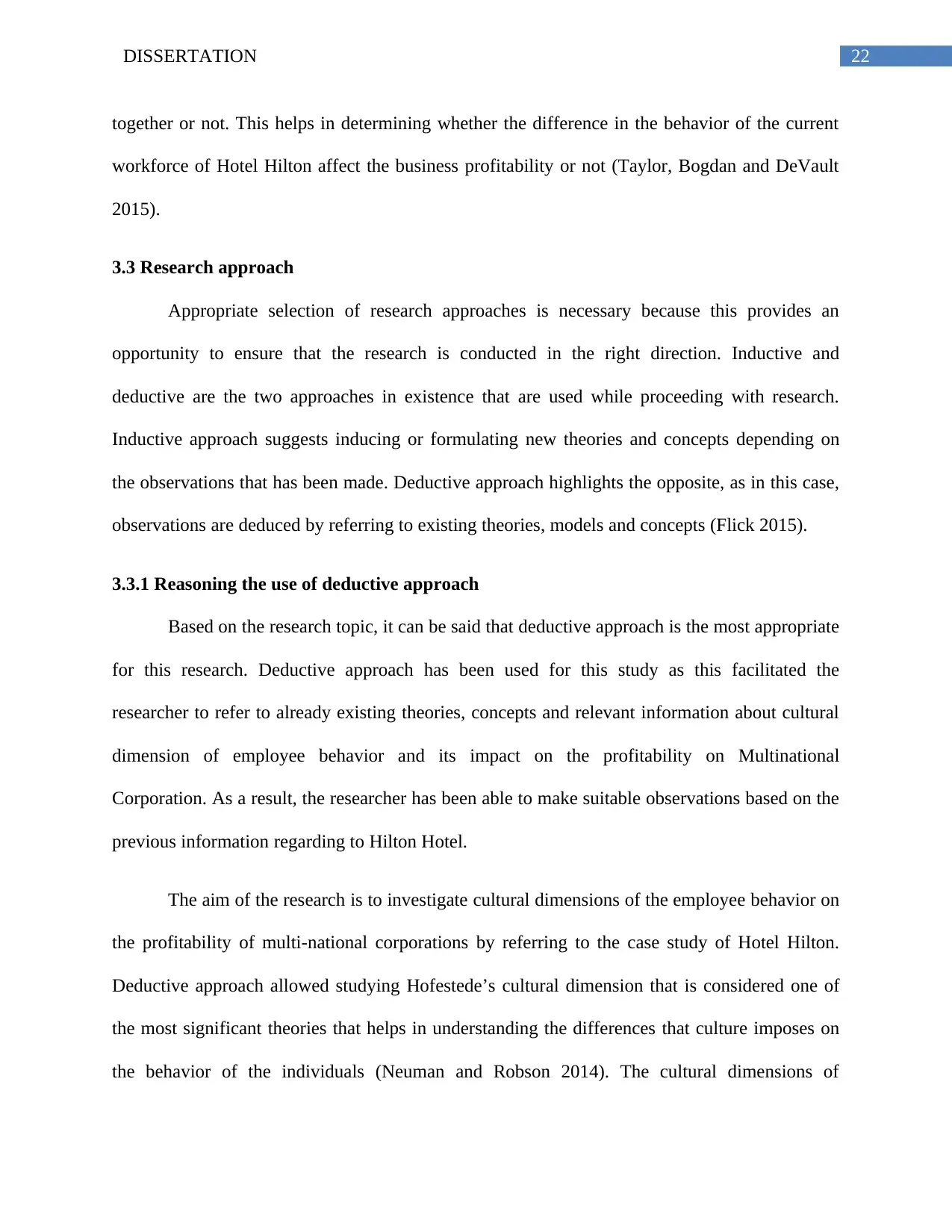
22DISSERTATION
together or not. This helps in determining whether the difference in the behavior of the current
workforce of Hotel Hilton affect the business profitability or not (Taylor, Bogdan and DeVault
2015).
3.3 Research approach
Appropriate selection of research approaches is necessary because this provides an
opportunity to ensure that the research is conducted in the right direction. Inductive and
deductive are the two approaches in existence that are used while proceeding with research.
Inductive approach suggests inducing or formulating new theories and concepts depending on
the observations that has been made. Deductive approach highlights the opposite, as in this case,
observations are deduced by referring to existing theories, models and concepts (Flick 2015).
3.3.1 Reasoning the use of deductive approach
Based on the research topic, it can be said that deductive approach is the most appropriate
for this research. Deductive approach has been used for this study as this facilitated the
researcher to refer to already existing theories, concepts and relevant information about cultural
dimension of employee behavior and its impact on the profitability on Multinational
Corporation. As a result, the researcher has been able to make suitable observations based on the
previous information regarding to Hilton Hotel.
The aim of the research is to investigate cultural dimensions of the employee behavior on
the profitability of multi-national corporations by referring to the case study of Hotel Hilton.
Deductive approach allowed studying Hofestede’s cultural dimension that is considered one of
the most significant theories that helps in understanding the differences that culture imposes on
the behavior of the individuals (Neuman and Robson 2014). The cultural dimensions of
together or not. This helps in determining whether the difference in the behavior of the current
workforce of Hotel Hilton affect the business profitability or not (Taylor, Bogdan and DeVault
2015).
3.3 Research approach
Appropriate selection of research approaches is necessary because this provides an
opportunity to ensure that the research is conducted in the right direction. Inductive and
deductive are the two approaches in existence that are used while proceeding with research.
Inductive approach suggests inducing or formulating new theories and concepts depending on
the observations that has been made. Deductive approach highlights the opposite, as in this case,
observations are deduced by referring to existing theories, models and concepts (Flick 2015).
3.3.1 Reasoning the use of deductive approach
Based on the research topic, it can be said that deductive approach is the most appropriate
for this research. Deductive approach has been used for this study as this facilitated the
researcher to refer to already existing theories, concepts and relevant information about cultural
dimension of employee behavior and its impact on the profitability on Multinational
Corporation. As a result, the researcher has been able to make suitable observations based on the
previous information regarding to Hilton Hotel.
The aim of the research is to investigate cultural dimensions of the employee behavior on
the profitability of multi-national corporations by referring to the case study of Hotel Hilton.
Deductive approach allowed studying Hofestede’s cultural dimension that is considered one of
the most significant theories that helps in understanding the differences that culture imposes on
the behavior of the individuals (Neuman and Robson 2014). The cultural dimensions of
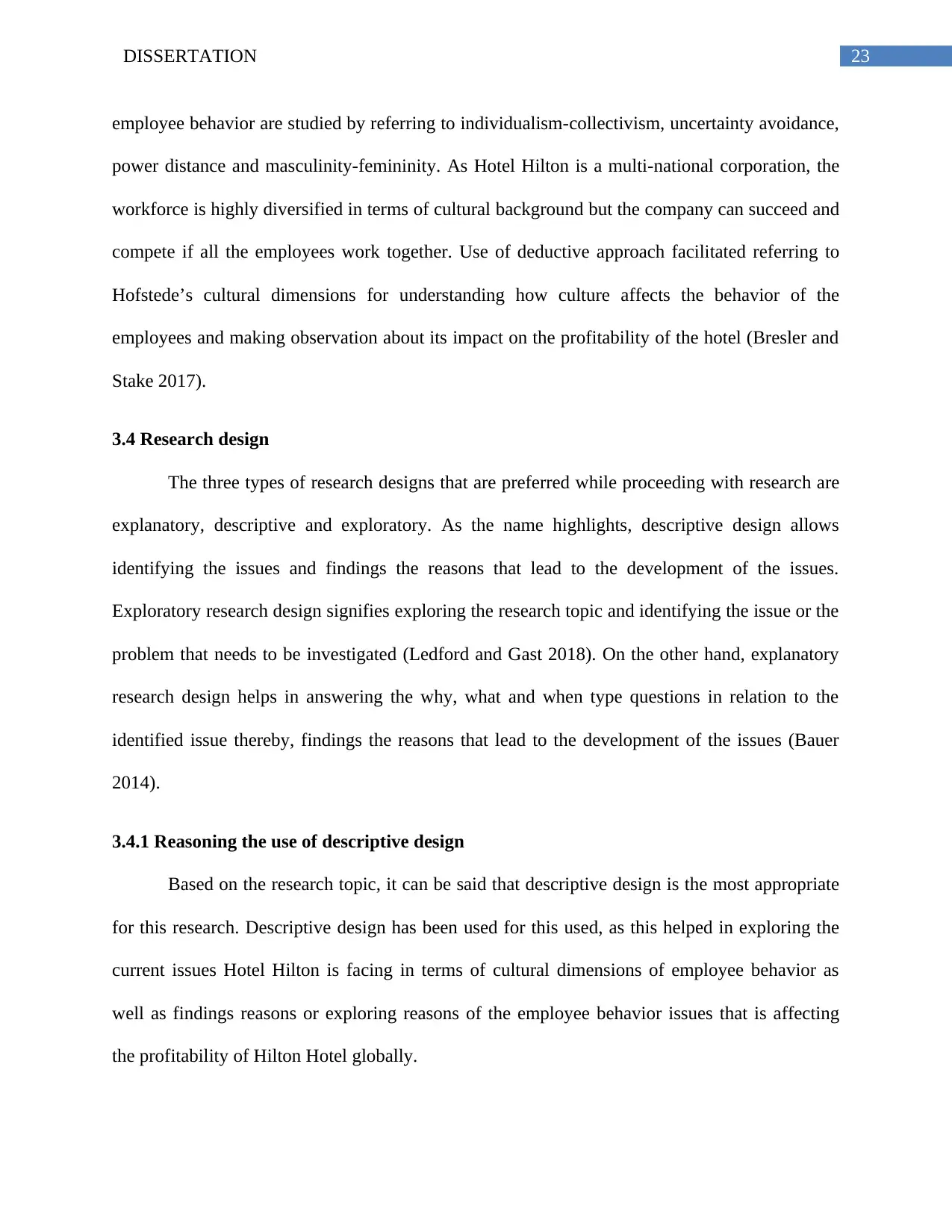
23DISSERTATION
employee behavior are studied by referring to individualism-collectivism, uncertainty avoidance,
power distance and masculinity-femininity. As Hotel Hilton is a multi-national corporation, the
workforce is highly diversified in terms of cultural background but the company can succeed and
compete if all the employees work together. Use of deductive approach facilitated referring to
Hofstede’s cultural dimensions for understanding how culture affects the behavior of the
employees and making observation about its impact on the profitability of the hotel (Bresler and
Stake 2017).
3.4 Research design
The three types of research designs that are preferred while proceeding with research are
explanatory, descriptive and exploratory. As the name highlights, descriptive design allows
identifying the issues and findings the reasons that lead to the development of the issues.
Exploratory research design signifies exploring the research topic and identifying the issue or the
problem that needs to be investigated (Ledford and Gast 2018). On the other hand, explanatory
research design helps in answering the why, what and when type questions in relation to the
identified issue thereby, findings the reasons that lead to the development of the issues (Bauer
2014).
3.4.1 Reasoning the use of descriptive design
Based on the research topic, it can be said that descriptive design is the most appropriate
for this research. Descriptive design has been used for this used, as this helped in exploring the
current issues Hotel Hilton is facing in terms of cultural dimensions of employee behavior as
well as findings reasons or exploring reasons of the employee behavior issues that is affecting
the profitability of Hilton Hotel globally.
employee behavior are studied by referring to individualism-collectivism, uncertainty avoidance,
power distance and masculinity-femininity. As Hotel Hilton is a multi-national corporation, the
workforce is highly diversified in terms of cultural background but the company can succeed and
compete if all the employees work together. Use of deductive approach facilitated referring to
Hofstede’s cultural dimensions for understanding how culture affects the behavior of the
employees and making observation about its impact on the profitability of the hotel (Bresler and
Stake 2017).
3.4 Research design
The three types of research designs that are preferred while proceeding with research are
explanatory, descriptive and exploratory. As the name highlights, descriptive design allows
identifying the issues and findings the reasons that lead to the development of the issues.
Exploratory research design signifies exploring the research topic and identifying the issue or the
problem that needs to be investigated (Ledford and Gast 2018). On the other hand, explanatory
research design helps in answering the why, what and when type questions in relation to the
identified issue thereby, findings the reasons that lead to the development of the issues (Bauer
2014).
3.4.1 Reasoning the use of descriptive design
Based on the research topic, it can be said that descriptive design is the most appropriate
for this research. Descriptive design has been used for this used, as this helped in exploring the
current issues Hotel Hilton is facing in terms of cultural dimensions of employee behavior as
well as findings reasons or exploring reasons of the employee behavior issues that is affecting
the profitability of Hilton Hotel globally.
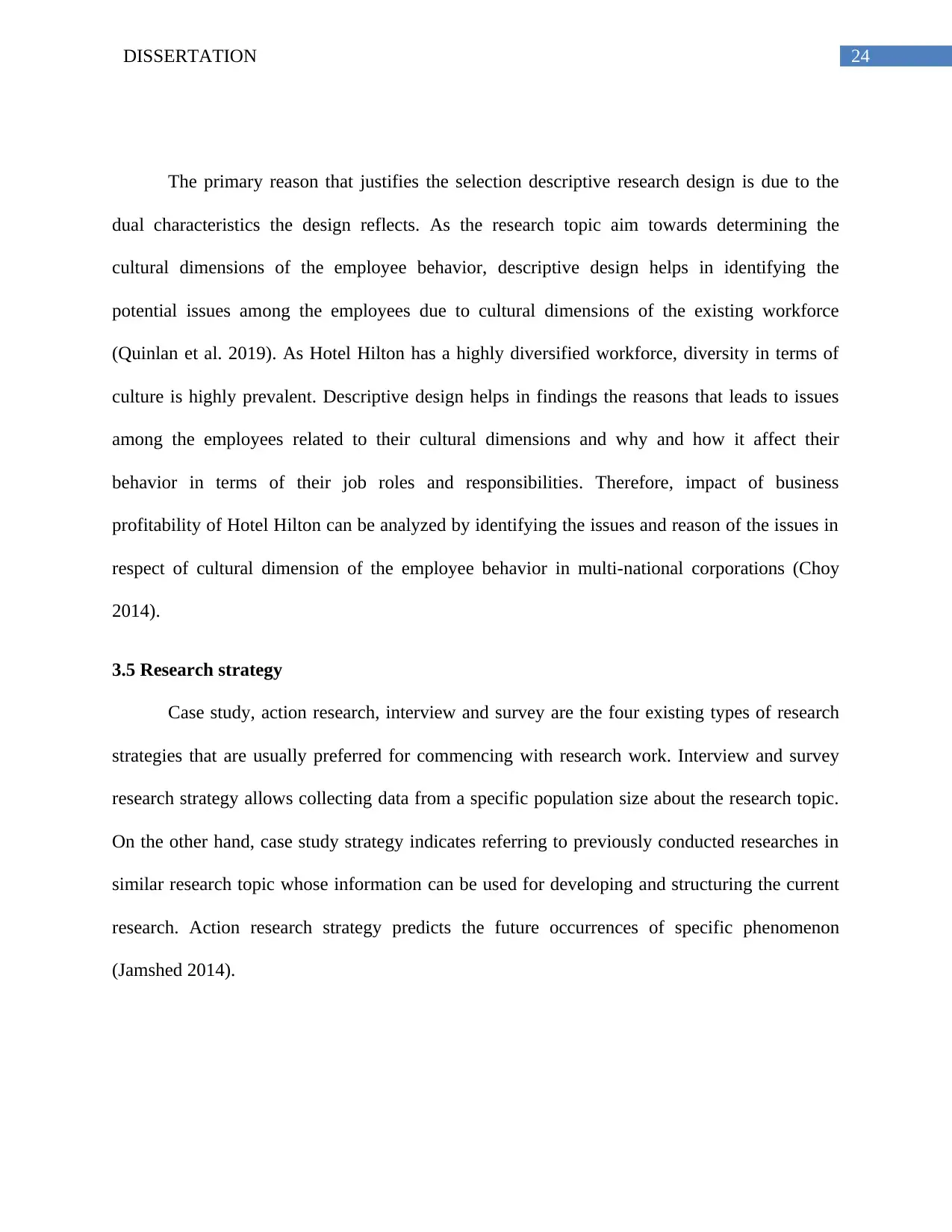
24DISSERTATION
The primary reason that justifies the selection descriptive research design is due to the
dual characteristics the design reflects. As the research topic aim towards determining the
cultural dimensions of the employee behavior, descriptive design helps in identifying the
potential issues among the employees due to cultural dimensions of the existing workforce
(Quinlan et al. 2019). As Hotel Hilton has a highly diversified workforce, diversity in terms of
culture is highly prevalent. Descriptive design helps in findings the reasons that leads to issues
among the employees related to their cultural dimensions and why and how it affect their
behavior in terms of their job roles and responsibilities. Therefore, impact of business
profitability of Hotel Hilton can be analyzed by identifying the issues and reason of the issues in
respect of cultural dimension of the employee behavior in multi-national corporations (Choy
2014).
3.5 Research strategy
Case study, action research, interview and survey are the four existing types of research
strategies that are usually preferred for commencing with research work. Interview and survey
research strategy allows collecting data from a specific population size about the research topic.
On the other hand, case study strategy indicates referring to previously conducted researches in
similar research topic whose information can be used for developing and structuring the current
research. Action research strategy predicts the future occurrences of specific phenomenon
(Jamshed 2014).
The primary reason that justifies the selection descriptive research design is due to the
dual characteristics the design reflects. As the research topic aim towards determining the
cultural dimensions of the employee behavior, descriptive design helps in identifying the
potential issues among the employees due to cultural dimensions of the existing workforce
(Quinlan et al. 2019). As Hotel Hilton has a highly diversified workforce, diversity in terms of
culture is highly prevalent. Descriptive design helps in findings the reasons that leads to issues
among the employees related to their cultural dimensions and why and how it affect their
behavior in terms of their job roles and responsibilities. Therefore, impact of business
profitability of Hotel Hilton can be analyzed by identifying the issues and reason of the issues in
respect of cultural dimension of the employee behavior in multi-national corporations (Choy
2014).
3.5 Research strategy
Case study, action research, interview and survey are the four existing types of research
strategies that are usually preferred for commencing with research work. Interview and survey
research strategy allows collecting data from a specific population size about the research topic.
On the other hand, case study strategy indicates referring to previously conducted researches in
similar research topic whose information can be used for developing and structuring the current
research. Action research strategy predicts the future occurrences of specific phenomenon
(Jamshed 2014).
Paraphrase This Document
Need a fresh take? Get an instant paraphrase of this document with our AI Paraphraser
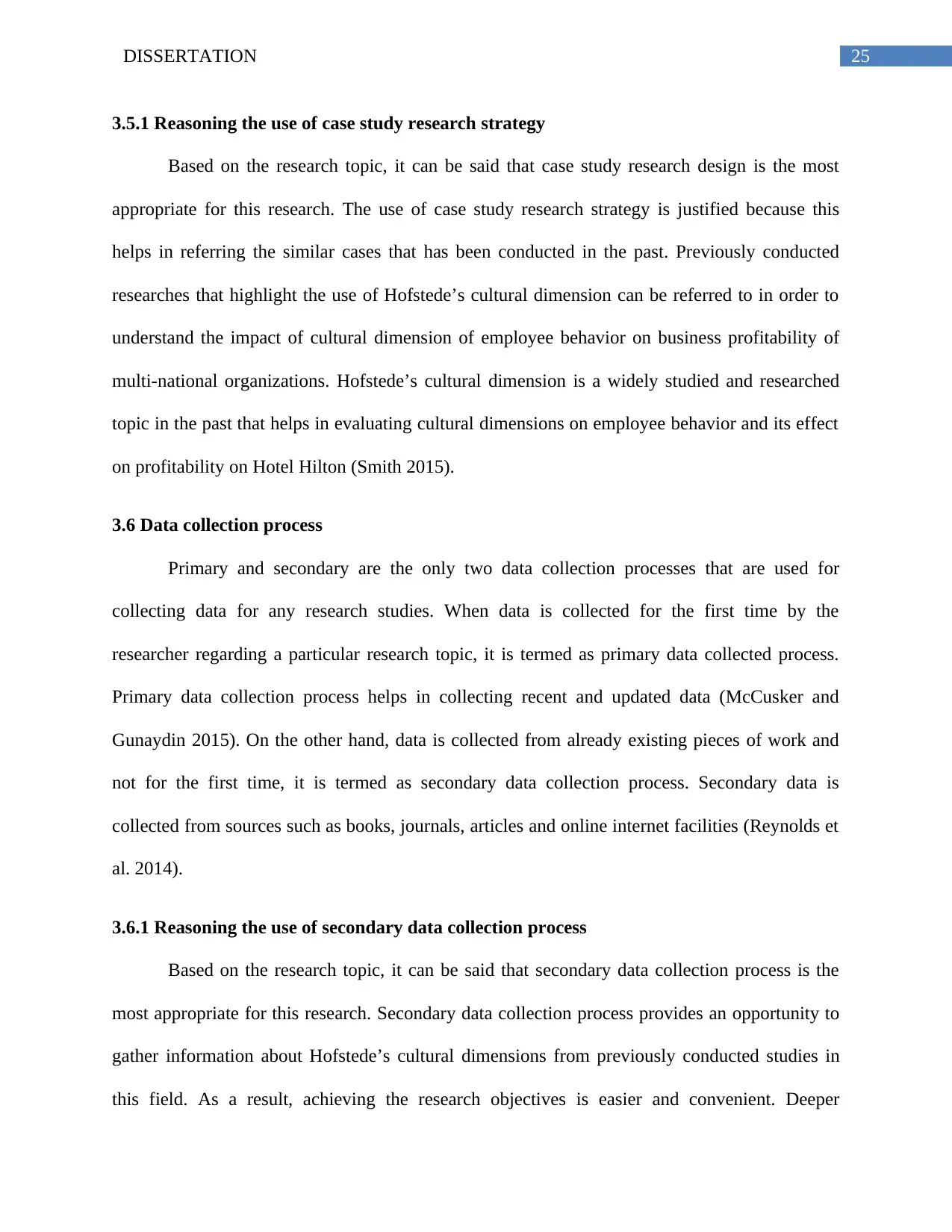
25DISSERTATION
3.5.1 Reasoning the use of case study research strategy
Based on the research topic, it can be said that case study research design is the most
appropriate for this research. The use of case study research strategy is justified because this
helps in referring the similar cases that has been conducted in the past. Previously conducted
researches that highlight the use of Hofstede’s cultural dimension can be referred to in order to
understand the impact of cultural dimension of employee behavior on business profitability of
multi-national organizations. Hofstede’s cultural dimension is a widely studied and researched
topic in the past that helps in evaluating cultural dimensions on employee behavior and its effect
on profitability on Hotel Hilton (Smith 2015).
3.6 Data collection process
Primary and secondary are the only two data collection processes that are used for
collecting data for any research studies. When data is collected for the first time by the
researcher regarding a particular research topic, it is termed as primary data collected process.
Primary data collection process helps in collecting recent and updated data (McCusker and
Gunaydin 2015). On the other hand, data is collected from already existing pieces of work and
not for the first time, it is termed as secondary data collection process. Secondary data is
collected from sources such as books, journals, articles and online internet facilities (Reynolds et
al. 2014).
3.6.1 Reasoning the use of secondary data collection process
Based on the research topic, it can be said that secondary data collection process is the
most appropriate for this research. Secondary data collection process provides an opportunity to
gather information about Hofstede’s cultural dimensions from previously conducted studies in
this field. As a result, achieving the research objectives is easier and convenient. Deeper
3.5.1 Reasoning the use of case study research strategy
Based on the research topic, it can be said that case study research design is the most
appropriate for this research. The use of case study research strategy is justified because this
helps in referring the similar cases that has been conducted in the past. Previously conducted
researches that highlight the use of Hofstede’s cultural dimension can be referred to in order to
understand the impact of cultural dimension of employee behavior on business profitability of
multi-national organizations. Hofstede’s cultural dimension is a widely studied and researched
topic in the past that helps in evaluating cultural dimensions on employee behavior and its effect
on profitability on Hotel Hilton (Smith 2015).
3.6 Data collection process
Primary and secondary are the only two data collection processes that are used for
collecting data for any research studies. When data is collected for the first time by the
researcher regarding a particular research topic, it is termed as primary data collected process.
Primary data collection process helps in collecting recent and updated data (McCusker and
Gunaydin 2015). On the other hand, data is collected from already existing pieces of work and
not for the first time, it is termed as secondary data collection process. Secondary data is
collected from sources such as books, journals, articles and online internet facilities (Reynolds et
al. 2014).
3.6.1 Reasoning the use of secondary data collection process
Based on the research topic, it can be said that secondary data collection process is the
most appropriate for this research. Secondary data collection process provides an opportunity to
gather information about Hofstede’s cultural dimensions from previously conducted studies in
this field. As a result, achieving the research objectives is easier and convenient. Deeper

26DISSERTATION
understanding about Hofstede’s cultural dimension can be developed along with critically
analyzing the impact of cultural dimension of employee behavior on business profitability for
Hotel Hilton by referring to previously conducted case studies in similar research topic (Isaacs
2014).
3.7 Data analysis technique
Two types of data analysis techniques are quantitative and qualitative data analysis
techniques. As the name reflects, quantitative data analysis technique technique analyzes the data
by considering the numerical aspect of the opinions. The data is presented in the forms of
percentages, numbers and averages and is presented by using graphs and charts (Mukhopadhyay
and Gupta 2014). On the other hand, qualitative data analysis focuses on discussing, critically
analyzing and explaining the opinions and views of different authors about a specific research
topic and factors associated with it that has an impact on each other.
3.7.1 Reasoning the use of qualitative data analysis technique
Based on the research topic, it can be said that qualitative data analysis technique is the
most appropriate for this research. Qualitative data analysis technique in this case helped in
investigating cultural dimensions of employee behavior by developing relevant themes. The
themes were analyzed critically by mentioning and explaining the opinions and views of
different authors about its impact on business profitability for various multi-national corporations
including Hotel Hilton followed by making own assumptions and supporting it with releant
information (Mackert et al. 2014).
understanding about Hofstede’s cultural dimension can be developed along with critically
analyzing the impact of cultural dimension of employee behavior on business profitability for
Hotel Hilton by referring to previously conducted case studies in similar research topic (Isaacs
2014).
3.7 Data analysis technique
Two types of data analysis techniques are quantitative and qualitative data analysis
techniques. As the name reflects, quantitative data analysis technique technique analyzes the data
by considering the numerical aspect of the opinions. The data is presented in the forms of
percentages, numbers and averages and is presented by using graphs and charts (Mukhopadhyay
and Gupta 2014). On the other hand, qualitative data analysis focuses on discussing, critically
analyzing and explaining the opinions and views of different authors about a specific research
topic and factors associated with it that has an impact on each other.
3.7.1 Reasoning the use of qualitative data analysis technique
Based on the research topic, it can be said that qualitative data analysis technique is the
most appropriate for this research. Qualitative data analysis technique in this case helped in
investigating cultural dimensions of employee behavior by developing relevant themes. The
themes were analyzed critically by mentioning and explaining the opinions and views of
different authors about its impact on business profitability for various multi-national corporations
including Hotel Hilton followed by making own assumptions and supporting it with releant
information (Mackert et al. 2014).
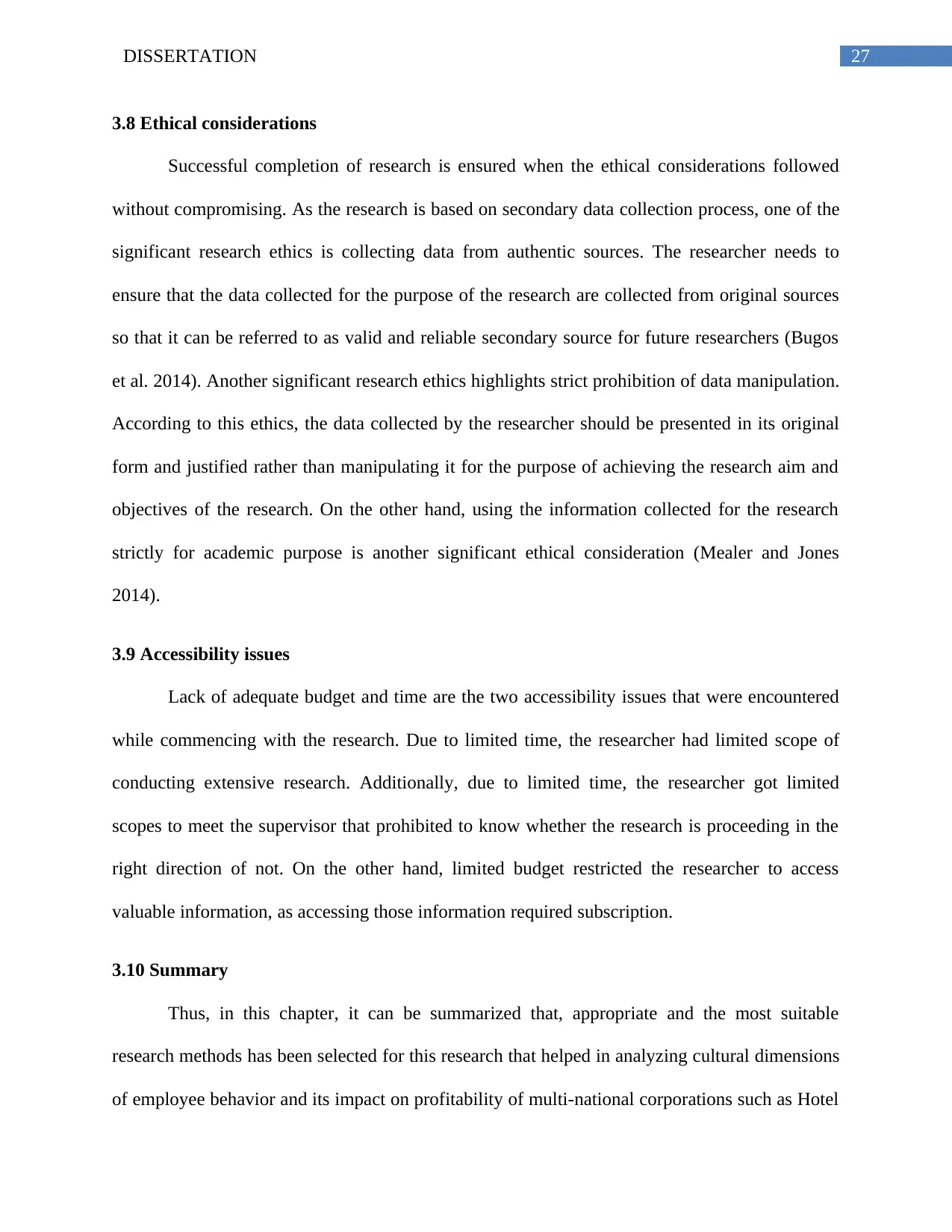
27DISSERTATION
3.8 Ethical considerations
Successful completion of research is ensured when the ethical considerations followed
without compromising. As the research is based on secondary data collection process, one of the
significant research ethics is collecting data from authentic sources. The researcher needs to
ensure that the data collected for the purpose of the research are collected from original sources
so that it can be referred to as valid and reliable secondary source for future researchers (Bugos
et al. 2014). Another significant research ethics highlights strict prohibition of data manipulation.
According to this ethics, the data collected by the researcher should be presented in its original
form and justified rather than manipulating it for the purpose of achieving the research aim and
objectives of the research. On the other hand, using the information collected for the research
strictly for academic purpose is another significant ethical consideration (Mealer and Jones
2014).
3.9 Accessibility issues
Lack of adequate budget and time are the two accessibility issues that were encountered
while commencing with the research. Due to limited time, the researcher had limited scope of
conducting extensive research. Additionally, due to limited time, the researcher got limited
scopes to meet the supervisor that prohibited to know whether the research is proceeding in the
right direction of not. On the other hand, limited budget restricted the researcher to access
valuable information, as accessing those information required subscription.
3.10 Summary
Thus, in this chapter, it can be summarized that, appropriate and the most suitable
research methods has been selected for this research that helped in analyzing cultural dimensions
of employee behavior and its impact on profitability of multi-national corporations such as Hotel
3.8 Ethical considerations
Successful completion of research is ensured when the ethical considerations followed
without compromising. As the research is based on secondary data collection process, one of the
significant research ethics is collecting data from authentic sources. The researcher needs to
ensure that the data collected for the purpose of the research are collected from original sources
so that it can be referred to as valid and reliable secondary source for future researchers (Bugos
et al. 2014). Another significant research ethics highlights strict prohibition of data manipulation.
According to this ethics, the data collected by the researcher should be presented in its original
form and justified rather than manipulating it for the purpose of achieving the research aim and
objectives of the research. On the other hand, using the information collected for the research
strictly for academic purpose is another significant ethical consideration (Mealer and Jones
2014).
3.9 Accessibility issues
Lack of adequate budget and time are the two accessibility issues that were encountered
while commencing with the research. Due to limited time, the researcher had limited scope of
conducting extensive research. Additionally, due to limited time, the researcher got limited
scopes to meet the supervisor that prohibited to know whether the research is proceeding in the
right direction of not. On the other hand, limited budget restricted the researcher to access
valuable information, as accessing those information required subscription.
3.10 Summary
Thus, in this chapter, it can be summarized that, appropriate and the most suitable
research methods has been selected for this research that helped in analyzing cultural dimensions
of employee behavior and its impact on profitability of multi-national corporations such as Hotel
Secure Best Marks with AI Grader
Need help grading? Try our AI Grader for instant feedback on your assignments.
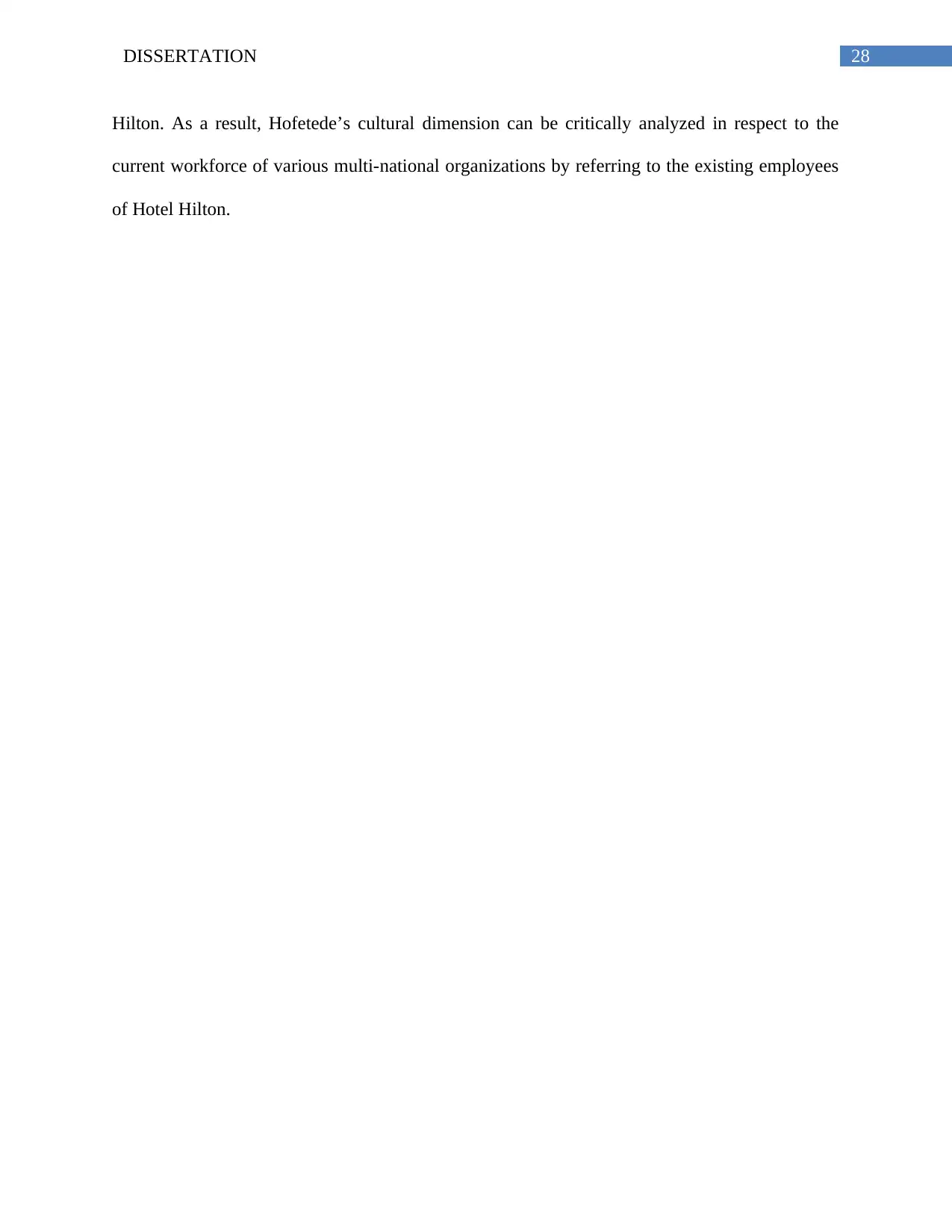
28DISSERTATION
Hilton. As a result, Hofetede’s cultural dimension can be critically analyzed in respect to the
current workforce of various multi-national organizations by referring to the existing employees
of Hotel Hilton.
Hilton. As a result, Hofetede’s cultural dimension can be critically analyzed in respect to the
current workforce of various multi-national organizations by referring to the existing employees
of Hotel Hilton.
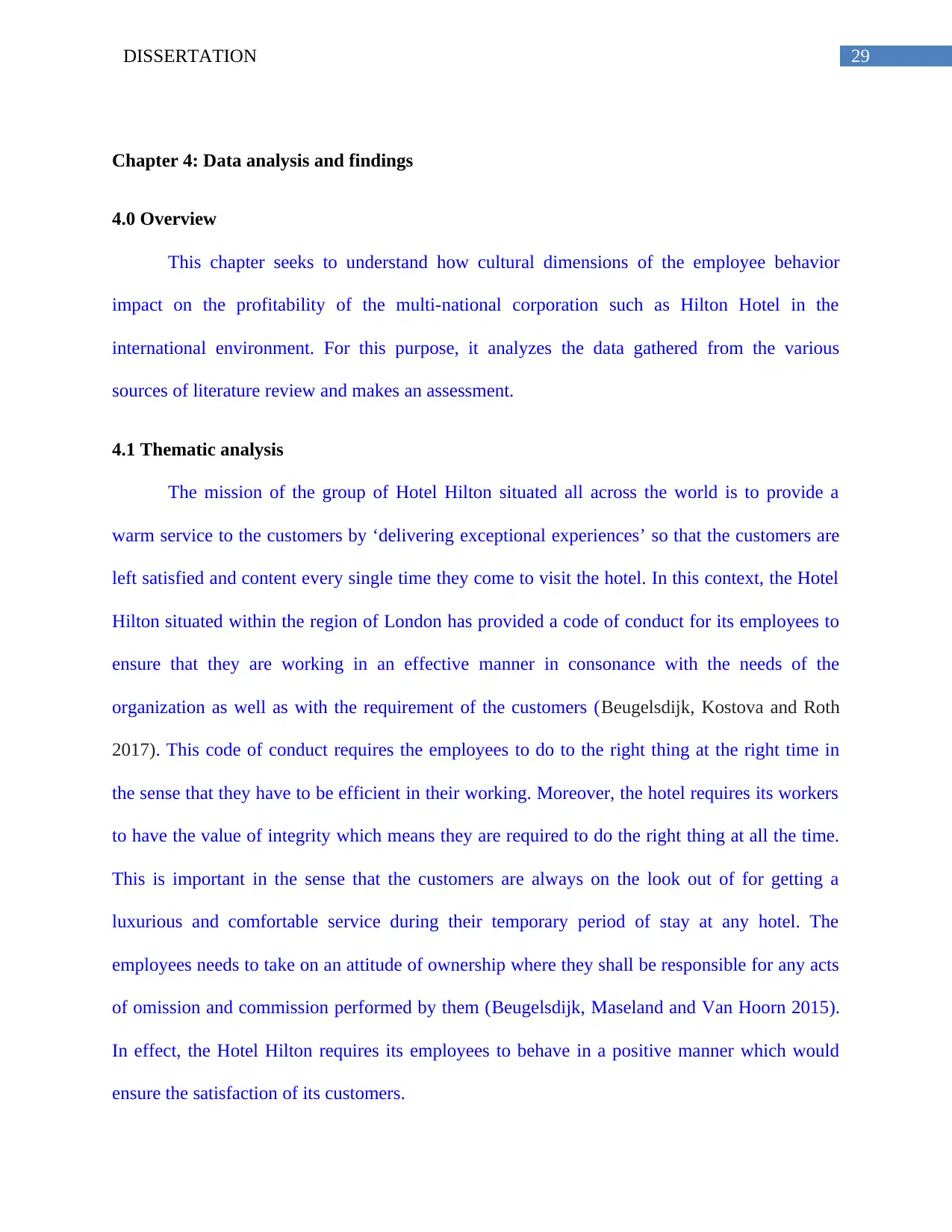
29DISSERTATION
Chapter 4: Data analysis and findings
4.0 Overview
This chapter seeks to understand how cultural dimensions of the employee behavior
impact on the profitability of the multi-national corporation such as Hilton Hotel in the
international environment. For this purpose, it analyzes the data gathered from the various
sources of literature review and makes an assessment.
4.1 Thematic analysis
The mission of the group of Hotel Hilton situated all across the world is to provide a
warm service to the customers by ‘delivering exceptional experiences’ so that the customers are
left satisfied and content every single time they come to visit the hotel. In this context, the Hotel
Hilton situated within the region of London has provided a code of conduct for its employees to
ensure that they are working in an effective manner in consonance with the needs of the
organization as well as with the requirement of the customers (Beugelsdijk, Kostova and Roth
2017). This code of conduct requires the employees to do to the right thing at the right time in
the sense that they have to be efficient in their working. Moreover, the hotel requires its workers
to have the value of integrity which means they are required to do the right thing at all the time.
This is important in the sense that the customers are always on the look out of for getting a
luxurious and comfortable service during their temporary period of stay at any hotel. The
employees needs to take on an attitude of ownership where they shall be responsible for any acts
of omission and commission performed by them (Beugelsdijk, Maseland and Van Hoorn 2015).
In effect, the Hotel Hilton requires its employees to behave in a positive manner which would
ensure the satisfaction of its customers.
Chapter 4: Data analysis and findings
4.0 Overview
This chapter seeks to understand how cultural dimensions of the employee behavior
impact on the profitability of the multi-national corporation such as Hilton Hotel in the
international environment. For this purpose, it analyzes the data gathered from the various
sources of literature review and makes an assessment.
4.1 Thematic analysis
The mission of the group of Hotel Hilton situated all across the world is to provide a
warm service to the customers by ‘delivering exceptional experiences’ so that the customers are
left satisfied and content every single time they come to visit the hotel. In this context, the Hotel
Hilton situated within the region of London has provided a code of conduct for its employees to
ensure that they are working in an effective manner in consonance with the needs of the
organization as well as with the requirement of the customers (Beugelsdijk, Kostova and Roth
2017). This code of conduct requires the employees to do to the right thing at the right time in
the sense that they have to be efficient in their working. Moreover, the hotel requires its workers
to have the value of integrity which means they are required to do the right thing at all the time.
This is important in the sense that the customers are always on the look out of for getting a
luxurious and comfortable service during their temporary period of stay at any hotel. The
employees needs to take on an attitude of ownership where they shall be responsible for any acts
of omission and commission performed by them (Beugelsdijk, Maseland and Van Hoorn 2015).
In effect, the Hotel Hilton requires its employees to behave in a positive manner which would
ensure the satisfaction of its customers.
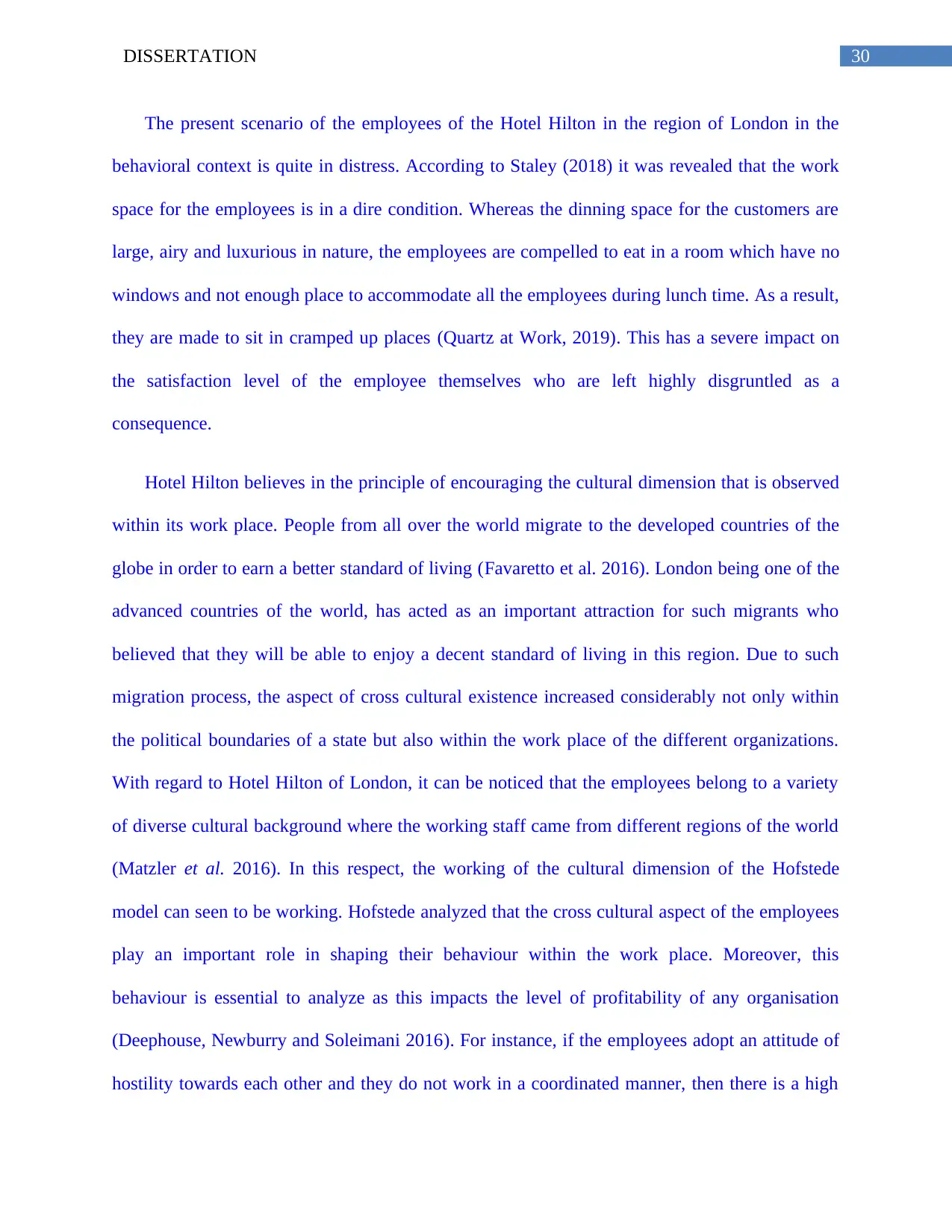
30DISSERTATION
The present scenario of the employees of the Hotel Hilton in the region of London in the
behavioral context is quite in distress. According to Staley (2018) it was revealed that the work
space for the employees is in a dire condition. Whereas the dinning space for the customers are
large, airy and luxurious in nature, the employees are compelled to eat in a room which have no
windows and not enough place to accommodate all the employees during lunch time. As a result,
they are made to sit in cramped up places (Quartz at Work, 2019). This has a severe impact on
the satisfaction level of the employee themselves who are left highly disgruntled as a
consequence.
Hotel Hilton believes in the principle of encouraging the cultural dimension that is observed
within its work place. People from all over the world migrate to the developed countries of the
globe in order to earn a better standard of living (Favaretto et al. 2016). London being one of the
advanced countries of the world, has acted as an important attraction for such migrants who
believed that they will be able to enjoy a decent standard of living in this region. Due to such
migration process, the aspect of cross cultural existence increased considerably not only within
the political boundaries of a state but also within the work place of the different organizations.
With regard to Hotel Hilton of London, it can be noticed that the employees belong to a variety
of diverse cultural background where the working staff came from different regions of the world
(Matzler et al. 2016). In this respect, the working of the cultural dimension of the Hofstede
model can seen to be working. Hofstede analyzed that the cross cultural aspect of the employees
play an important role in shaping their behaviour within the work place. Moreover, this
behaviour is essential to analyze as this impacts the level of profitability of any organisation
(Deephouse, Newburry and Soleimani 2016). For instance, if the employees adopt an attitude of
hostility towards each other and they do not work in a coordinated manner, then there is a high
The present scenario of the employees of the Hotel Hilton in the region of London in the
behavioral context is quite in distress. According to Staley (2018) it was revealed that the work
space for the employees is in a dire condition. Whereas the dinning space for the customers are
large, airy and luxurious in nature, the employees are compelled to eat in a room which have no
windows and not enough place to accommodate all the employees during lunch time. As a result,
they are made to sit in cramped up places (Quartz at Work, 2019). This has a severe impact on
the satisfaction level of the employee themselves who are left highly disgruntled as a
consequence.
Hotel Hilton believes in the principle of encouraging the cultural dimension that is observed
within its work place. People from all over the world migrate to the developed countries of the
globe in order to earn a better standard of living (Favaretto et al. 2016). London being one of the
advanced countries of the world, has acted as an important attraction for such migrants who
believed that they will be able to enjoy a decent standard of living in this region. Due to such
migration process, the aspect of cross cultural existence increased considerably not only within
the political boundaries of a state but also within the work place of the different organizations.
With regard to Hotel Hilton of London, it can be noticed that the employees belong to a variety
of diverse cultural background where the working staff came from different regions of the world
(Matzler et al. 2016). In this respect, the working of the cultural dimension of the Hofstede
model can seen to be working. Hofstede analyzed that the cross cultural aspect of the employees
play an important role in shaping their behaviour within the work place. Moreover, this
behaviour is essential to analyze as this impacts the level of profitability of any organisation
(Deephouse, Newburry and Soleimani 2016). For instance, if the employees adopt an attitude of
hostility towards each other and they do not work in a coordinated manner, then there is a high
Paraphrase This Document
Need a fresh take? Get an instant paraphrase of this document with our AI Paraphraser
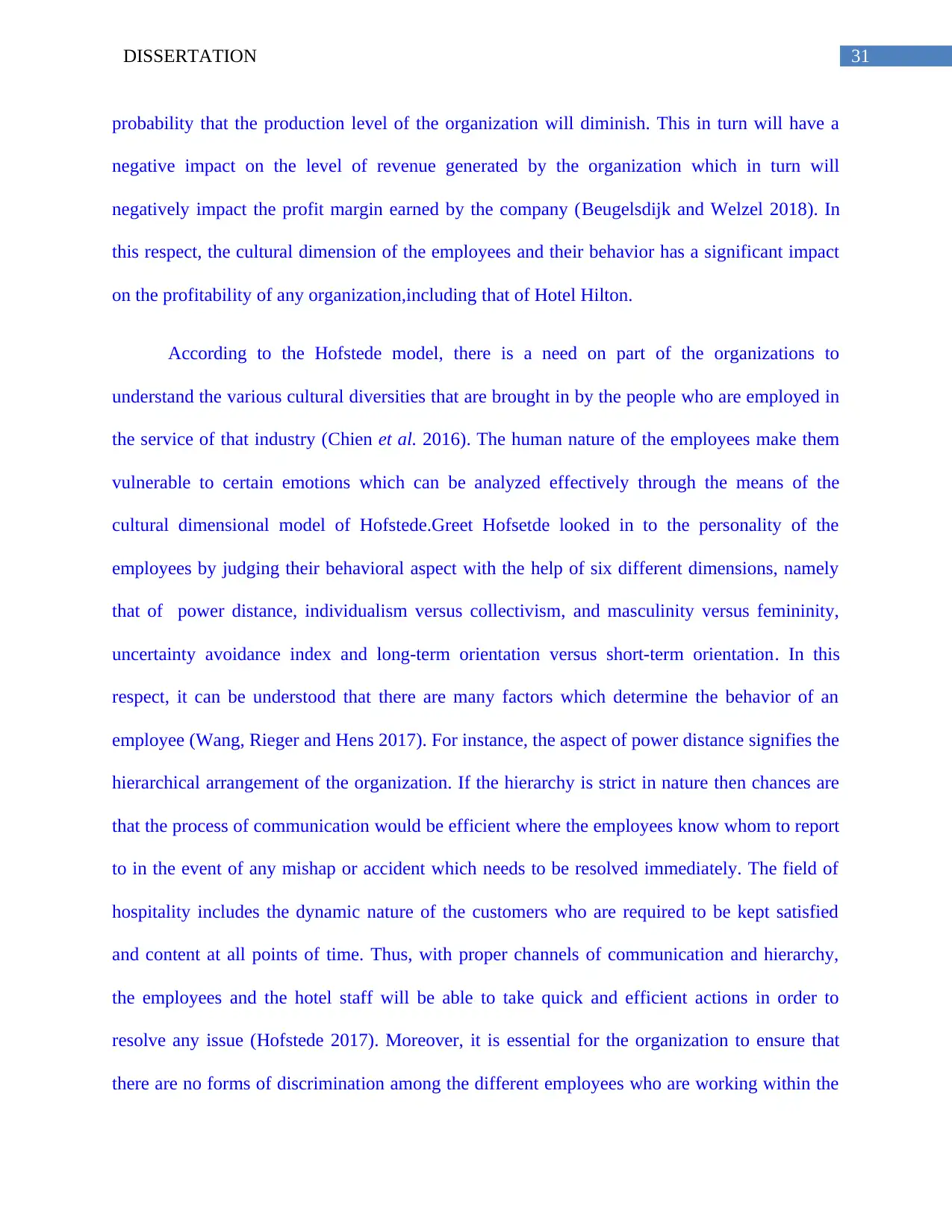
31DISSERTATION
probability that the production level of the organization will diminish. This in turn will have a
negative impact on the level of revenue generated by the organization which in turn will
negatively impact the profit margin earned by the company (Beugelsdijk and Welzel 2018). In
this respect, the cultural dimension of the employees and their behavior has a significant impact
on the profitability of any organization,including that of Hotel Hilton.
According to the Hofstede model, there is a need on part of the organizations to
understand the various cultural diversities that are brought in by the people who are employed in
the service of that industry (Chien et al. 2016). The human nature of the employees make them
vulnerable to certain emotions which can be analyzed effectively through the means of the
cultural dimensional model of Hofstede.Greet Hofsetde looked in to the personality of the
employees by judging their behavioral aspect with the help of six different dimensions, namely
that of power distance, individualism versus collectivism, and masculinity versus femininity,
uncertainty avoidance index and long-term orientation versus short-term orientation. In this
respect, it can be understood that there are many factors which determine the behavior of an
employee (Wang, Rieger and Hens 2017). For instance, the aspect of power distance signifies the
hierarchical arrangement of the organization. If the hierarchy is strict in nature then chances are
that the process of communication would be efficient where the employees know whom to report
to in the event of any mishap or accident which needs to be resolved immediately. The field of
hospitality includes the dynamic nature of the customers who are required to be kept satisfied
and content at all points of time. Thus, with proper channels of communication and hierarchy,
the employees and the hotel staff will be able to take quick and efficient actions in order to
resolve any issue (Hofstede 2017). Moreover, it is essential for the organization to ensure that
there are no forms of discrimination among the different employees who are working within the
probability that the production level of the organization will diminish. This in turn will have a
negative impact on the level of revenue generated by the organization which in turn will
negatively impact the profit margin earned by the company (Beugelsdijk and Welzel 2018). In
this respect, the cultural dimension of the employees and their behavior has a significant impact
on the profitability of any organization,including that of Hotel Hilton.
According to the Hofstede model, there is a need on part of the organizations to
understand the various cultural diversities that are brought in by the people who are employed in
the service of that industry (Chien et al. 2016). The human nature of the employees make them
vulnerable to certain emotions which can be analyzed effectively through the means of the
cultural dimensional model of Hofstede.Greet Hofsetde looked in to the personality of the
employees by judging their behavioral aspect with the help of six different dimensions, namely
that of power distance, individualism versus collectivism, and masculinity versus femininity,
uncertainty avoidance index and long-term orientation versus short-term orientation. In this
respect, it can be understood that there are many factors which determine the behavior of an
employee (Wang, Rieger and Hens 2017). For instance, the aspect of power distance signifies the
hierarchical arrangement of the organization. If the hierarchy is strict in nature then chances are
that the process of communication would be efficient where the employees know whom to report
to in the event of any mishap or accident which needs to be resolved immediately. The field of
hospitality includes the dynamic nature of the customers who are required to be kept satisfied
and content at all points of time. Thus, with proper channels of communication and hierarchy,
the employees and the hotel staff will be able to take quick and efficient actions in order to
resolve any issue (Hofstede 2017). Moreover, it is essential for the organization to ensure that
there are no forms of discrimination among the different employees who are working within the
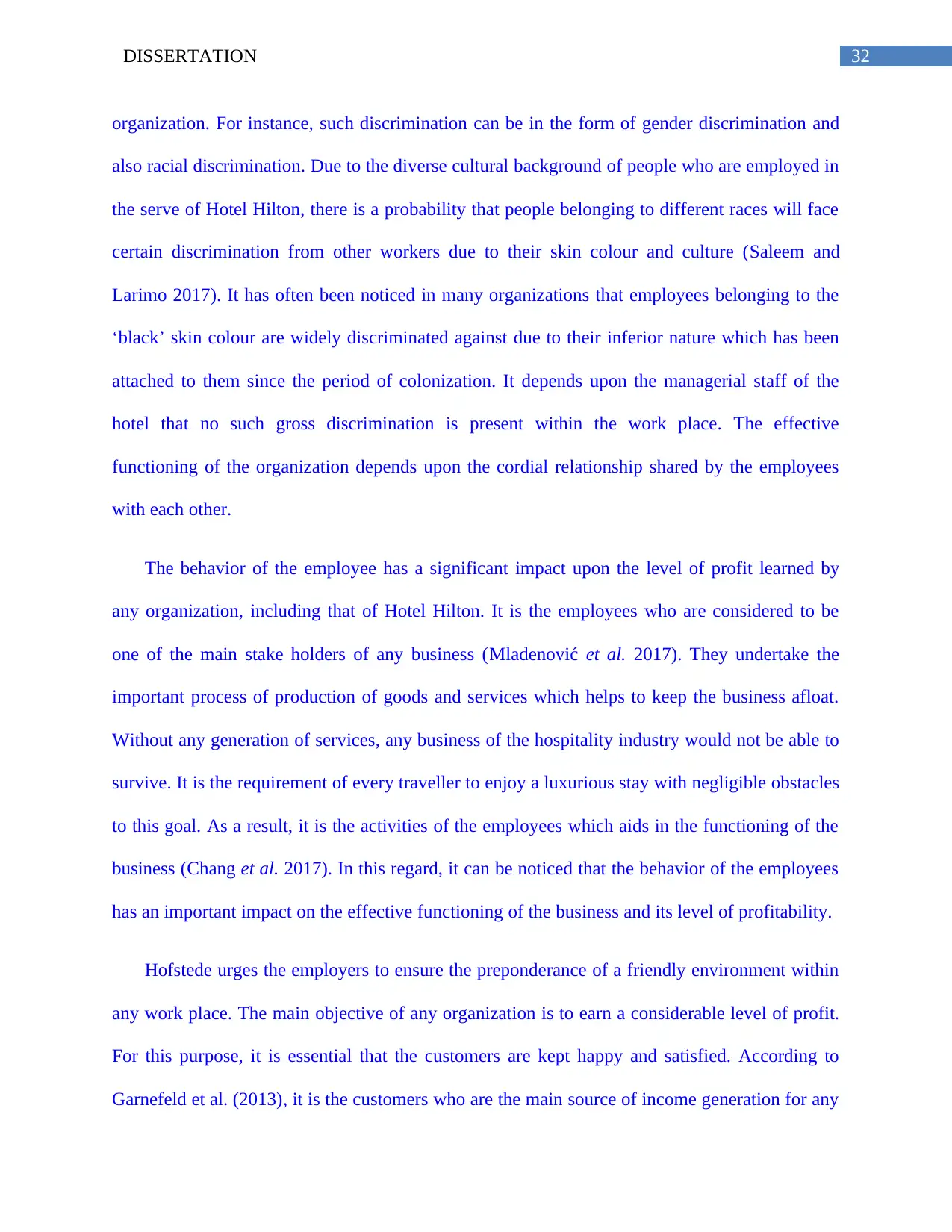
32DISSERTATION
organization. For instance, such discrimination can be in the form of gender discrimination and
also racial discrimination. Due to the diverse cultural background of people who are employed in
the serve of Hotel Hilton, there is a probability that people belonging to different races will face
certain discrimination from other workers due to their skin colour and culture (Saleem and
Larimo 2017). It has often been noticed in many organizations that employees belonging to the
‘black’ skin colour are widely discriminated against due to their inferior nature which has been
attached to them since the period of colonization. It depends upon the managerial staff of the
hotel that no such gross discrimination is present within the work place. The effective
functioning of the organization depends upon the cordial relationship shared by the employees
with each other.
The behavior of the employee has a significant impact upon the level of profit learned by
any organization, including that of Hotel Hilton. It is the employees who are considered to be
one of the main stake holders of any business (Mladenović et al. 2017). They undertake the
important process of production of goods and services which helps to keep the business afloat.
Without any generation of services, any business of the hospitality industry would not be able to
survive. It is the requirement of every traveller to enjoy a luxurious stay with negligible obstacles
to this goal. As a result, it is the activities of the employees which aids in the functioning of the
business (Chang et al. 2017). In this regard, it can be noticed that the behavior of the employees
has an important impact on the effective functioning of the business and its level of profitability.
Hofstede urges the employers to ensure the preponderance of a friendly environment within
any work place. The main objective of any organization is to earn a considerable level of profit.
For this purpose, it is essential that the customers are kept happy and satisfied. According to
Garnefeld et al. (2013), it is the customers who are the main source of income generation for any
organization. For instance, such discrimination can be in the form of gender discrimination and
also racial discrimination. Due to the diverse cultural background of people who are employed in
the serve of Hotel Hilton, there is a probability that people belonging to different races will face
certain discrimination from other workers due to their skin colour and culture (Saleem and
Larimo 2017). It has often been noticed in many organizations that employees belonging to the
‘black’ skin colour are widely discriminated against due to their inferior nature which has been
attached to them since the period of colonization. It depends upon the managerial staff of the
hotel that no such gross discrimination is present within the work place. The effective
functioning of the organization depends upon the cordial relationship shared by the employees
with each other.
The behavior of the employee has a significant impact upon the level of profit learned by
any organization, including that of Hotel Hilton. It is the employees who are considered to be
one of the main stake holders of any business (Mladenović et al. 2017). They undertake the
important process of production of goods and services which helps to keep the business afloat.
Without any generation of services, any business of the hospitality industry would not be able to
survive. It is the requirement of every traveller to enjoy a luxurious stay with negligible obstacles
to this goal. As a result, it is the activities of the employees which aids in the functioning of the
business (Chang et al. 2017). In this regard, it can be noticed that the behavior of the employees
has an important impact on the effective functioning of the business and its level of profitability.
Hofstede urges the employers to ensure the preponderance of a friendly environment within
any work place. The main objective of any organization is to earn a considerable level of profit.
For this purpose, it is essential that the customers are kept happy and satisfied. According to
Garnefeld et al. (2013), it is the customers who are the main source of income generation for any
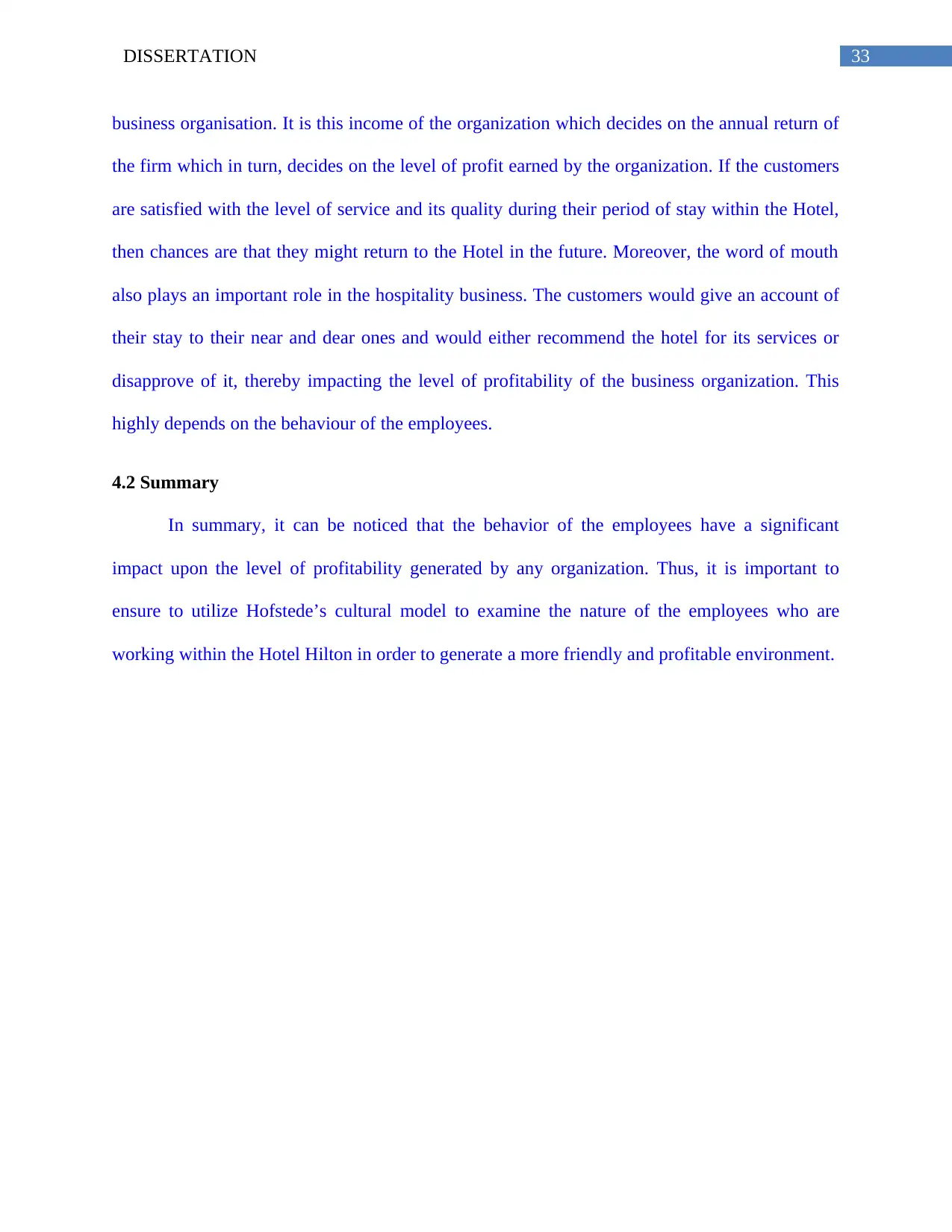
33DISSERTATION
business organisation. It is this income of the organization which decides on the annual return of
the firm which in turn, decides on the level of profit earned by the organization. If the customers
are satisfied with the level of service and its quality during their period of stay within the Hotel,
then chances are that they might return to the Hotel in the future. Moreover, the word of mouth
also plays an important role in the hospitality business. The customers would give an account of
their stay to their near and dear ones and would either recommend the hotel for its services or
disapprove of it, thereby impacting the level of profitability of the business organization. This
highly depends on the behaviour of the employees.
4.2 Summary
In summary, it can be noticed that the behavior of the employees have a significant
impact upon the level of profitability generated by any organization. Thus, it is important to
ensure to utilize Hofstede’s cultural model to examine the nature of the employees who are
working within the Hotel Hilton in order to generate a more friendly and profitable environment.
business organisation. It is this income of the organization which decides on the annual return of
the firm which in turn, decides on the level of profit earned by the organization. If the customers
are satisfied with the level of service and its quality during their period of stay within the Hotel,
then chances are that they might return to the Hotel in the future. Moreover, the word of mouth
also plays an important role in the hospitality business. The customers would give an account of
their stay to their near and dear ones and would either recommend the hotel for its services or
disapprove of it, thereby impacting the level of profitability of the business organization. This
highly depends on the behaviour of the employees.
4.2 Summary
In summary, it can be noticed that the behavior of the employees have a significant
impact upon the level of profitability generated by any organization. Thus, it is important to
ensure to utilize Hofstede’s cultural model to examine the nature of the employees who are
working within the Hotel Hilton in order to generate a more friendly and profitable environment.
Secure Best Marks with AI Grader
Need help grading? Try our AI Grader for instant feedback on your assignments.
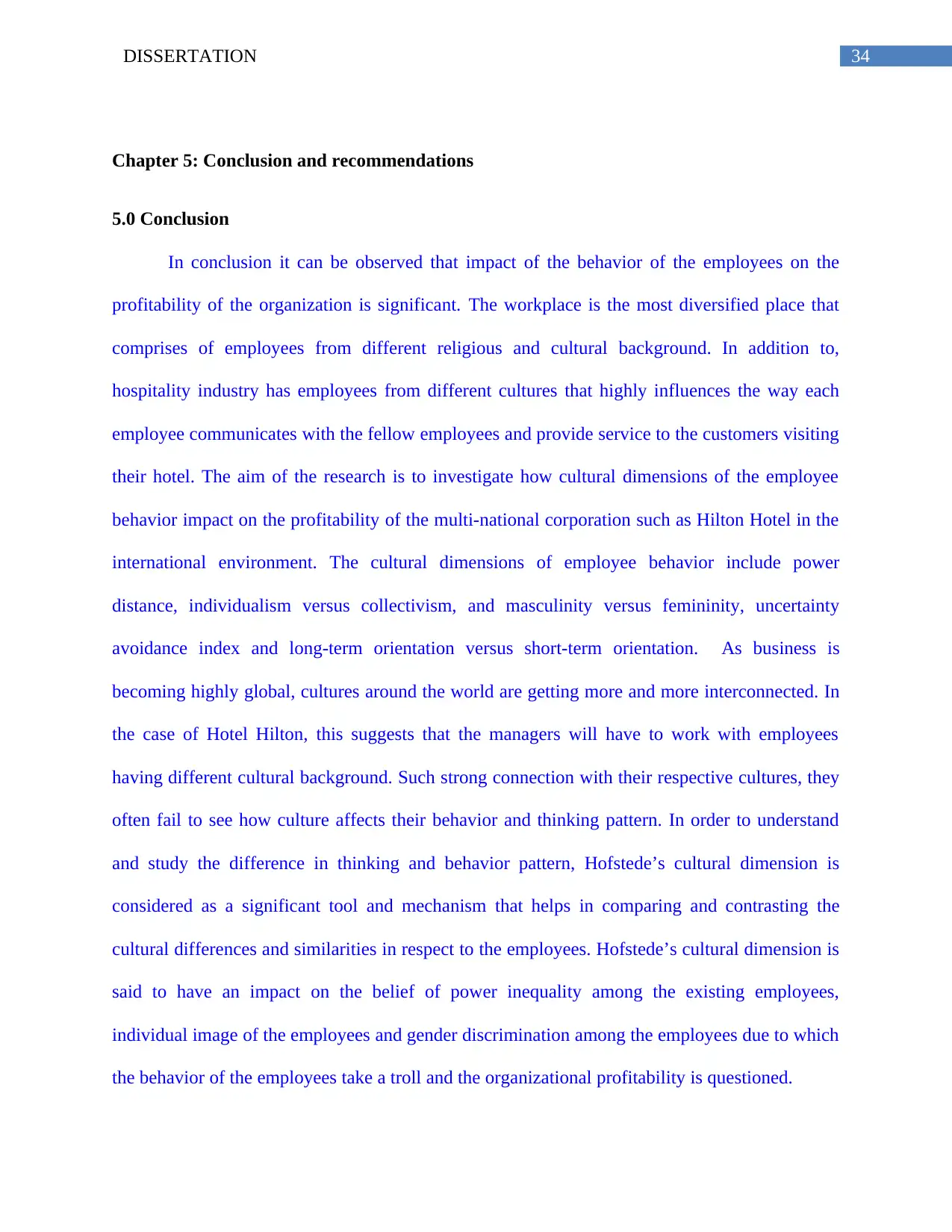
34DISSERTATION
Chapter 5: Conclusion and recommendations
5.0 Conclusion
In conclusion it can be observed that impact of the behavior of the employees on the
profitability of the organization is significant. The workplace is the most diversified place that
comprises of employees from different religious and cultural background. In addition to,
hospitality industry has employees from different cultures that highly influences the way each
employee communicates with the fellow employees and provide service to the customers visiting
their hotel. The aim of the research is to investigate how cultural dimensions of the employee
behavior impact on the profitability of the multi-national corporation such as Hilton Hotel in the
international environment. The cultural dimensions of employee behavior include power
distance, individualism versus collectivism, and masculinity versus femininity, uncertainty
avoidance index and long-term orientation versus short-term orientation. As business is
becoming highly global, cultures around the world are getting more and more interconnected. In
the case of Hotel Hilton, this suggests that the managers will have to work with employees
having different cultural background. Such strong connection with their respective cultures, they
often fail to see how culture affects their behavior and thinking pattern. In order to understand
and study the difference in thinking and behavior pattern, Hofstede’s cultural dimension is
considered as a significant tool and mechanism that helps in comparing and contrasting the
cultural differences and similarities in respect to the employees. Hofstede’s cultural dimension is
said to have an impact on the belief of power inequality among the existing employees,
individual image of the employees and gender discrimination among the employees due to which
the behavior of the employees take a troll and the organizational profitability is questioned.
Chapter 5: Conclusion and recommendations
5.0 Conclusion
In conclusion it can be observed that impact of the behavior of the employees on the
profitability of the organization is significant. The workplace is the most diversified place that
comprises of employees from different religious and cultural background. In addition to,
hospitality industry has employees from different cultures that highly influences the way each
employee communicates with the fellow employees and provide service to the customers visiting
their hotel. The aim of the research is to investigate how cultural dimensions of the employee
behavior impact on the profitability of the multi-national corporation such as Hilton Hotel in the
international environment. The cultural dimensions of employee behavior include power
distance, individualism versus collectivism, and masculinity versus femininity, uncertainty
avoidance index and long-term orientation versus short-term orientation. As business is
becoming highly global, cultures around the world are getting more and more interconnected. In
the case of Hotel Hilton, this suggests that the managers will have to work with employees
having different cultural background. Such strong connection with their respective cultures, they
often fail to see how culture affects their behavior and thinking pattern. In order to understand
and study the difference in thinking and behavior pattern, Hofstede’s cultural dimension is
considered as a significant tool and mechanism that helps in comparing and contrasting the
cultural differences and similarities in respect to the employees. Hofstede’s cultural dimension is
said to have an impact on the belief of power inequality among the existing employees,
individual image of the employees and gender discrimination among the employees due to which
the behavior of the employees take a troll and the organizational profitability is questioned.
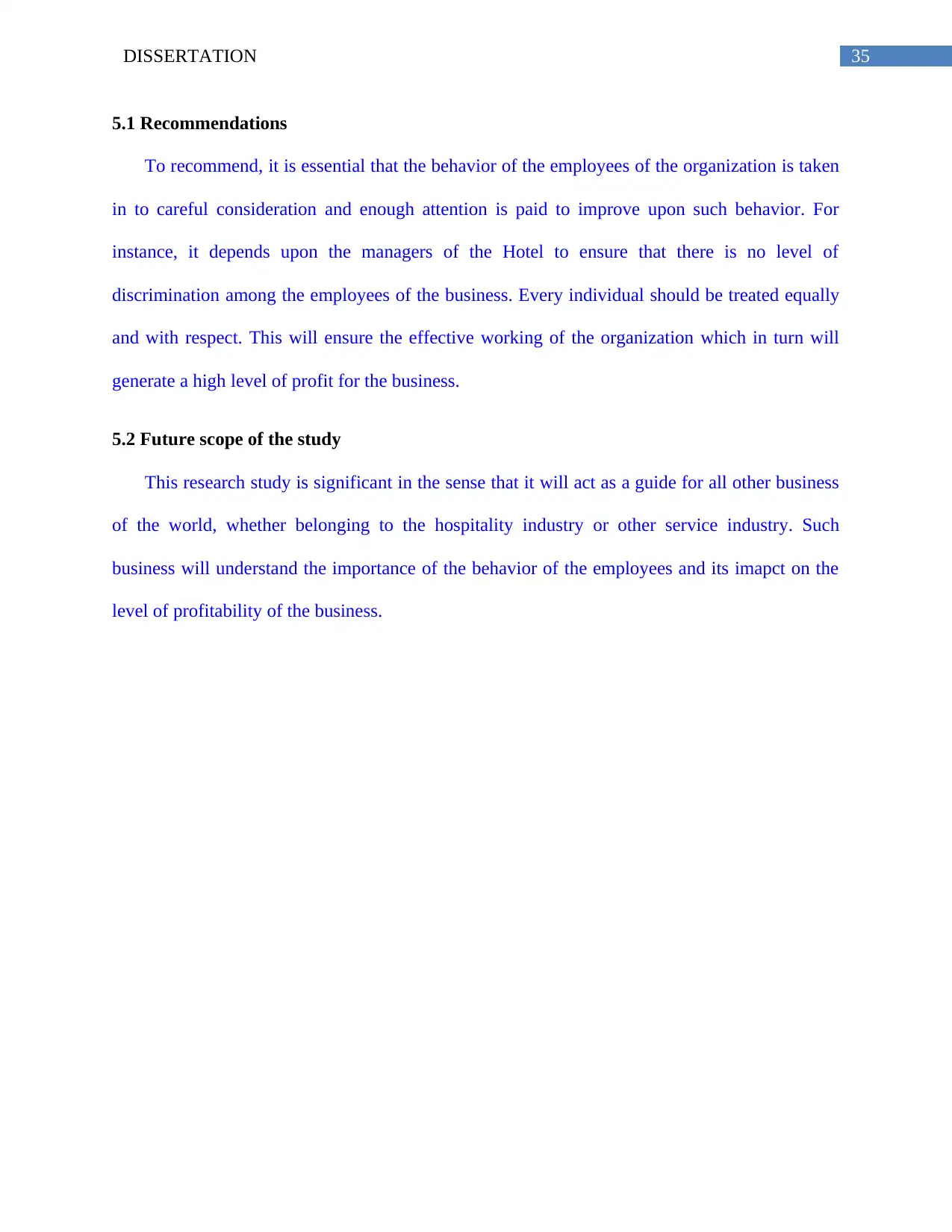
35DISSERTATION
5.1 Recommendations
To recommend, it is essential that the behavior of the employees of the organization is taken
in to careful consideration and enough attention is paid to improve upon such behavior. For
instance, it depends upon the managers of the Hotel to ensure that there is no level of
discrimination among the employees of the business. Every individual should be treated equally
and with respect. This will ensure the effective working of the organization which in turn will
generate a high level of profit for the business.
5.2 Future scope of the study
This research study is significant in the sense that it will act as a guide for all other business
of the world, whether belonging to the hospitality industry or other service industry. Such
business will understand the importance of the behavior of the employees and its imapct on the
level of profitability of the business.
5.1 Recommendations
To recommend, it is essential that the behavior of the employees of the organization is taken
in to careful consideration and enough attention is paid to improve upon such behavior. For
instance, it depends upon the managers of the Hotel to ensure that there is no level of
discrimination among the employees of the business. Every individual should be treated equally
and with respect. This will ensure the effective working of the organization which in turn will
generate a high level of profit for the business.
5.2 Future scope of the study
This research study is significant in the sense that it will act as a guide for all other business
of the world, whether belonging to the hospitality industry or other service industry. Such
business will understand the importance of the behavior of the employees and its imapct on the
level of profitability of the business.
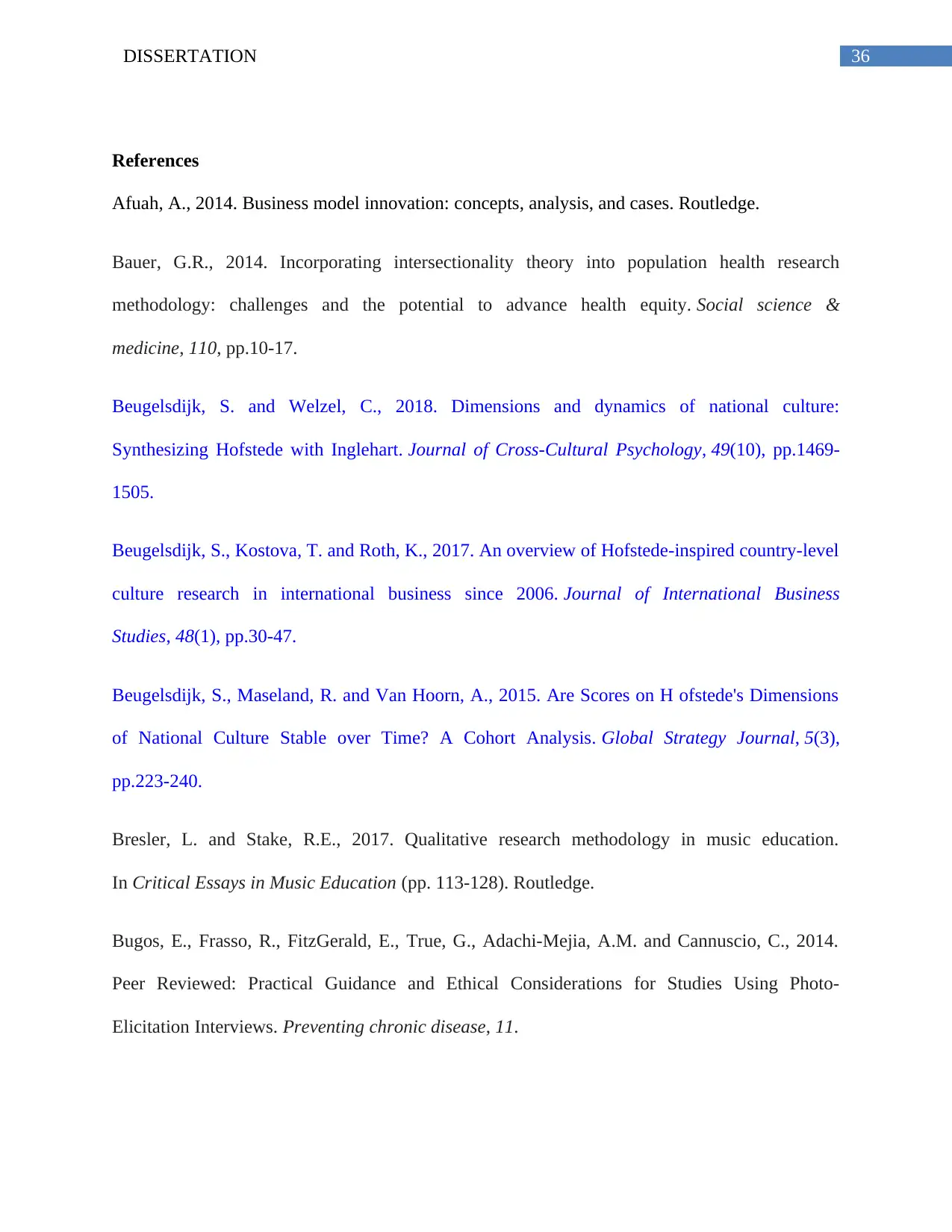
36DISSERTATION
References
Afuah, A., 2014. Business model innovation: concepts, analysis, and cases. Routledge.
Bauer, G.R., 2014. Incorporating intersectionality theory into population health research
methodology: challenges and the potential to advance health equity. Social science &
medicine, 110, pp.10-17.
Beugelsdijk, S. and Welzel, C., 2018. Dimensions and dynamics of national culture:
Synthesizing Hofstede with Inglehart. Journal of Cross-Cultural Psychology, 49(10), pp.1469-
1505.
Beugelsdijk, S., Kostova, T. and Roth, K., 2017. An overview of Hofstede-inspired country-level
culture research in international business since 2006. Journal of International Business
Studies, 48(1), pp.30-47.
Beugelsdijk, S., Maseland, R. and Van Hoorn, A., 2015. Are Scores on H ofstede's Dimensions
of National Culture Stable over Time? A Cohort Analysis. Global Strategy Journal, 5(3),
pp.223-240.
Bresler, L. and Stake, R.E., 2017. Qualitative research methodology in music education.
In Critical Essays in Music Education (pp. 113-128). Routledge.
Bugos, E., Frasso, R., FitzGerald, E., True, G., Adachi-Mejia, A.M. and Cannuscio, C., 2014.
Peer Reviewed: Practical Guidance and Ethical Considerations for Studies Using Photo-
Elicitation Interviews. Preventing chronic disease, 11.
References
Afuah, A., 2014. Business model innovation: concepts, analysis, and cases. Routledge.
Bauer, G.R., 2014. Incorporating intersectionality theory into population health research
methodology: challenges and the potential to advance health equity. Social science &
medicine, 110, pp.10-17.
Beugelsdijk, S. and Welzel, C., 2018. Dimensions and dynamics of national culture:
Synthesizing Hofstede with Inglehart. Journal of Cross-Cultural Psychology, 49(10), pp.1469-
1505.
Beugelsdijk, S., Kostova, T. and Roth, K., 2017. An overview of Hofstede-inspired country-level
culture research in international business since 2006. Journal of International Business
Studies, 48(1), pp.30-47.
Beugelsdijk, S., Maseland, R. and Van Hoorn, A., 2015. Are Scores on H ofstede's Dimensions
of National Culture Stable over Time? A Cohort Analysis. Global Strategy Journal, 5(3),
pp.223-240.
Bresler, L. and Stake, R.E., 2017. Qualitative research methodology in music education.
In Critical Essays in Music Education (pp. 113-128). Routledge.
Bugos, E., Frasso, R., FitzGerald, E., True, G., Adachi-Mejia, A.M. and Cannuscio, C., 2014.
Peer Reviewed: Practical Guidance and Ethical Considerations for Studies Using Photo-
Elicitation Interviews. Preventing chronic disease, 11.
Paraphrase This Document
Need a fresh take? Get an instant paraphrase of this document with our AI Paraphraser
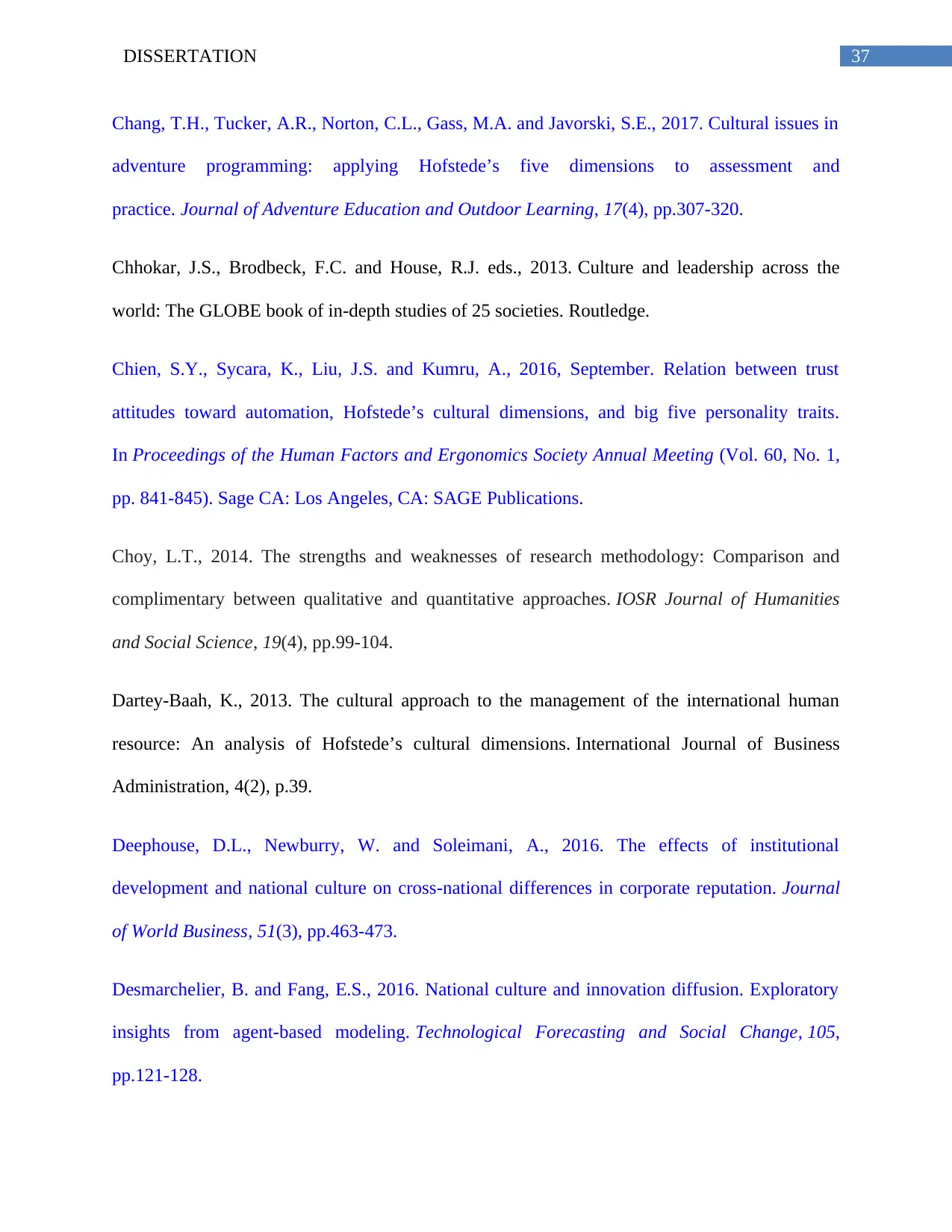
37DISSERTATION
Chang, T.H., Tucker, A.R., Norton, C.L., Gass, M.A. and Javorski, S.E., 2017. Cultural issues in
adventure programming: applying Hofstede’s five dimensions to assessment and
practice. Journal of Adventure Education and Outdoor Learning, 17(4), pp.307-320.
Chhokar, J.S., Brodbeck, F.C. and House, R.J. eds., 2013. Culture and leadership across the
world: The GLOBE book of in-depth studies of 25 societies. Routledge.
Chien, S.Y., Sycara, K., Liu, J.S. and Kumru, A., 2016, September. Relation between trust
attitudes toward automation, Hofstede’s cultural dimensions, and big five personality traits.
In Proceedings of the Human Factors and Ergonomics Society Annual Meeting (Vol. 60, No. 1,
pp. 841-845). Sage CA: Los Angeles, CA: SAGE Publications.
Choy, L.T., 2014. The strengths and weaknesses of research methodology: Comparison and
complimentary between qualitative and quantitative approaches. IOSR Journal of Humanities
and Social Science, 19(4), pp.99-104.
Dartey-Baah, K., 2013. The cultural approach to the management of the international human
resource: An analysis of Hofstede’s cultural dimensions. International Journal of Business
Administration, 4(2), p.39.
Deephouse, D.L., Newburry, W. and Soleimani, A., 2016. The effects of institutional
development and national culture on cross-national differences in corporate reputation. Journal
of World Business, 51(3), pp.463-473.
Desmarchelier, B. and Fang, E.S., 2016. National culture and innovation diffusion. Exploratory
insights from agent-based modeling. Technological Forecasting and Social Change, 105,
pp.121-128.
Chang, T.H., Tucker, A.R., Norton, C.L., Gass, M.A. and Javorski, S.E., 2017. Cultural issues in
adventure programming: applying Hofstede’s five dimensions to assessment and
practice. Journal of Adventure Education and Outdoor Learning, 17(4), pp.307-320.
Chhokar, J.S., Brodbeck, F.C. and House, R.J. eds., 2013. Culture and leadership across the
world: The GLOBE book of in-depth studies of 25 societies. Routledge.
Chien, S.Y., Sycara, K., Liu, J.S. and Kumru, A., 2016, September. Relation between trust
attitudes toward automation, Hofstede’s cultural dimensions, and big five personality traits.
In Proceedings of the Human Factors and Ergonomics Society Annual Meeting (Vol. 60, No. 1,
pp. 841-845). Sage CA: Los Angeles, CA: SAGE Publications.
Choy, L.T., 2014. The strengths and weaknesses of research methodology: Comparison and
complimentary between qualitative and quantitative approaches. IOSR Journal of Humanities
and Social Science, 19(4), pp.99-104.
Dartey-Baah, K., 2013. The cultural approach to the management of the international human
resource: An analysis of Hofstede’s cultural dimensions. International Journal of Business
Administration, 4(2), p.39.
Deephouse, D.L., Newburry, W. and Soleimani, A., 2016. The effects of institutional
development and national culture on cross-national differences in corporate reputation. Journal
of World Business, 51(3), pp.463-473.
Desmarchelier, B. and Fang, E.S., 2016. National culture and innovation diffusion. Exploratory
insights from agent-based modeling. Technological Forecasting and Social Change, 105,
pp.121-128.

38DISSERTATION
Enqvist, J., Graham, M. and Nikkinen, J., 2014. The impact of working capital management on
firm profitability in different business cycles: Evidence from Finland. Research in International
Business and Finance, 32, pp.36-49.
Farzipoor Saen, R., 2013. Using cluster analysis and DEA-discriminant analysis to predict group
membership of new customers. International Journal of Business Excellence, 6(3), pp.348-360.
Favaretto, R.M., Dihl, L., Barreto, R. and Musse, S.R., 2016, September. Using group behaviors
to detect hofstede cultural dimensions. In 2016 IEEE International Conference on Image
Processing (ICIP) (pp. 2936-2940). IEEE.
Flick, U., 2015. Introducing research methodology: A beginner's guide to doing a research
project. Sage.
Garnefeld, I., Eggert, A., Helm, S.V. and Tax, S.S., 2013. Growing existing customers' revenue
streams through customer referral programs. Journal of Marketing, 77(4), pp.17-32.
Hill, N. and Alexander, J., 2017. The handbook of customer satisfaction and loyalty
measurement. Routledge.
Hofstede, G., 2017. Why is culture so important?.
Huang, S.S. and Crotts, J., 2019. Relationships between Hofstede's cultural dimensions and
tourist satisfaction: A cross-country cross-sample examination. Tourism Management, 72,
pp.232-241.
Isaacs, A.N., 2014. An overview of qualitative research methodology for public health
researchers. International Journal of Medicine and Public Health, 4(4).
Enqvist, J., Graham, M. and Nikkinen, J., 2014. The impact of working capital management on
firm profitability in different business cycles: Evidence from Finland. Research in International
Business and Finance, 32, pp.36-49.
Farzipoor Saen, R., 2013. Using cluster analysis and DEA-discriminant analysis to predict group
membership of new customers. International Journal of Business Excellence, 6(3), pp.348-360.
Favaretto, R.M., Dihl, L., Barreto, R. and Musse, S.R., 2016, September. Using group behaviors
to detect hofstede cultural dimensions. In 2016 IEEE International Conference on Image
Processing (ICIP) (pp. 2936-2940). IEEE.
Flick, U., 2015. Introducing research methodology: A beginner's guide to doing a research
project. Sage.
Garnefeld, I., Eggert, A., Helm, S.V. and Tax, S.S., 2013. Growing existing customers' revenue
streams through customer referral programs. Journal of Marketing, 77(4), pp.17-32.
Hill, N. and Alexander, J., 2017. The handbook of customer satisfaction and loyalty
measurement. Routledge.
Hofstede, G., 2017. Why is culture so important?.
Huang, S.S. and Crotts, J., 2019. Relationships between Hofstede's cultural dimensions and
tourist satisfaction: A cross-country cross-sample examination. Tourism Management, 72,
pp.232-241.
Isaacs, A.N., 2014. An overview of qualitative research methodology for public health
researchers. International Journal of Medicine and Public Health, 4(4).
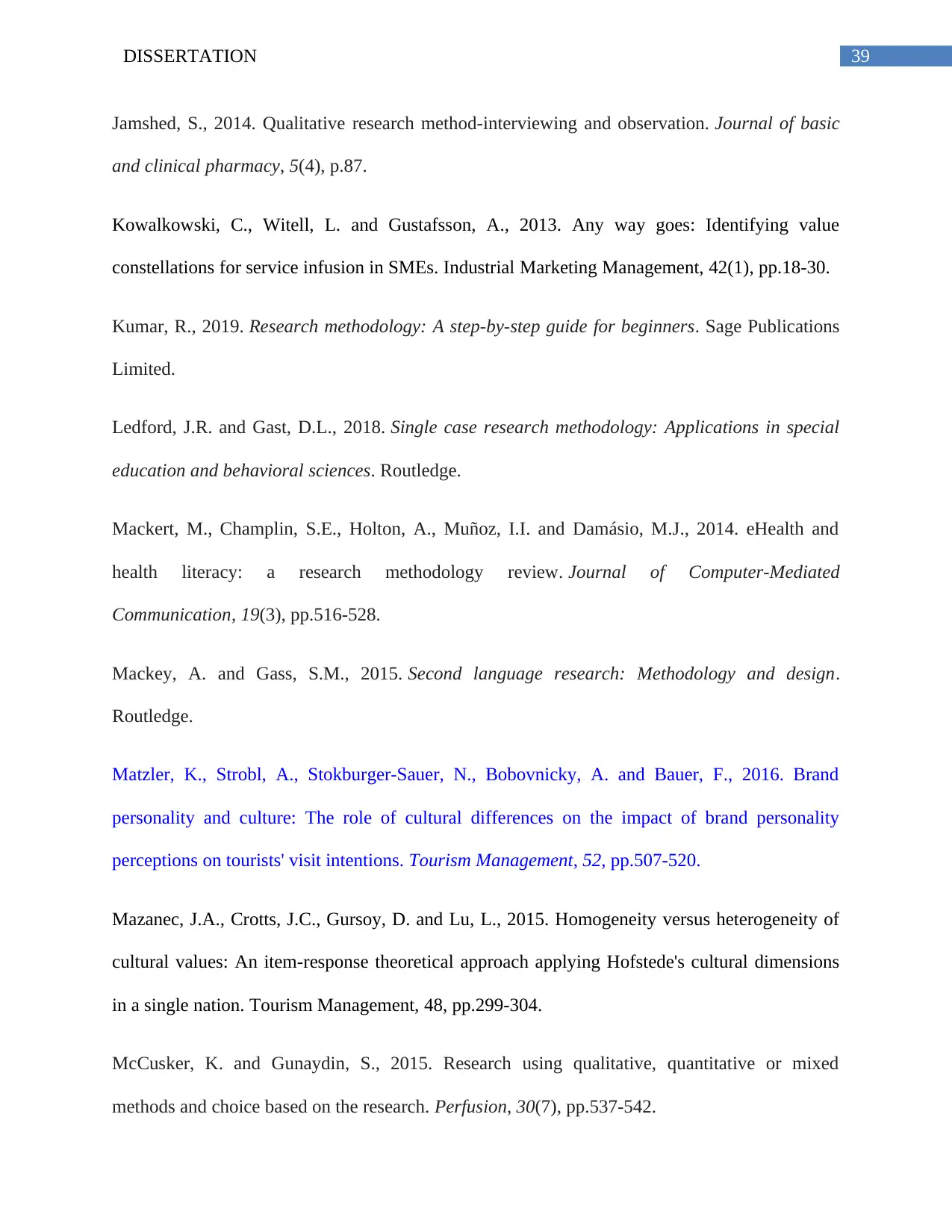
39DISSERTATION
Jamshed, S., 2014. Qualitative research method-interviewing and observation. Journal of basic
and clinical pharmacy, 5(4), p.87.
Kowalkowski, C., Witell, L. and Gustafsson, A., 2013. Any way goes: Identifying value
constellations for service infusion in SMEs. Industrial Marketing Management, 42(1), pp.18-30.
Kumar, R., 2019. Research methodology: A step-by-step guide for beginners. Sage Publications
Limited.
Ledford, J.R. and Gast, D.L., 2018. Single case research methodology: Applications in special
education and behavioral sciences. Routledge.
Mackert, M., Champlin, S.E., Holton, A., Muñoz, I.I. and Damásio, M.J., 2014. eHealth and
health literacy: a research methodology review. Journal of Computer-Mediated
Communication, 19(3), pp.516-528.
Mackey, A. and Gass, S.M., 2015. Second language research: Methodology and design.
Routledge.
Matzler, K., Strobl, A., Stokburger-Sauer, N., Bobovnicky, A. and Bauer, F., 2016. Brand
personality and culture: The role of cultural differences on the impact of brand personality
perceptions on tourists' visit intentions. Tourism Management, 52, pp.507-520.
Mazanec, J.A., Crotts, J.C., Gursoy, D. and Lu, L., 2015. Homogeneity versus heterogeneity of
cultural values: An item-response theoretical approach applying Hofstede's cultural dimensions
in a single nation. Tourism Management, 48, pp.299-304.
McCusker, K. and Gunaydin, S., 2015. Research using qualitative, quantitative or mixed
methods and choice based on the research. Perfusion, 30(7), pp.537-542.
Jamshed, S., 2014. Qualitative research method-interviewing and observation. Journal of basic
and clinical pharmacy, 5(4), p.87.
Kowalkowski, C., Witell, L. and Gustafsson, A., 2013. Any way goes: Identifying value
constellations for service infusion in SMEs. Industrial Marketing Management, 42(1), pp.18-30.
Kumar, R., 2019. Research methodology: A step-by-step guide for beginners. Sage Publications
Limited.
Ledford, J.R. and Gast, D.L., 2018. Single case research methodology: Applications in special
education and behavioral sciences. Routledge.
Mackert, M., Champlin, S.E., Holton, A., Muñoz, I.I. and Damásio, M.J., 2014. eHealth and
health literacy: a research methodology review. Journal of Computer-Mediated
Communication, 19(3), pp.516-528.
Mackey, A. and Gass, S.M., 2015. Second language research: Methodology and design.
Routledge.
Matzler, K., Strobl, A., Stokburger-Sauer, N., Bobovnicky, A. and Bauer, F., 2016. Brand
personality and culture: The role of cultural differences on the impact of brand personality
perceptions on tourists' visit intentions. Tourism Management, 52, pp.507-520.
Mazanec, J.A., Crotts, J.C., Gursoy, D. and Lu, L., 2015. Homogeneity versus heterogeneity of
cultural values: An item-response theoretical approach applying Hofstede's cultural dimensions
in a single nation. Tourism Management, 48, pp.299-304.
McCusker, K. and Gunaydin, S., 2015. Research using qualitative, quantitative or mixed
methods and choice based on the research. Perfusion, 30(7), pp.537-542.
Secure Best Marks with AI Grader
Need help grading? Try our AI Grader for instant feedback on your assignments.
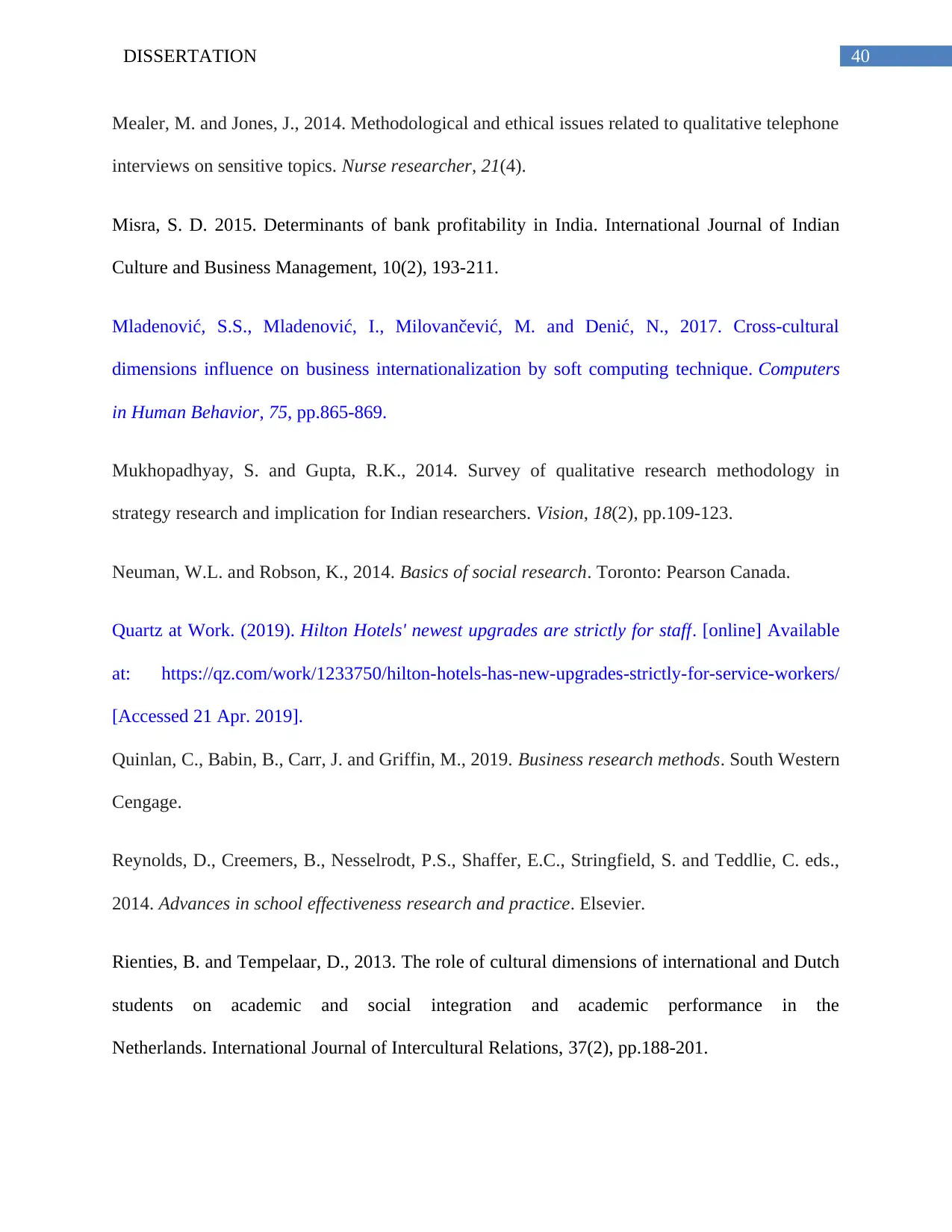
40DISSERTATION
Mealer, M. and Jones, J., 2014. Methodological and ethical issues related to qualitative telephone
interviews on sensitive topics. Nurse researcher, 21(4).
Misra, S. D. 2015. Determinants of bank profitability in India. International Journal of Indian
Culture and Business Management, 10(2), 193-211.
Mladenović, S.S., Mladenović, I., Milovančević, M. and Denić, N., 2017. Cross-cultural
dimensions influence on business internationalization by soft computing technique. Computers
in Human Behavior, 75, pp.865-869.
Mukhopadhyay, S. and Gupta, R.K., 2014. Survey of qualitative research methodology in
strategy research and implication for Indian researchers. Vision, 18(2), pp.109-123.
Neuman, W.L. and Robson, K., 2014. Basics of social research. Toronto: Pearson Canada.
Quartz at Work. (2019). Hilton Hotels' newest upgrades are strictly for staff. [online] Available
at: https://qz.com/work/1233750/hilton-hotels-has-new-upgrades-strictly-for-service-workers/
[Accessed 21 Apr. 2019].
Quinlan, C., Babin, B., Carr, J. and Griffin, M., 2019. Business research methods. South Western
Cengage.
Reynolds, D., Creemers, B., Nesselrodt, P.S., Shaffer, E.C., Stringfield, S. and Teddlie, C. eds.,
2014. Advances in school effectiveness research and practice. Elsevier.
Rienties, B. and Tempelaar, D., 2013. The role of cultural dimensions of international and Dutch
students on academic and social integration and academic performance in the
Netherlands. International Journal of Intercultural Relations, 37(2), pp.188-201.
Mealer, M. and Jones, J., 2014. Methodological and ethical issues related to qualitative telephone
interviews on sensitive topics. Nurse researcher, 21(4).
Misra, S. D. 2015. Determinants of bank profitability in India. International Journal of Indian
Culture and Business Management, 10(2), 193-211.
Mladenović, S.S., Mladenović, I., Milovančević, M. and Denić, N., 2017. Cross-cultural
dimensions influence on business internationalization by soft computing technique. Computers
in Human Behavior, 75, pp.865-869.
Mukhopadhyay, S. and Gupta, R.K., 2014. Survey of qualitative research methodology in
strategy research and implication for Indian researchers. Vision, 18(2), pp.109-123.
Neuman, W.L. and Robson, K., 2014. Basics of social research. Toronto: Pearson Canada.
Quartz at Work. (2019). Hilton Hotels' newest upgrades are strictly for staff. [online] Available
at: https://qz.com/work/1233750/hilton-hotels-has-new-upgrades-strictly-for-service-workers/
[Accessed 21 Apr. 2019].
Quinlan, C., Babin, B., Carr, J. and Griffin, M., 2019. Business research methods. South Western
Cengage.
Reynolds, D., Creemers, B., Nesselrodt, P.S., Shaffer, E.C., Stringfield, S. and Teddlie, C. eds.,
2014. Advances in school effectiveness research and practice. Elsevier.
Rienties, B. and Tempelaar, D., 2013. The role of cultural dimensions of international and Dutch
students on academic and social integration and academic performance in the
Netherlands. International Journal of Intercultural Relations, 37(2), pp.188-201.
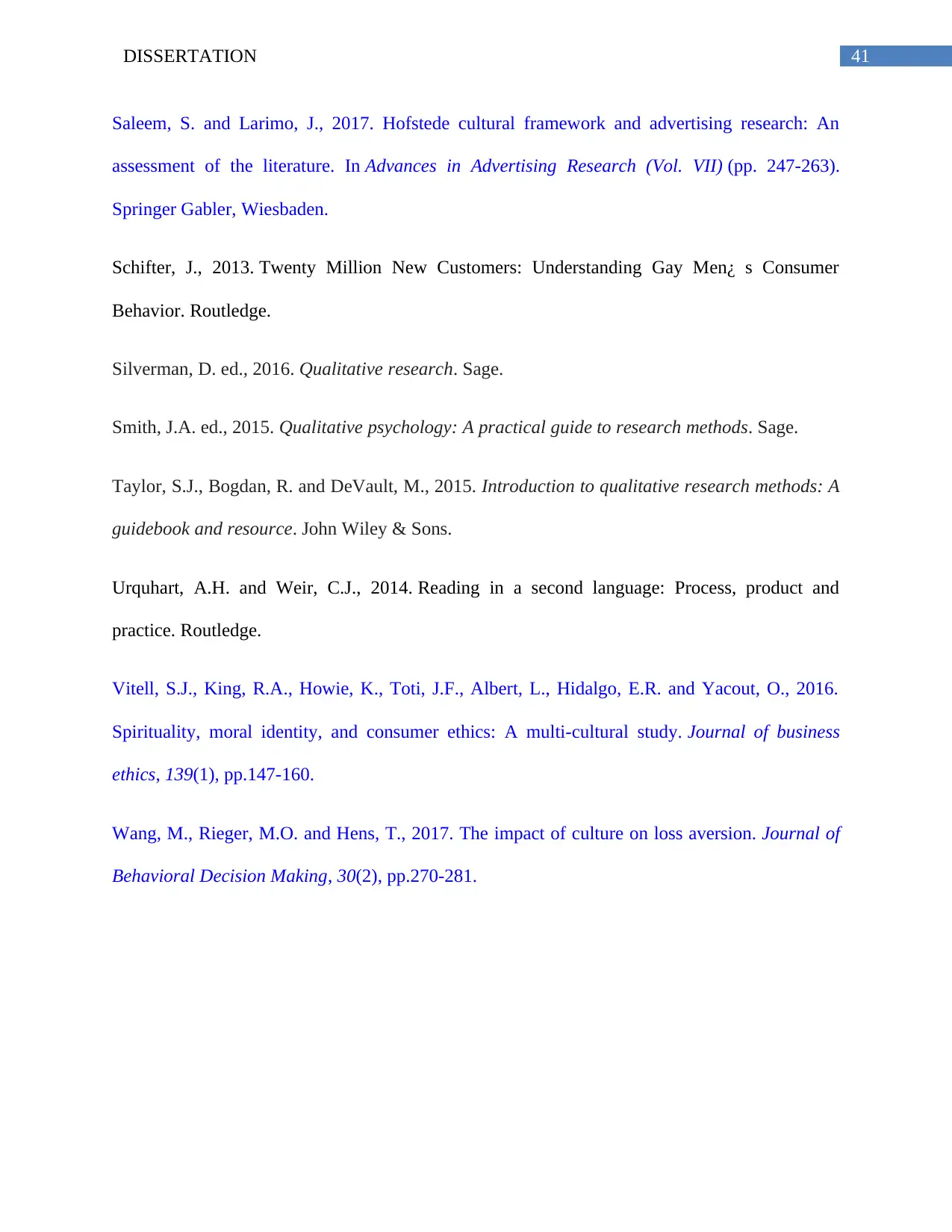
41DISSERTATION
Saleem, S. and Larimo, J., 2017. Hofstede cultural framework and advertising research: An
assessment of the literature. In Advances in Advertising Research (Vol. VII) (pp. 247-263).
Springer Gabler, Wiesbaden.
Schifter, J., 2013. Twenty Million New Customers: Understanding Gay Men¿ s Consumer
Behavior. Routledge.
Silverman, D. ed., 2016. Qualitative research. Sage.
Smith, J.A. ed., 2015. Qualitative psychology: A practical guide to research methods. Sage.
Taylor, S.J., Bogdan, R. and DeVault, M., 2015. Introduction to qualitative research methods: A
guidebook and resource. John Wiley & Sons.
Urquhart, A.H. and Weir, C.J., 2014. Reading in a second language: Process, product and
practice. Routledge.
Vitell, S.J., King, R.A., Howie, K., Toti, J.F., Albert, L., Hidalgo, E.R. and Yacout, O., 2016.
Spirituality, moral identity, and consumer ethics: A multi-cultural study. Journal of business
ethics, 139(1), pp.147-160.
Wang, M., Rieger, M.O. and Hens, T., 2017. The impact of culture on loss aversion. Journal of
Behavioral Decision Making, 30(2), pp.270-281.
Saleem, S. and Larimo, J., 2017. Hofstede cultural framework and advertising research: An
assessment of the literature. In Advances in Advertising Research (Vol. VII) (pp. 247-263).
Springer Gabler, Wiesbaden.
Schifter, J., 2013. Twenty Million New Customers: Understanding Gay Men¿ s Consumer
Behavior. Routledge.
Silverman, D. ed., 2016. Qualitative research. Sage.
Smith, J.A. ed., 2015. Qualitative psychology: A practical guide to research methods. Sage.
Taylor, S.J., Bogdan, R. and DeVault, M., 2015. Introduction to qualitative research methods: A
guidebook and resource. John Wiley & Sons.
Urquhart, A.H. and Weir, C.J., 2014. Reading in a second language: Process, product and
practice. Routledge.
Vitell, S.J., King, R.A., Howie, K., Toti, J.F., Albert, L., Hidalgo, E.R. and Yacout, O., 2016.
Spirituality, moral identity, and consumer ethics: A multi-cultural study. Journal of business
ethics, 139(1), pp.147-160.
Wang, M., Rieger, M.O. and Hens, T., 2017. The impact of culture on loss aversion. Journal of
Behavioral Decision Making, 30(2), pp.270-281.
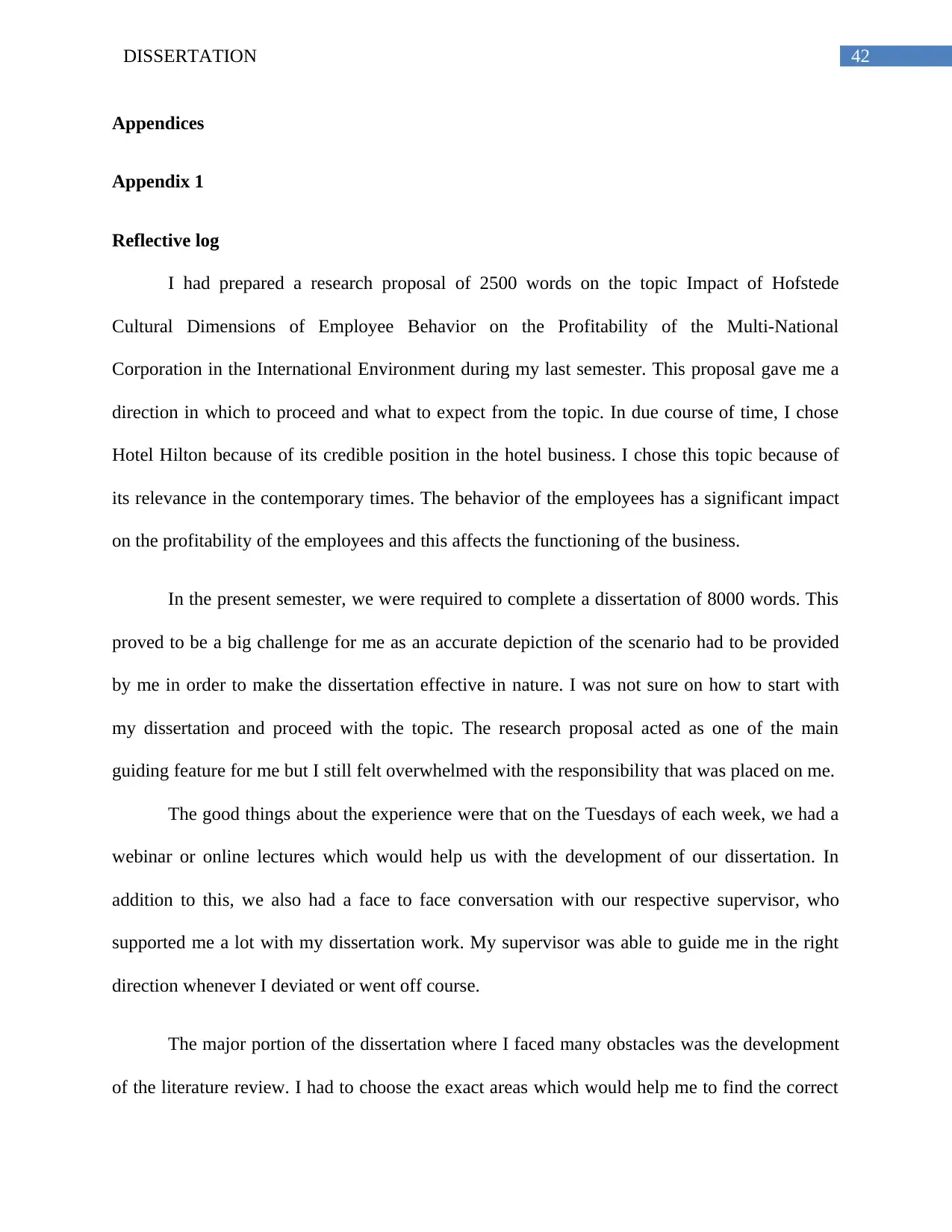
42DISSERTATION
Appendices
Appendix 1
Reflective log
I had prepared a research proposal of 2500 words on the topic Impact of Hofstede
Cultural Dimensions of Employee Behavior on the Profitability of the Multi-National
Corporation in the International Environment during my last semester. This proposal gave me a
direction in which to proceed and what to expect from the topic. In due course of time, I chose
Hotel Hilton because of its credible position in the hotel business. I chose this topic because of
its relevance in the contemporary times. The behavior of the employees has a significant impact
on the profitability of the employees and this affects the functioning of the business.
In the present semester, we were required to complete a dissertation of 8000 words. This
proved to be a big challenge for me as an accurate depiction of the scenario had to be provided
by me in order to make the dissertation effective in nature. I was not sure on how to start with
my dissertation and proceed with the topic. The research proposal acted as one of the main
guiding feature for me but I still felt overwhelmed with the responsibility that was placed on me.
The good things about the experience were that on the Tuesdays of each week, we had a
webinar or online lectures which would help us with the development of our dissertation. In
addition to this, we also had a face to face conversation with our respective supervisor, who
supported me a lot with my dissertation work. My supervisor was able to guide me in the right
direction whenever I deviated or went off course.
The major portion of the dissertation where I faced many obstacles was the development
of the literature review. I had to choose the exact areas which would help me to find the correct
Appendices
Appendix 1
Reflective log
I had prepared a research proposal of 2500 words on the topic Impact of Hofstede
Cultural Dimensions of Employee Behavior on the Profitability of the Multi-National
Corporation in the International Environment during my last semester. This proposal gave me a
direction in which to proceed and what to expect from the topic. In due course of time, I chose
Hotel Hilton because of its credible position in the hotel business. I chose this topic because of
its relevance in the contemporary times. The behavior of the employees has a significant impact
on the profitability of the employees and this affects the functioning of the business.
In the present semester, we were required to complete a dissertation of 8000 words. This
proved to be a big challenge for me as an accurate depiction of the scenario had to be provided
by me in order to make the dissertation effective in nature. I was not sure on how to start with
my dissertation and proceed with the topic. The research proposal acted as one of the main
guiding feature for me but I still felt overwhelmed with the responsibility that was placed on me.
The good things about the experience were that on the Tuesdays of each week, we had a
webinar or online lectures which would help us with the development of our dissertation. In
addition to this, we also had a face to face conversation with our respective supervisor, who
supported me a lot with my dissertation work. My supervisor was able to guide me in the right
direction whenever I deviated or went off course.
The major portion of the dissertation where I faced many obstacles was the development
of the literature review. I had to choose the exact areas which would help me to find the correct
Paraphrase This Document
Need a fresh take? Get an instant paraphrase of this document with our AI Paraphraser
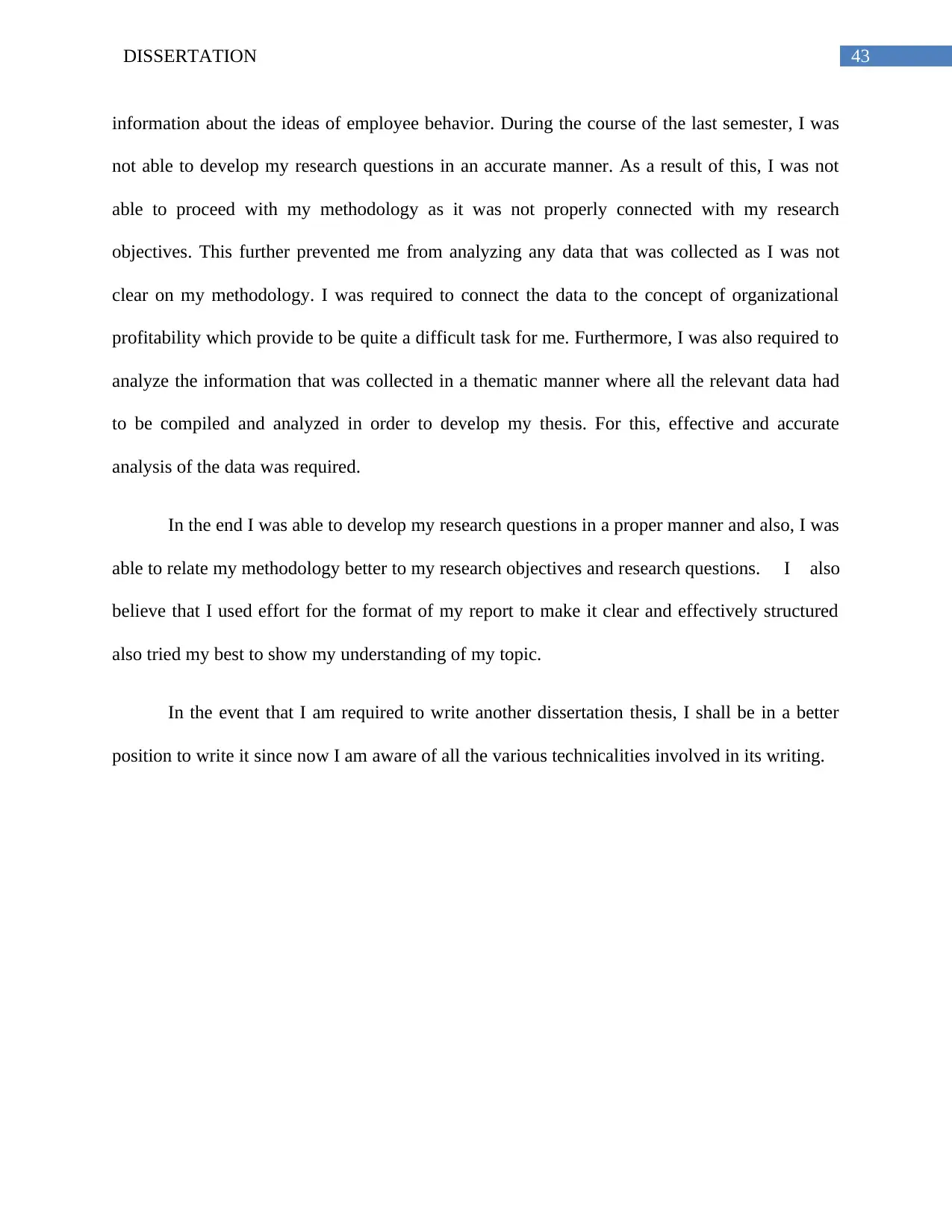
43DISSERTATION
information about the ideas of employee behavior. During the course of the last semester, I was
not able to develop my research questions in an accurate manner. As a result of this, I was not
able to proceed with my methodology as it was not properly connected with my research
objectives. This further prevented me from analyzing any data that was collected as I was not
clear on my methodology. I was required to connect the data to the concept of organizational
profitability which provide to be quite a difficult task for me. Furthermore, I was also required to
analyze the information that was collected in a thematic manner where all the relevant data had
to be compiled and analyzed in order to develop my thesis. For this, effective and accurate
analysis of the data was required.
In the end I was able to develop my research questions in a proper manner and also, I was
able to relate my methodology better to my research objectives and research questions. I also
believe that I used effort for the format of my report to make it clear and effectively structured
also tried my best to show my understanding of my topic.
In the event that I am required to write another dissertation thesis, I shall be in a better
position to write it since now I am aware of all the various technicalities involved in its writing.
information about the ideas of employee behavior. During the course of the last semester, I was
not able to develop my research questions in an accurate manner. As a result of this, I was not
able to proceed with my methodology as it was not properly connected with my research
objectives. This further prevented me from analyzing any data that was collected as I was not
clear on my methodology. I was required to connect the data to the concept of organizational
profitability which provide to be quite a difficult task for me. Furthermore, I was also required to
analyze the information that was collected in a thematic manner where all the relevant data had
to be compiled and analyzed in order to develop my thesis. For this, effective and accurate
analysis of the data was required.
In the end I was able to develop my research questions in a proper manner and also, I was
able to relate my methodology better to my research objectives and research questions. I also
believe that I used effort for the format of my report to make it clear and effectively structured
also tried my best to show my understanding of my topic.
In the event that I am required to write another dissertation thesis, I shall be in a better
position to write it since now I am aware of all the various technicalities involved in its writing.
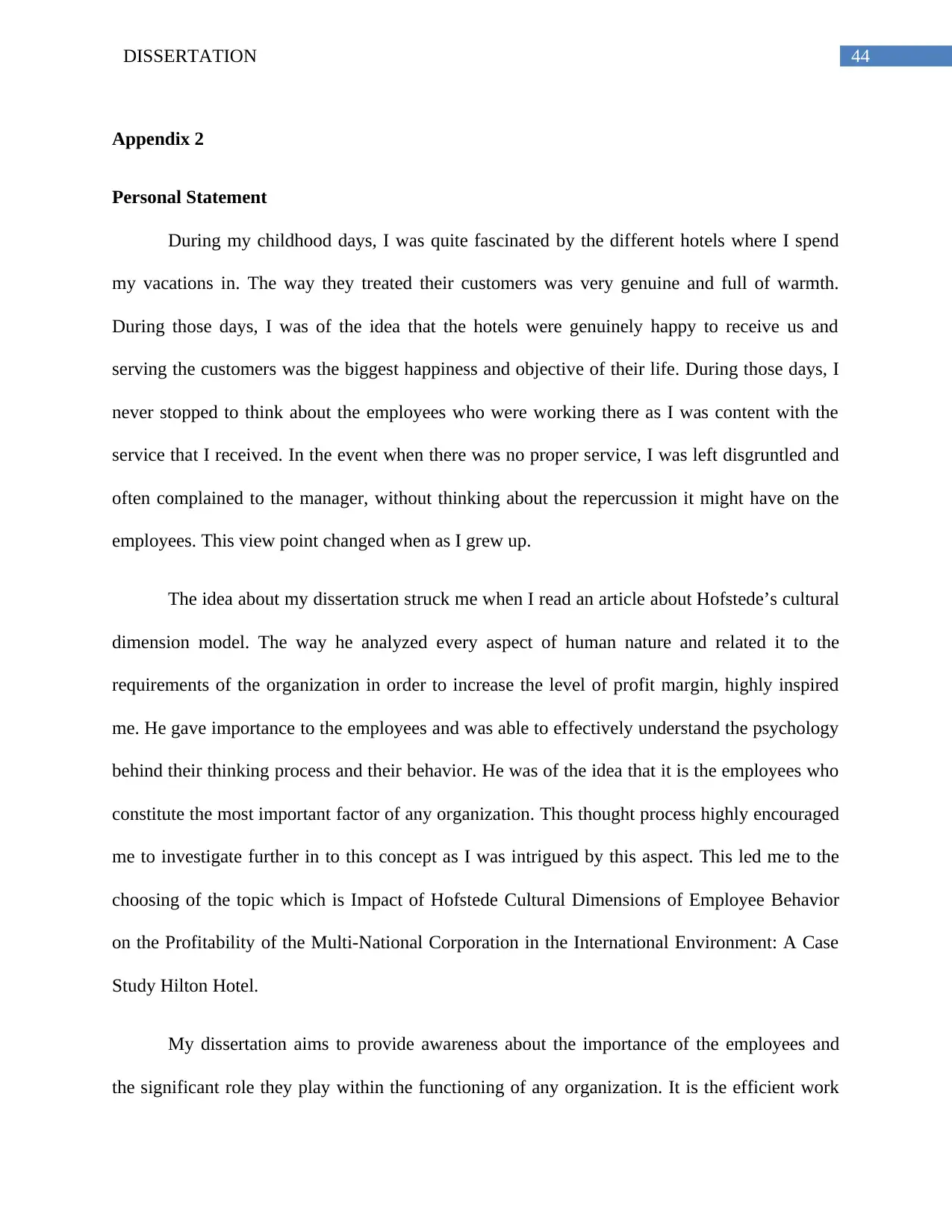
44DISSERTATION
Appendix 2
Personal Statement
During my childhood days, I was quite fascinated by the different hotels where I spend
my vacations in. The way they treated their customers was very genuine and full of warmth.
During those days, I was of the idea that the hotels were genuinely happy to receive us and
serving the customers was the biggest happiness and objective of their life. During those days, I
never stopped to think about the employees who were working there as I was content with the
service that I received. In the event when there was no proper service, I was left disgruntled and
often complained to the manager, without thinking about the repercussion it might have on the
employees. This view point changed when as I grew up.
The idea about my dissertation struck me when I read an article about Hofstede’s cultural
dimension model. The way he analyzed every aspect of human nature and related it to the
requirements of the organization in order to increase the level of profit margin, highly inspired
me. He gave importance to the employees and was able to effectively understand the psychology
behind their thinking process and their behavior. He was of the idea that it is the employees who
constitute the most important factor of any organization. This thought process highly encouraged
me to investigate further in to this concept as I was intrigued by this aspect. This led me to the
choosing of the topic which is Impact of Hofstede Cultural Dimensions of Employee Behavior
on the Profitability of the Multi-National Corporation in the International Environment: A Case
Study Hilton Hotel.
My dissertation aims to provide awareness about the importance of the employees and
the significant role they play within the functioning of any organization. It is the efficient work
Appendix 2
Personal Statement
During my childhood days, I was quite fascinated by the different hotels where I spend
my vacations in. The way they treated their customers was very genuine and full of warmth.
During those days, I was of the idea that the hotels were genuinely happy to receive us and
serving the customers was the biggest happiness and objective of their life. During those days, I
never stopped to think about the employees who were working there as I was content with the
service that I received. In the event when there was no proper service, I was left disgruntled and
often complained to the manager, without thinking about the repercussion it might have on the
employees. This view point changed when as I grew up.
The idea about my dissertation struck me when I read an article about Hofstede’s cultural
dimension model. The way he analyzed every aspect of human nature and related it to the
requirements of the organization in order to increase the level of profit margin, highly inspired
me. He gave importance to the employees and was able to effectively understand the psychology
behind their thinking process and their behavior. He was of the idea that it is the employees who
constitute the most important factor of any organization. This thought process highly encouraged
me to investigate further in to this concept as I was intrigued by this aspect. This led me to the
choosing of the topic which is Impact of Hofstede Cultural Dimensions of Employee Behavior
on the Profitability of the Multi-National Corporation in the International Environment: A Case
Study Hilton Hotel.
My dissertation aims to provide awareness about the importance of the employees and
the significant role they play within the functioning of any organization. It is the efficient work

45DISSERTATION
of the employees which determines the level of satisfaction of the customers, which, in
consequent, determines the level of organizational profitability. In the field of hotel management,
it is imperative that employees should be courteous and generous at all points of time. It is in this
regard, that the employees had garnered an important place in the analysis done by Hofstede.
The main objective of my dissertation is to make the other organizations recognize the
advantages of the employees. I want to improve the condition of the employees in their place of
work and ensure that they are receiving their worth in terms of wages and salaries and also other
benefits within such firms. The field of hotel management is dynamic in nature as it continuously
changes and evolves over time. As a result, my dissertation would prove to be useful to such
hotel managers who would want to stay at the top of their game for a considerable period of
time.
of the employees which determines the level of satisfaction of the customers, which, in
consequent, determines the level of organizational profitability. In the field of hotel management,
it is imperative that employees should be courteous and generous at all points of time. It is in this
regard, that the employees had garnered an important place in the analysis done by Hofstede.
The main objective of my dissertation is to make the other organizations recognize the
advantages of the employees. I want to improve the condition of the employees in their place of
work and ensure that they are receiving their worth in terms of wages and salaries and also other
benefits within such firms. The field of hotel management is dynamic in nature as it continuously
changes and evolves over time. As a result, my dissertation would prove to be useful to such
hotel managers who would want to stay at the top of their game for a considerable period of
time.
1 out of 46
Related Documents
Your All-in-One AI-Powered Toolkit for Academic Success.
+13062052269
info@desklib.com
Available 24*7 on WhatsApp / Email
![[object Object]](/_next/static/media/star-bottom.7253800d.svg)
Unlock your academic potential
© 2024 | Zucol Services PVT LTD | All rights reserved.





